Grand Teton Ski Descent via Ford Stettner
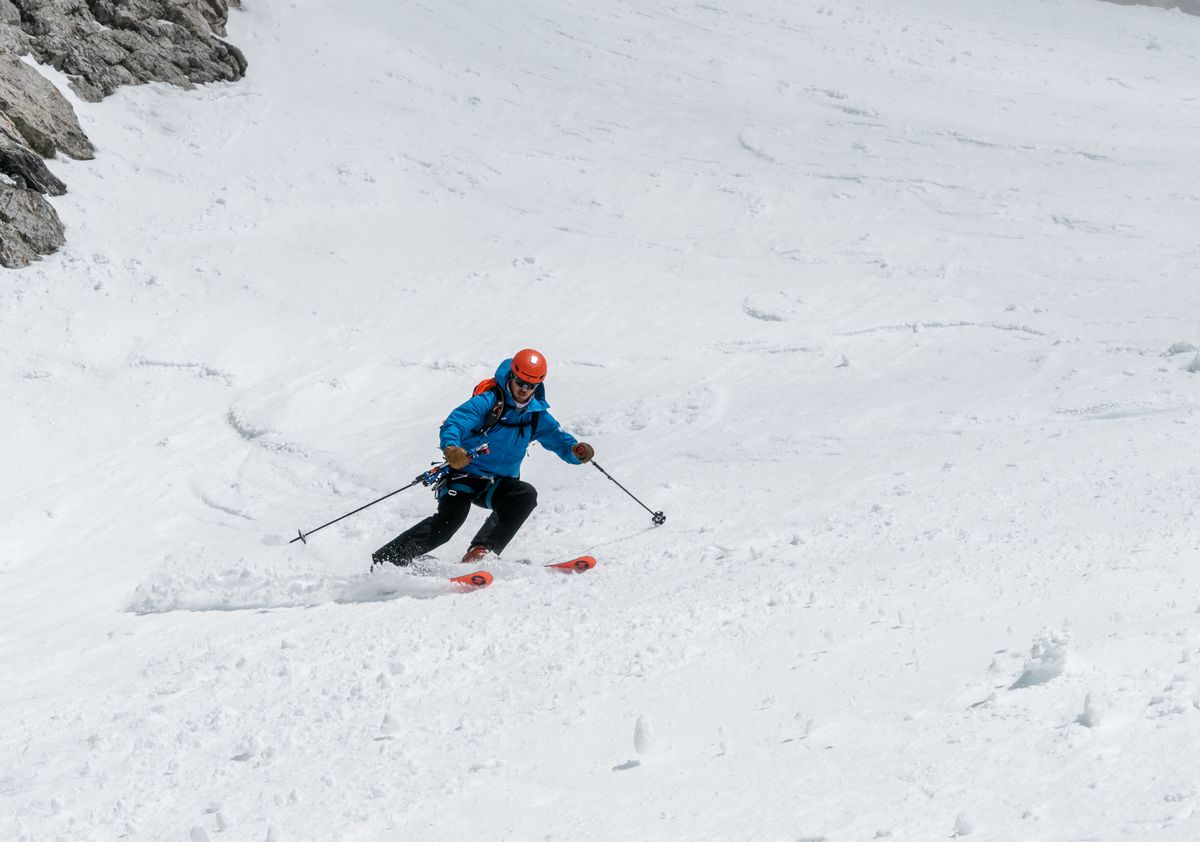
May 15, 2023:
- Ski descent of Grand Teton (13,775') following the Ford-Stettner route, a series of three couloirs on its south face, accessed from Teepe Glacier.
- Skin approach from the Park Road, intersecting the summer trail into Garnet Canyon, then switchbacks to Tepee Glacier.
- Boot-pack up Teepe Glacier, using ice tools and crampons to solo Stettner Couloir; roped ascent of Chevy Couloir's ice bulges, splitting our five-person team into two groups.
- Each team solo boot-packed up Ford Couloir, summited and descended.
- Multiple rappels through Chevy / Stettner Couloirs, then a slushy ski exit, alternating between hiking and skiing below Garnet Canyon.
- ~7,000' ascent and 15 miles round-trip over ~16 hours.
More fun from 2024:
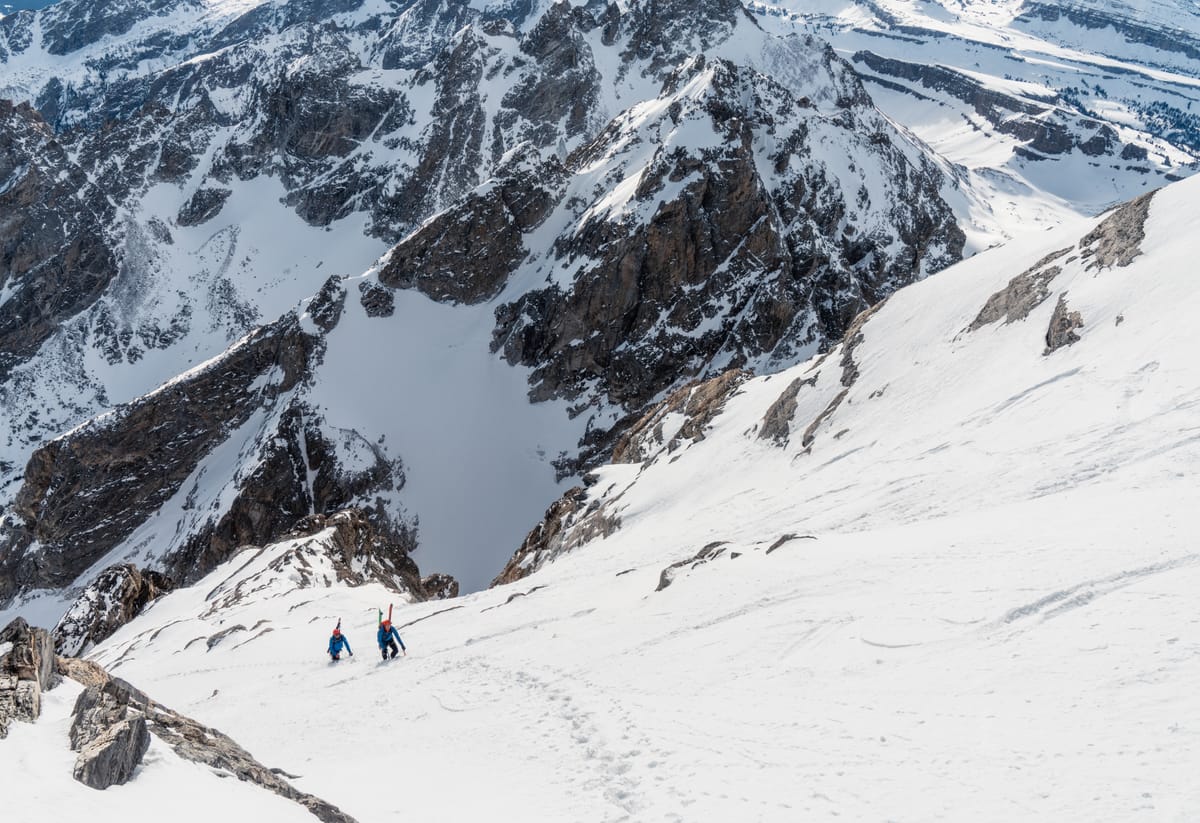
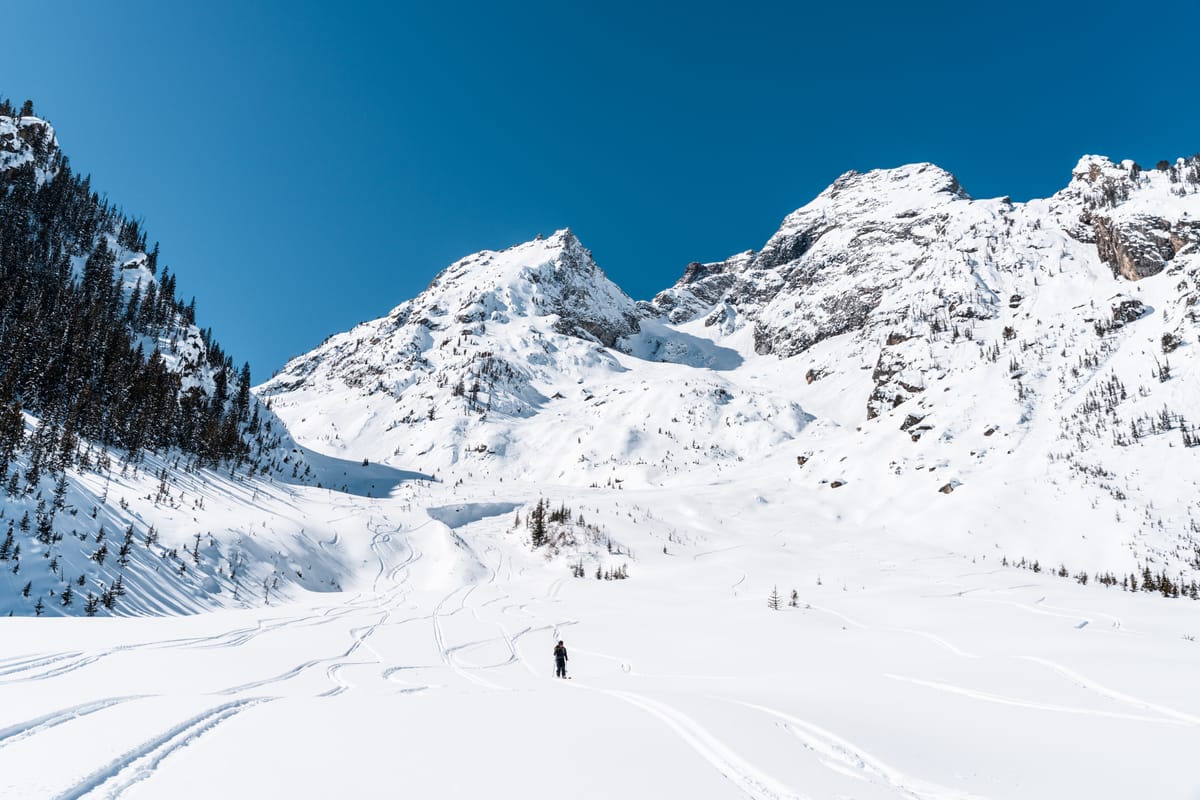
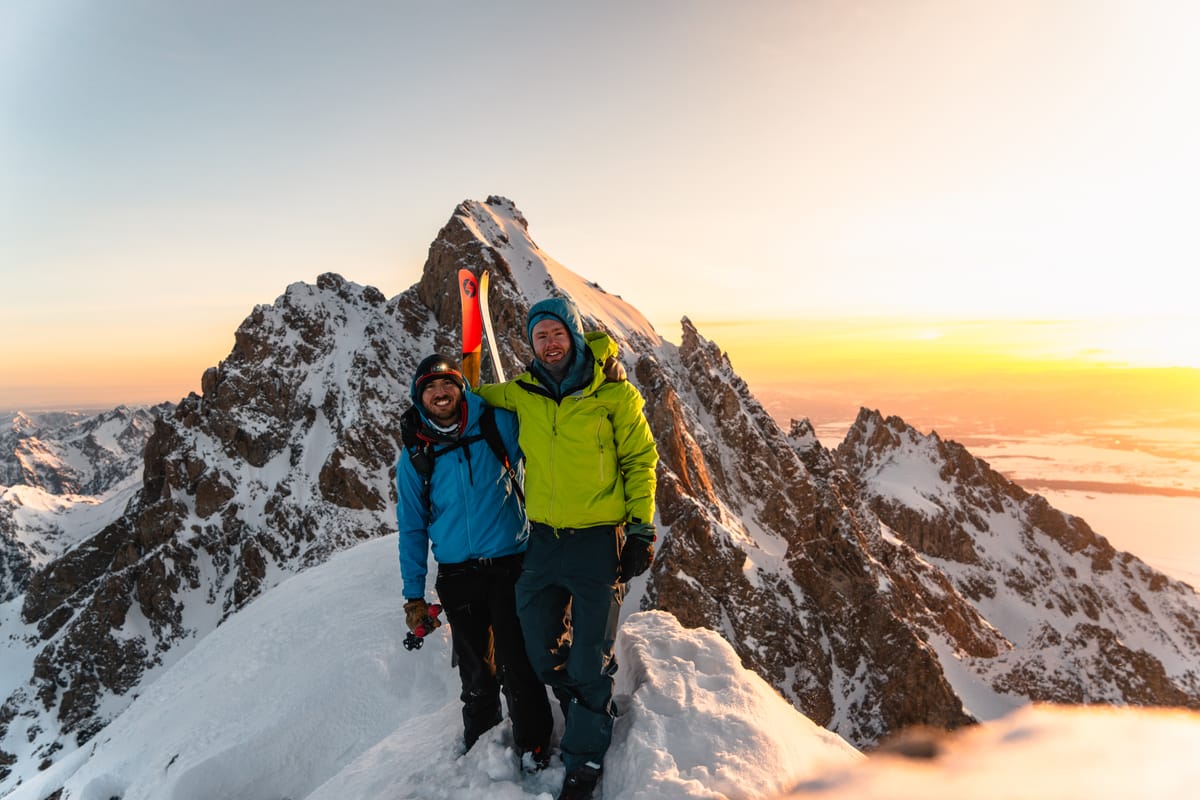
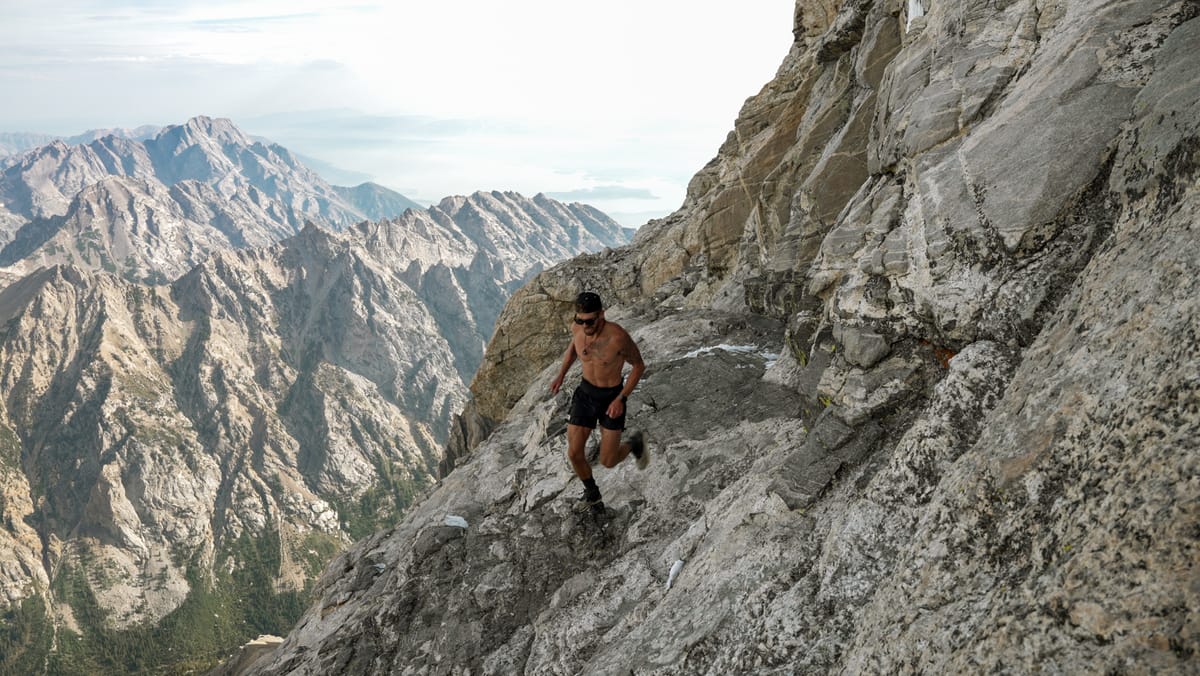
Note: I may get commissions for purchases from links in this post.
Background
Seed Planted
I moved to Jackson in 2020 thinking I was a decent skier. The first opening weekend at Jackson Hole Mountain Resort (JHMR or "the Resort") changed that perception, at least relative to Jackson skiers. Through winter 2020-21, I took my first avalanche course (Avy 1 with JHMG), learned how to ski powder and exited the JHMR side-country gates a handful of times.
When 2021-22 Jackson Hole passes came on sale, I opted for Mountain Collective, hoping to spend more time exploring the backcountry. At the time, my ambition spanned Teton Pass and maybe a few runs in Grand Teton, or "the Park."
That fall, I was chasing grizzly bears with a friend near Moran Junction. After watching a favorite sow – "Softie" as named by friends, Ben and Mirela – dig for an hour, we gazed south at the Tetons. My friend was an experienced backcountry skier. In my naiveté, I asked her if Grand Teton was skiable.
She said, "Oh some do... I don't think I will," (paraphrasing) with bemusement. I strained to imagine a route through the 1,000 foot cliffs guarding the summit. Maybe a Red Bull athlete with a parachute?
Later that week, I dropped by a property I managed. My subtenant was watching "The Fifty," Cody Townsend's quest to ski the Fifty Classic descents of North America, each mission available on YouTube. I asked if the Grand was on his list. We watched Cody's "Grand Teton with Jimmy Chin" episode, followed by Mt. Moran's "Skillet," another 50-classic in the Tetons.
A few days later, I flew back to Boston, where I spent most of fall 2021. I Googled the Grand descent, finding mark-ups of the Ford Stettner route. I hadn't skied proper couloirs yet, let alone climbed, but a seed was planted. I remember showing a mark-up of line to a friend with mountaineering experience at a happy hour a couple weeks later. He raised his eyebrows.
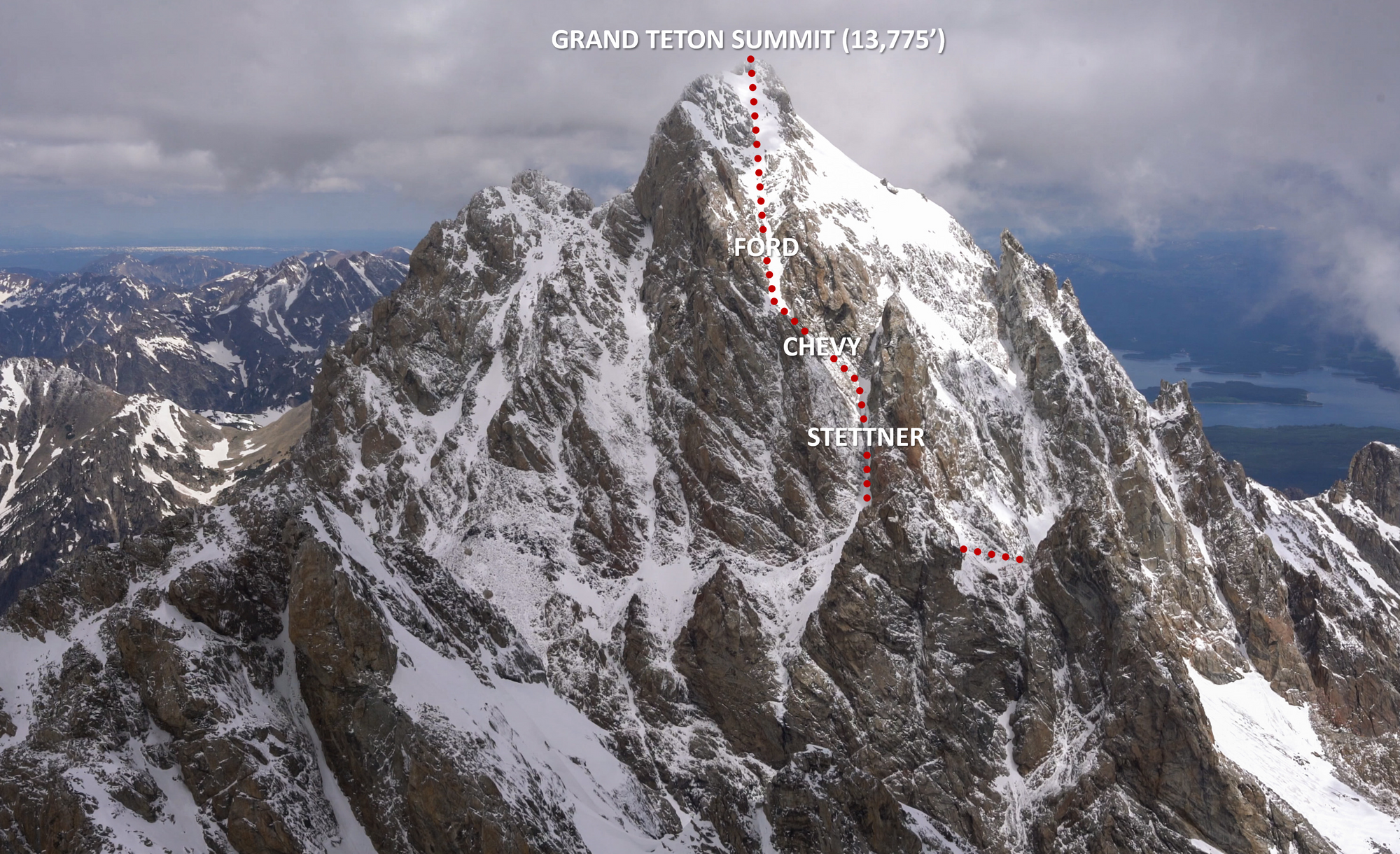
Pipedream to Attainable
In January 2022, I was back in Jackson. After a few drinks to celebrate a friend's birthday, I asked the birthday boy – a much better skier than me – if he'd join me on the Grand. He laughed and said, "You're not even close" (again, paraphrasing). If I was serious about skiing bigger lines, he could show me some routes on Teton Pass and maybe in the Park. In general, he wasn't interested in the Grand, certainly not with someone he'd have to worry about.
That same friend introduced me to Granite Canyon in winter 2020-21, my first venture outside JHMR gates. It was one of my first days skiing real powder and I sat backseat, thinking that's how it's done. Mid-way down a chute, I faceplanted. That summer (and the prior fall), I also joined him for a few hikes. Huffing and puffing on the uphill's, I struggled to keep pace.
The Grand seemed like an pipedream. Especially in light of a bad case of runner's knee that summer, limiting my cardio. But back in Jackson in January 2022, I chipped away at cardio base, ski skills and snow science. More on that winter's training in Skillet Part I: Training.
The season culminated in a Table Mountain tour and an attempt at the Skillet, stopping 1,000' short of the summit due to weather. On both tours, my legs trembled on the descent. My conditioning still wouldn't cut it in the high-consequence Ford Couloir.
Going into summer 2022, I lacked climbing and rope skills, both requirements for Ford-Stettner. In August and September, I completed my first alpine climbs, all easy, mid-fifth class routes like Owen Spalding, Upper Exum and CMC Face. I added to my cardio base on hill climbs, culminating in the Jackson Hole Marathon. And, I completed a Wilderness First Responder or WFR, pronounced wo͝ofʹər.
After Upper Exum, I discussed Ford-Stettner with my climbing partner, Zack. We met through the WFR that June. He shared my ambition, but had infinitely more experience with rope systems, rock / ice climbing and technical skiing. Zack's a Jackson native with connections to TCSAR and Exum.
For me, Ford-Stettner still seemed like a more reasonable winter 2023-24 goal. There was a narrow path for spring 2023, but I needed to become a better skier and expand knowledge of rope systems, ice climbing and snow science.
In October, I signed up for Jackson Hole's adaptive ski school part-time. My brother has cerebral palsy, so it's been on my list to contribute to an adaptive program. He participated in adaptive skiing, horseback riding and swimming, among other activities. Ski school leveled up my skiing, thanks to instructor clinics, extra days at the resort and practice tethering sit skis. (Some of my takeaways in this adaptive skiing article.)
In early January, I joined Zack to ski Apocalypse Couloir, often used to test candidates for Ford-Stettner. The route requires two entry rappels, and sometimes, a third through an icefall choke near the bottom. (Apocalypse was my first time integrating rope systems and skiing.)
Ski skills and rope knowledge improving, my last technical hurdle was ice climbing. To access Ford Couloir, parties climb a few ice bulges in Chevy Couloir.
Connor and I, who discussed Ford-Stettner on a few occasions, drove north to Hyalite Canyon, MT, to link up with my friend Xavier for a three-day bootcamp. Day one involved a few WI2-4 climbs. Day two linked a WI3 climb (Twin Falls) and tight couloir skiing (Pinner) to practice climbing with skis on back. Read the full trip report in Hyalite Ice.
Between the icefalls, hotel breakfasts and hot tub recoveries, we aligned with Xavier on a spring Ford-Stettner attempt. A third in the party would boost motivation through (mostly) healthy peer pressure.
Xavier and his youngest brother, Sebastian, attempted Ford-Stettner three times, repeatedly turned around by conditions. Xavier had a score to settle.

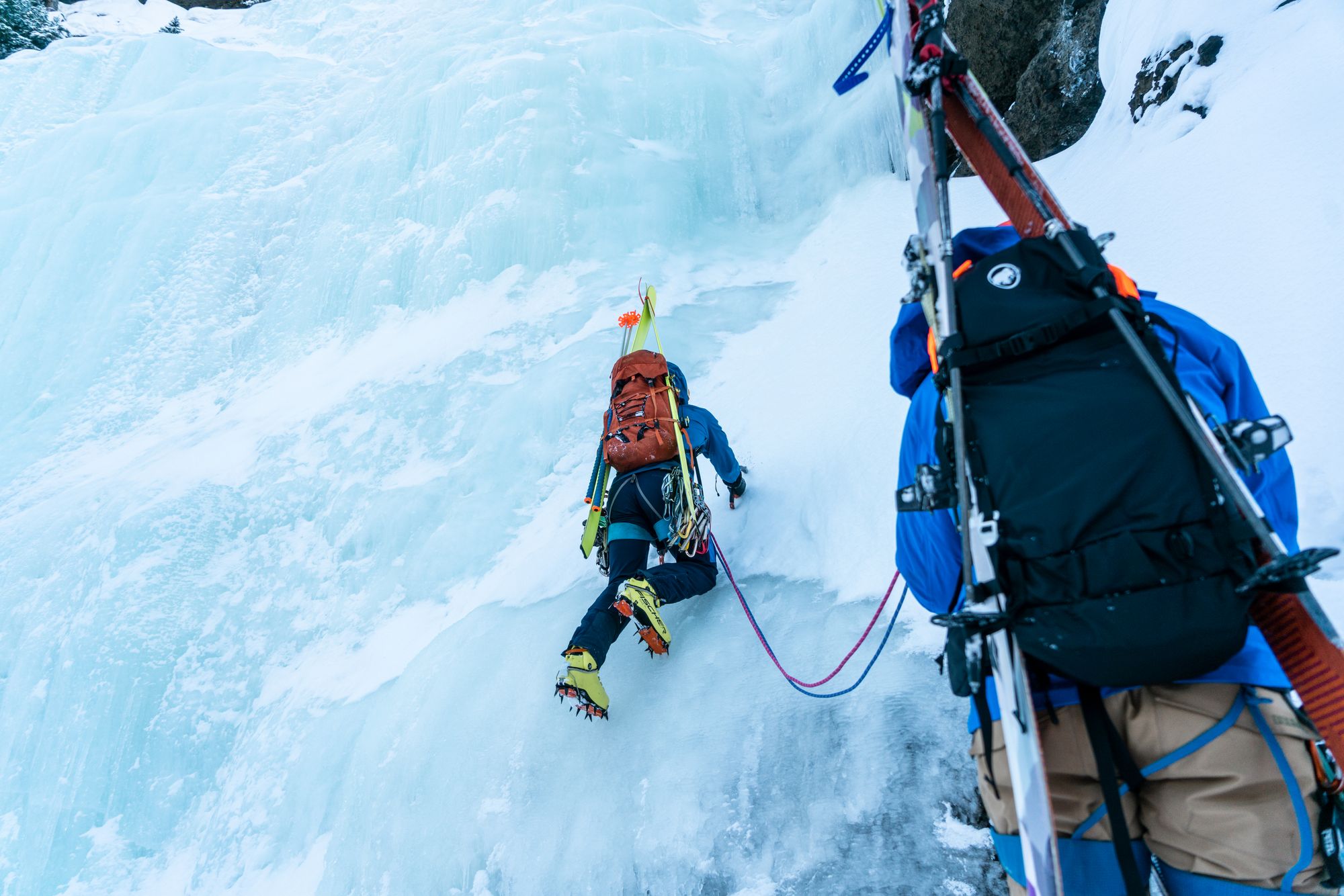
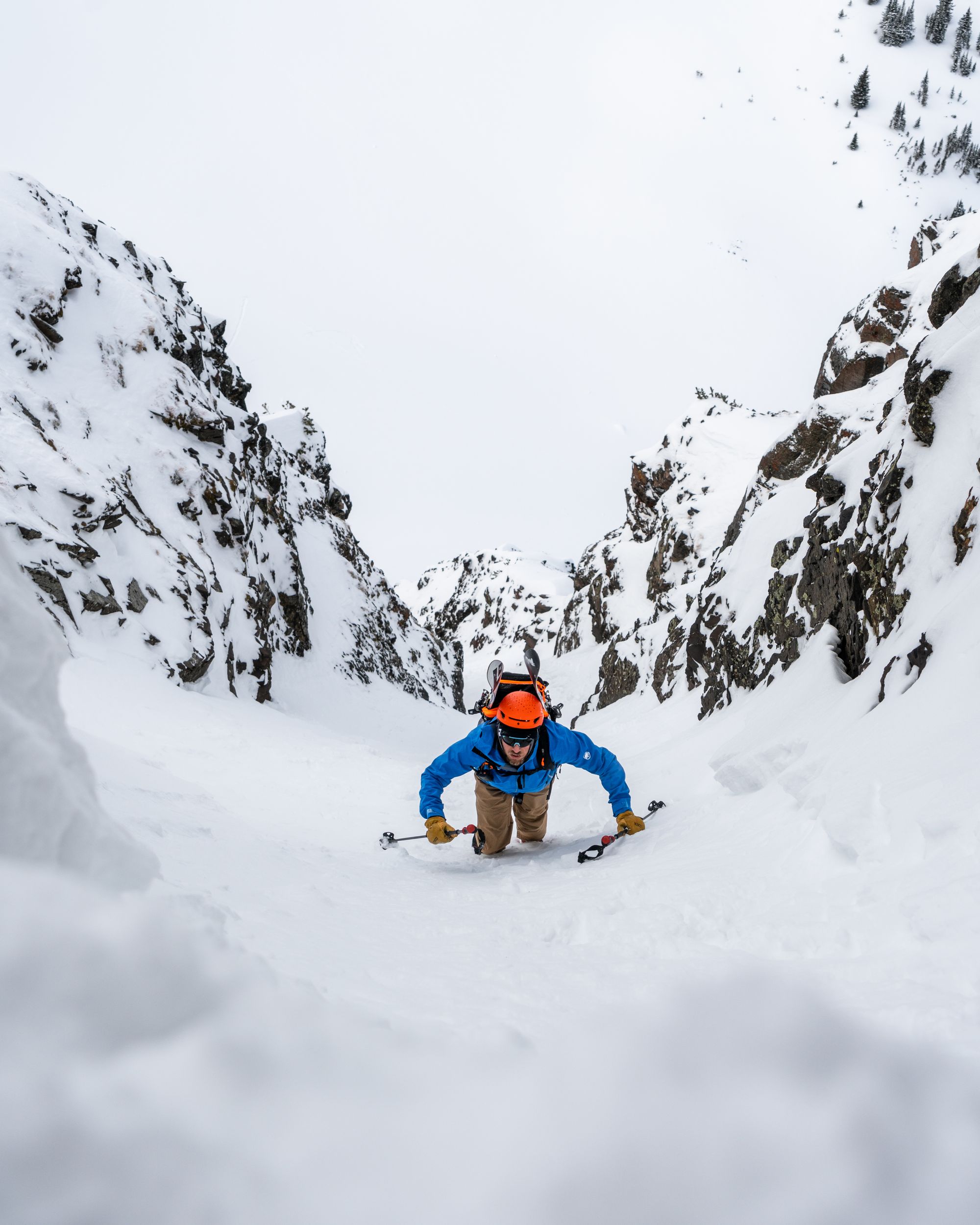
Apocalypse choke (left) and Hyalite Canyon (middle / right)
MCL Test in the Sierras
When the snowpack stabilized, Connor and I hoped to bag a few other classic lines in the Park to train. Teewinot and Middle Teton East Faces, round two with the Skillet, Amor A' Vida, etc.
Then, in late March, I sprained my MCL. After giving up hope for a ~week, followed by six weeks of physical therapy, I flew to Reno to join Xavier and Sebastian in the Sierras. I'd test my knee on Mt. Williamson (trip report).
Wednesday, May 10th, was a day of Type III fun. I escaped Williamson with bloodied hands, a couple buried cactus spines and sun-poisoned thighs. My knee held up fine. Xavier and Sebastian joined another friend, Rory, for Bloody Couloir after resting Thursday. Out of shape, I passed, hoping to save myself for the Grand.
When the crew joined me at my coffee shop hideout, Xavier coaxed Rory to join us in Jackson. At first, Rory brushed off the invitation, citing a few logistical hurdles. We quickly offered solutions to each. He hesitated again, gears turning, and said he needed to call his girlfriend.
That afternoon, Friday, May 12th, Xavier and I drove east out of Mammoth, crossing Nevada and the southeast corner of Idaho, Tetons bound. Sebastian drove north to Bend, stuck covering a few work shifts.
Saturday morning, Rory called. He booked a flight from Reno to arrive in Jackson that evening. Overtaken by FOMO, Sebastian decided to drive 11 hours from Bend on Sunday morning. He'd get a few hours of sleep at the trailhead, before our planned midnight departure.
Our group of three became five.
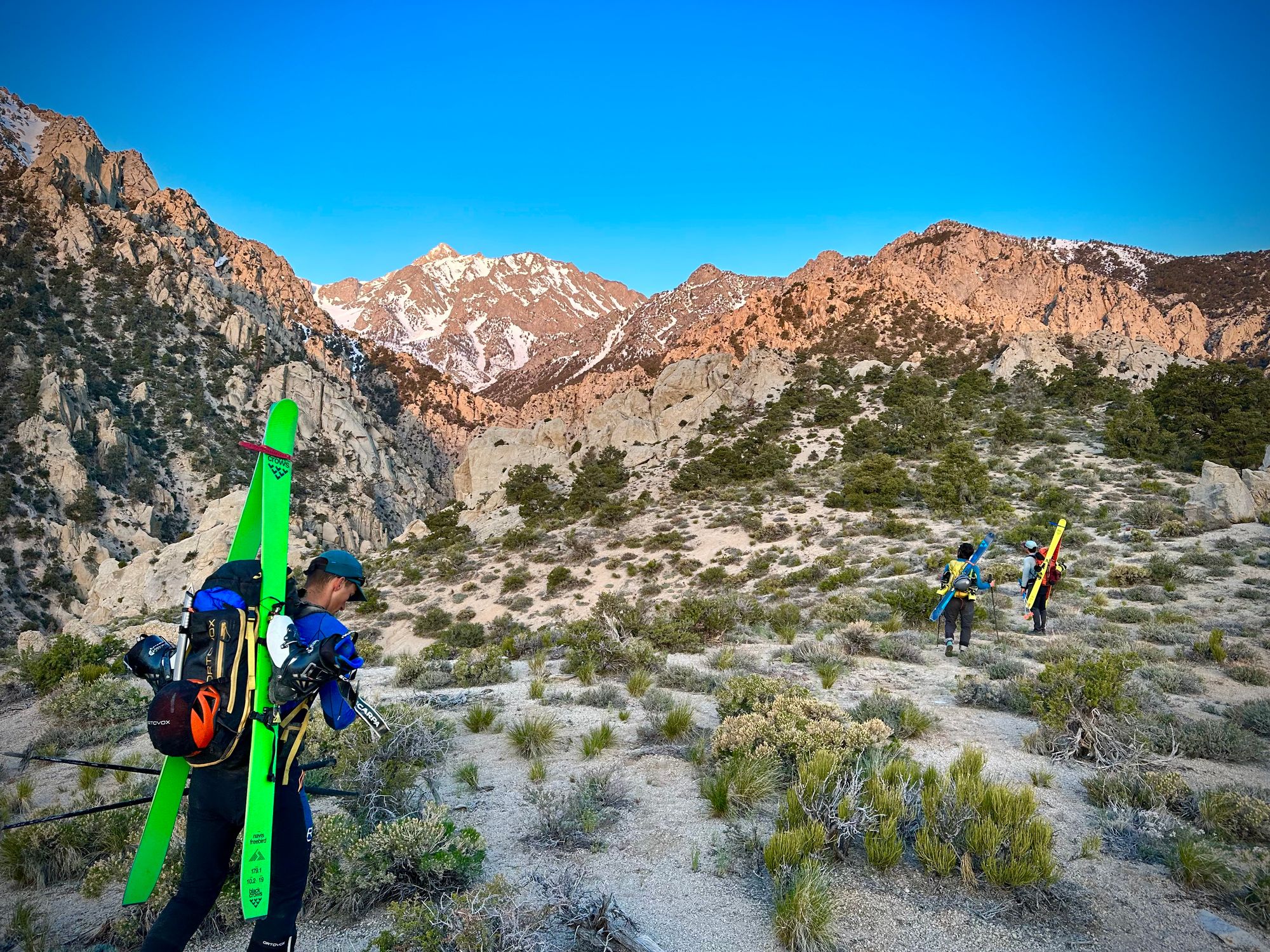
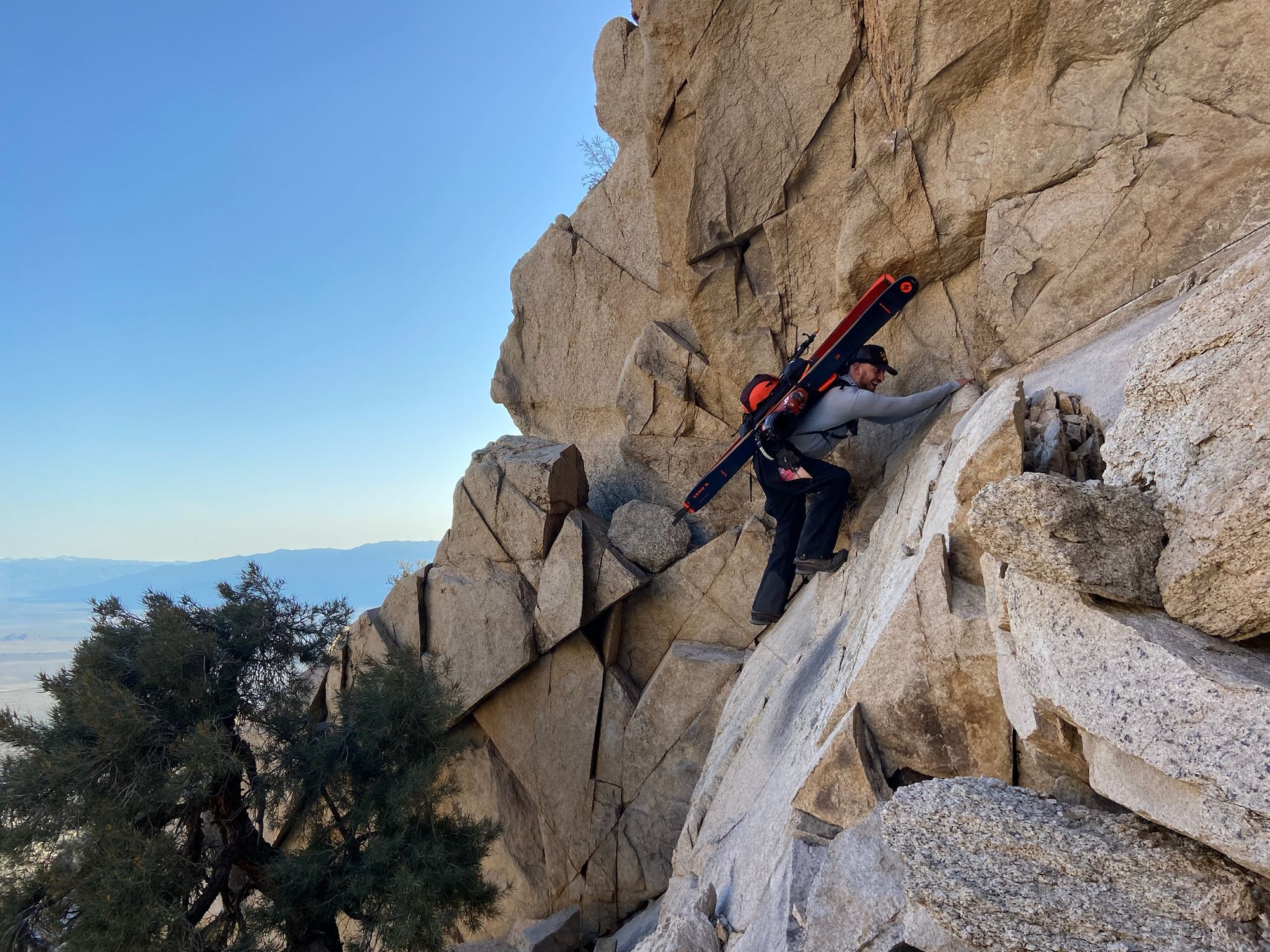
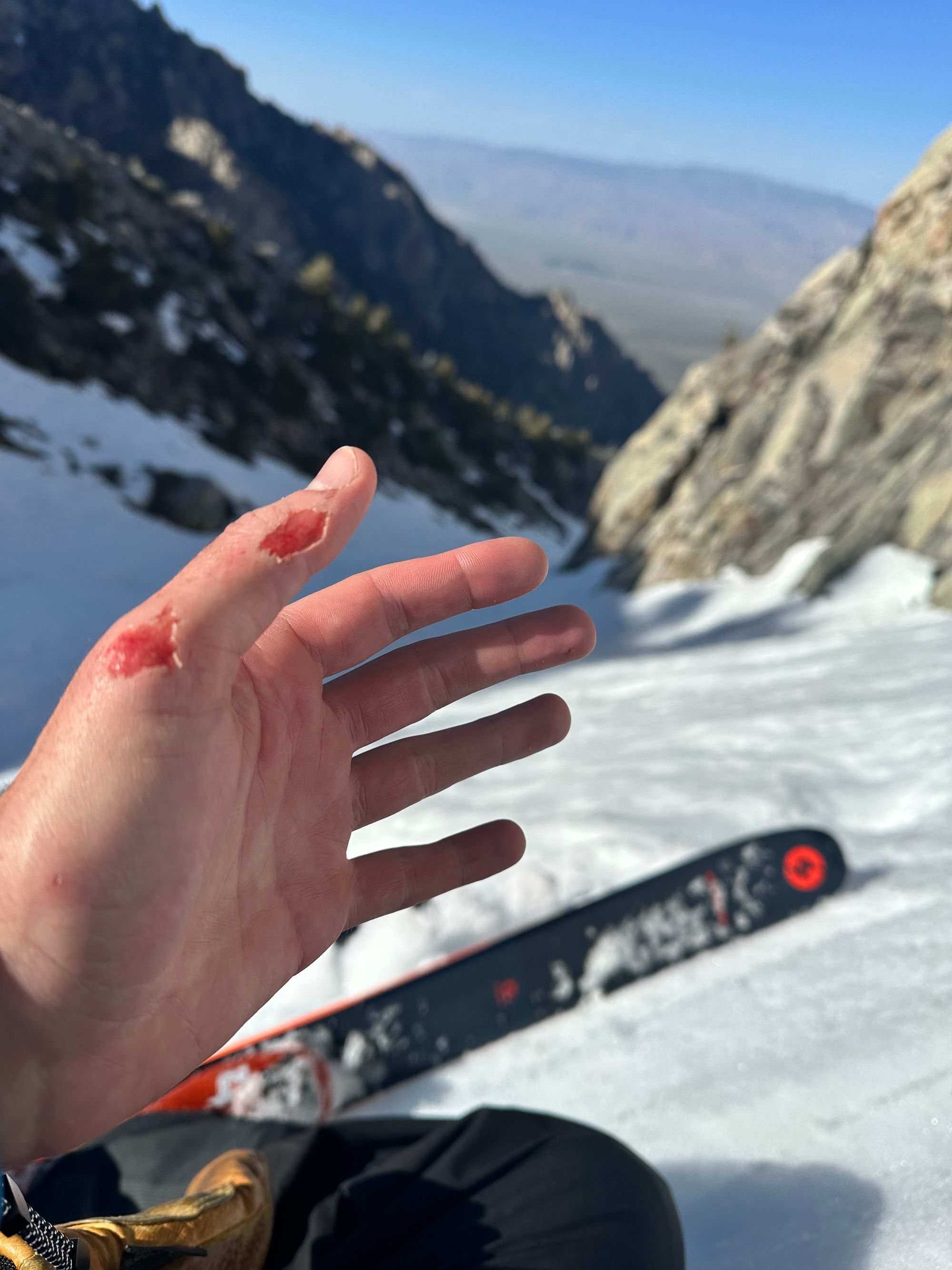
Mt. Williamson fun
Planning
Rope Systems
Driving through Nevada, Xavier and I brainstormed rope systems for our initial team of three. From friends who'd recently skied Ford-Stettner, we knew the Chevy and Stettner had many well-maintained anchors. At bare minimum, a single 45-meter rope and some downclimbing would suffice.
Groups also free solo the full route, skiing further down the Ford and potentially through the Stettner, downclimbing sections in between. For live commentary on the 5:17 (!) speed record set in 2011, see the comment section of this TetonAT post, prompted by the prior 7:15 record set earlier that week.
With less ambitious aims, we planned 12-16 hours round-trip. We'd protect the Chevy climb – potentially the Stettner if we found ice – and rappel from the top-most Ford anchor to the base of the Stettner.
Original plan: With our group of three, we planned to follow our Twin Falls playbook. Xavier had two 7.5mm ropes we used for ice climbing in Hyalite. Xavier would lead. Connor or I would belay him on two half ropes (doubled for lead climbing). Then he could top-rope us as we simul-climbed, each tied to one half rope. Given our low fall factors, the only concern would be accidentally clipping the lower rope with crampons or ice tools. We'd clean any ice screws Xavier placed.
Alternative #1: When Rory joined, we discussed adding just one new, lightweight single rope. On ascent, the third climber could belay the fourth on single, while the second belayed Xavier on the next pitch. To speed up rappels, we could leapfrog: group one tying off the single to rappel, then group two untying the stopper knot and rappelling on the two half ropes.
Alternative #2: We also debated using only Xavier's two half ropes to save weight and the hassle of buying new ropes, one for each team (Xavier / Rory and me / Connor). A leader shouldn't fall on a half rope, but Connor and Xavier would be climbing well within their comfort zones. Plus, it wasn't a vertical pitch.
To speed up rappels, we could potentially pair the half ropes with cords and blocker knots for retrieval to leapfrog. Another approach could be simul-rappelling, albeit a bit slick with ATCs on single half ropes.
Final plan: Due to each alternative's shortcomings (and for simplicity's sake), we landed on two (mostly) independent rope teams, each using their own half ropes. Xavier and Rory first, then me and Connor. Xavier would place ice screws and leave them for me and Connor. I'd clean the screws from my "anchor" position. Plan set, I picked up two more 7.5mm ropes at Teton Mountaineering. (After checking stock at every climbing store between Pocatello and Teton Valley.)
Xavier and Sebastian were comfortable on even higher ice grades, so when Sebastian joined, the Campos brothers agreed one of them would just free solo. Chevy's only WI2, conditions dependent. (On approach, the Campos brothers debated who'd get the honor.)
From beta, Chevy Couloir would involve two pitches, or protected rope lengths, with 60-meter groups – roughly ~350 feet of climbing.
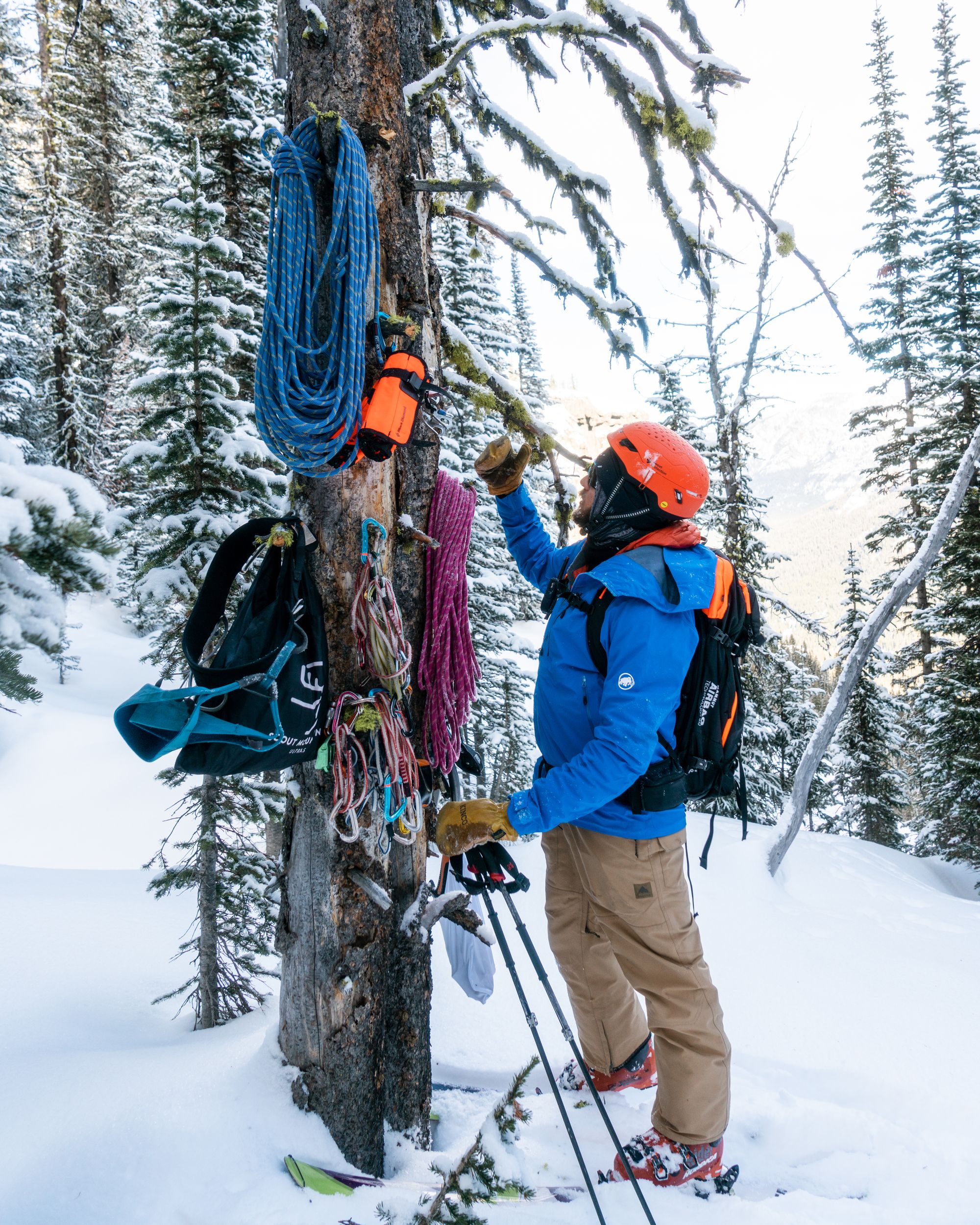
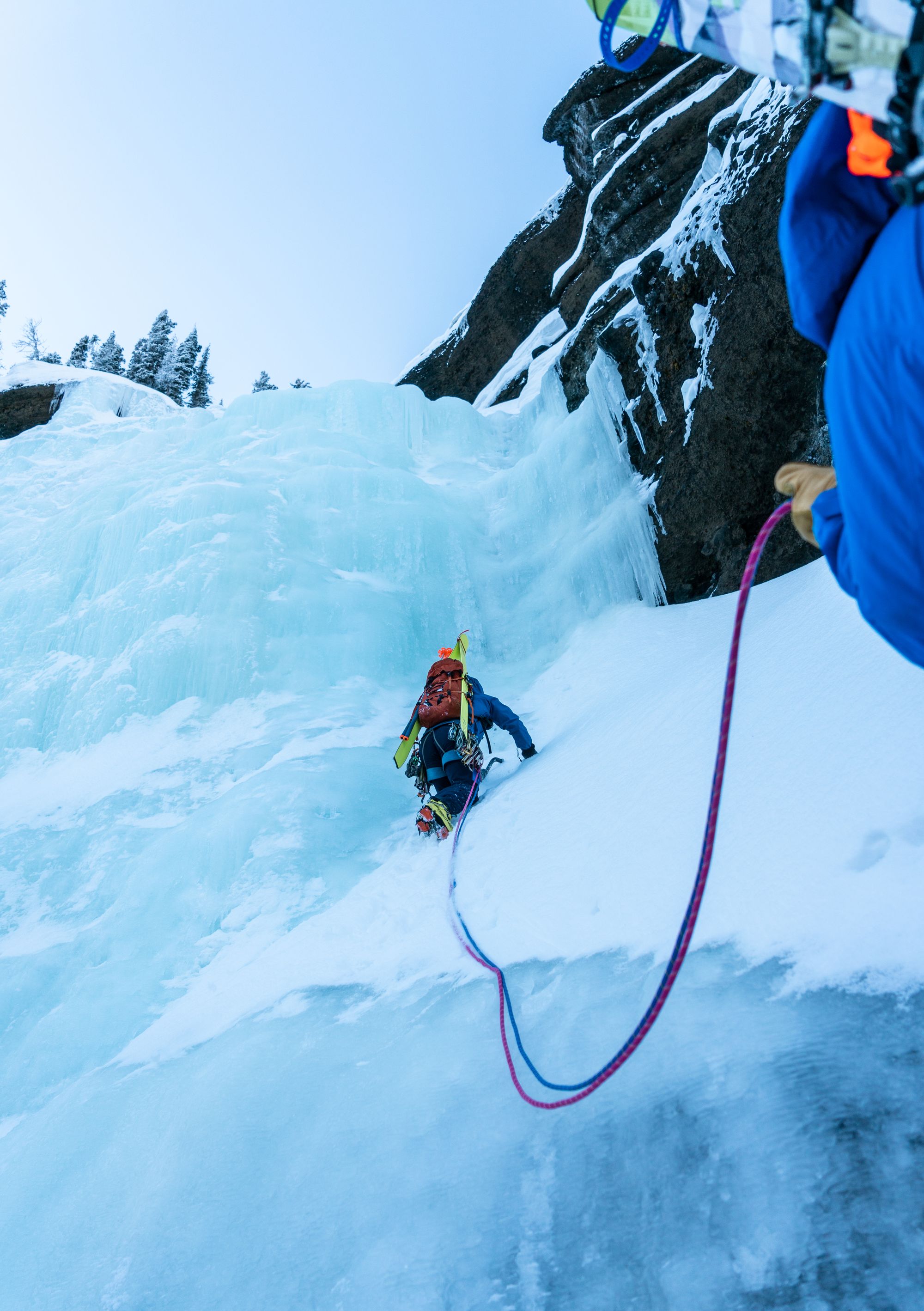
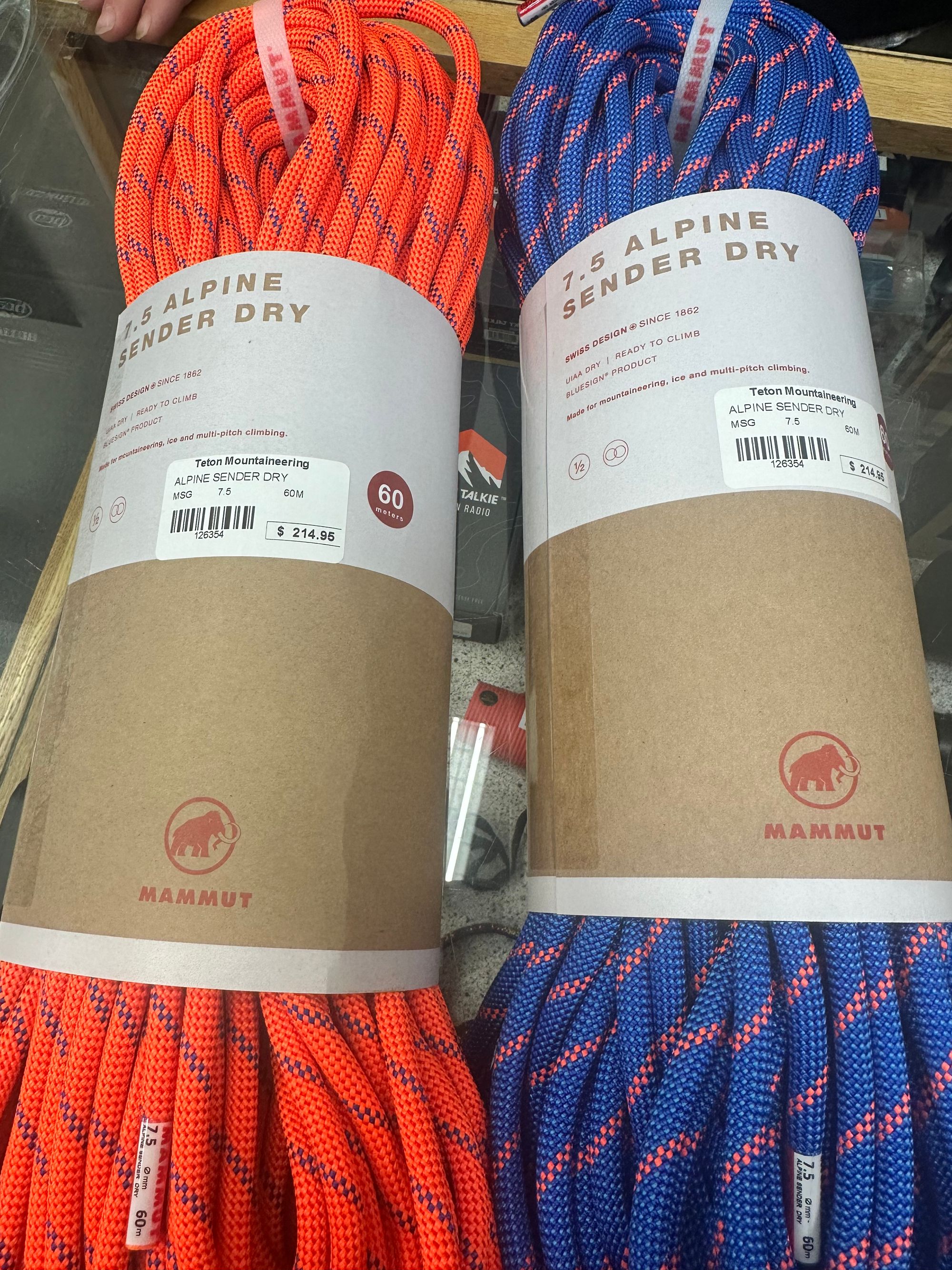
Xavier's half ropes in action on Twin Falls (left / middle); our new half ropes (right)
Timing
We wanted to be "out of the gun barrel" – the connected slide path from the Ford down to the Stettner – by 10am. Estimating 12-16 hours round-trip, we set a midnight departure. We guessed 8-10 hours to the summit with a big group at various fitness levels and over mixed spring terrain, then 3-5 hours to descend.
It's mind blowing to think the round-trip speed record is 5:17.
Route
Grand Teton's Park Road opens May 1st, freeing us from the Taggart Lake trailhead. From conversations with rangers, the NPS didn't plan to open Lupine Meadows Road until it naturally melted out.
During my pre-Sierra scouting drives, I landed on the Lucas-Fabian Homestead between Taggart and Lupine Meadows. A close second was the Teton Glacier turnout, a short hike to the Homestead bridge spanning Cottonwood Creek.
From the north-facing side of the ridge bordering Burned Wagon Gulch, we should find snow most of the way to Garnet Canyon. We planned to intersect the summer switchbacks, due to reports of challenging stream crossings directly beneath Garnet Canyon.



FatMap route
Gear List
Changes from Mt. Williamson (earlier that week):
- Petzl Quark ice tools, hybrids that span less technical ice climbs and steep snow (see Hyalite Ice for more on tools vs. axes)
- Petzl Sarken crampons with ski boot bindings, a versatile crampon that handles ice climbing, but lack interchangeable mono / dual points (e.g., DART); more about crampons from Petzl's how-to-choose guide
- Mammut 7.5mm half rope (one for me and one for Connor), so we could split weight between two skiers and set up full 60-meter, retrieval rappels; Xavier and Rory carried two more half ropes
- A few ice screws to protect the ice bulges we expected in Chevy Couloir (Xavier carried and placed; I cleaned)
- Climbing kit: harness, ATC Guide, personal anchor ("PA"), prusik (for a third hand while rappelling) and extra carabiners
- Under Armour long shorts to protect sun-poisoned thighs beneath my new outside-vent shell pants
- Insulated, water-proof work gloves (grabbed a Golden Stag pair in ACE, but any will do); Showa gloves are also popular with ice climbers (important to keep hands dry, and thus warm, when climbing with tools)
- 2L Hydration bladder (learned on Mt. Williamson to not gamble with melting snow or finding runoff; spring conditions, so didn't worry about freezing)
- Note on ski crampons: My Dynafit's broke on Mt. Williamson, and late season, I couldn't find a new pair in Jackson (we lucked out with warm, soft snow up to Teepe Glacier – more on the instability trade-off later)
Same as Mt. Williamson:
- Mammut Pro 45L airbag pack and avy gear (beacon, probe and shovel)
- Blizzard Zero G's 105mm and MTN Pure bindings (bought this combo a month earlier, Grand in mind); plus Black Diamond skins (re-purposed from my retired Liberty Origins) and adjustable ski poles
- Nordica Strider 130 hybrid boots (top shopping priority: real touring boots before the next big objective)
- Mammut shell pants and jacket, plus emergency puffer
- Sweet Protection Ascender Mips helmet
- Upper-body base layer, wool ski socks and sun hoodie, shades, buff, ballcap and runner's beanie for beneath my helmet
- Heavy gloves (Kinco's wax treated in the oven + wrist straps); light gloves
- Rocky Talkie radios
- Sunscreen
- Emergency / extra gear: fire-starter, lighter, space blankets, Leatherman multi-tool, headlamp, first-aid kit, extra moleskins and sterile pads, tourniquet, ski straps, Gorilla tape to-go, handwarmers and a collapsible filtered water bottle
- Calories / hydration: assorted bars, flavor-blasted Goldfish (savory snacks to balance the sweets), peanut butter packets, GU gels and electrolytes; some of the guys packed pepperoni pizza slices from Pinky G's
- Repair kit: more ski straps (used one to create a makeshift whippet with an ice tool), zip ties, bailing wire, ski pole baskets, skin tail clips and hose clamps (to fix a snapped pole) – mostly from ACE Hardware

Trip Report
Scouting and Cold Plunge
At 1pm on Saturday, Xavier and I cruised over Pine Creek Pass, entering Teton Valley, ID. I drove the last few stretch of our 13 hours from Mammoth, split over two days to ensure another 8 hours of sleep after Mt. Williamson (plus Bloody Couloir for Xavier).
Dunkin' Donuts fueled the drive, honoring our east-coast roots. (We each grew up in Suffolk County, NY.) Still nursing sunburn from Williamson, I wore a wind buff and sun hoodie, applying moisturizer and lip balm every few hours.
We stopped at Highpoint Cider to align with Connor on ropes and logistics. (I was also curious about this highly-anticipated drama.)
At 2pm, we drove over Teton Pass, headed to Teton Mountaineering for two new half ropes. Mt. Glory's east-face melted down significantly since my flight to Reno earlier that week. I worried about our sub-Garnet start and finish.
Xavier stretched his legs on a Josie's Ridge run, while I cooked elk steaks (from my fall 2022 hunt) and homemade potato chips. We organized gear, and at ~8pm, Xavier picked up Rory from the airport. My roommate, Chelsea, slept at a friend's house to make room for our new "basecamp" (thanks Chels!).
After our last full night's sleep, Xavier, Rory and I drove into the Park to scout, given the recent rain and warm spell. Finding a short hike to snow after the Lucas-Fabian Homestead, we decided to stick with my original plan. Lupine Meadows Road still hadn't melted out.
Xavier hopped in Cottonwood Creek for a cold plunge and we took a last look at the summit we'd pursue in just twelve hours. We stopped at Pinky G's for pizza, taking home an extra pie for the summit. Then, we met Connor at Smith's for final groceries. Top priority: Eggos for Rory. Sebastian called from mid-way across Idaho, on track to reach the trailhead by 9pm.
After final packing, we settled into bed at 6pm, setting alarms for an ungodly 9:30pm. We reserved extra time to make last call at the Cowboy Bar for pre-Grand shots. Olly sleep gummies ensured a few good hours.
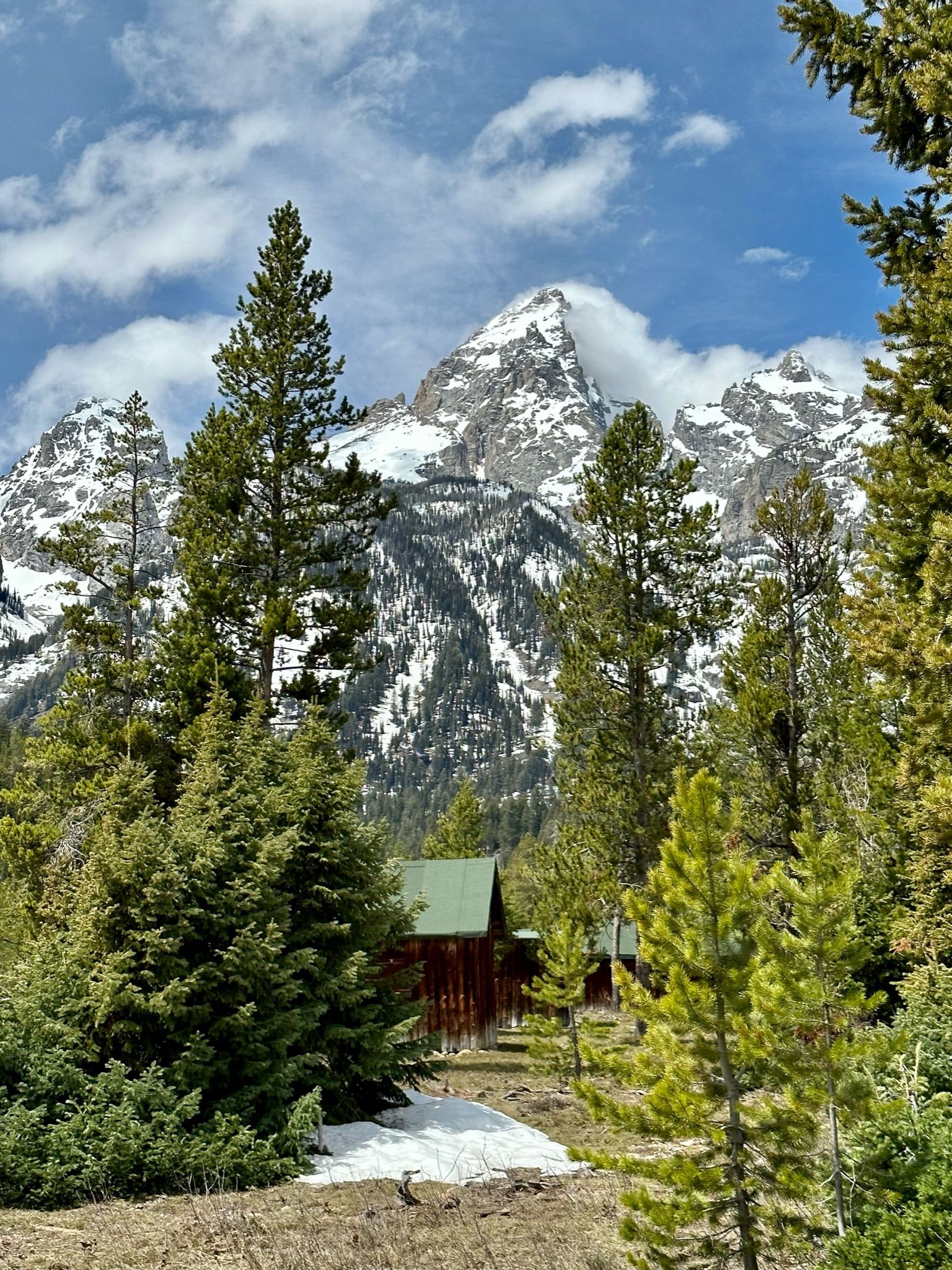
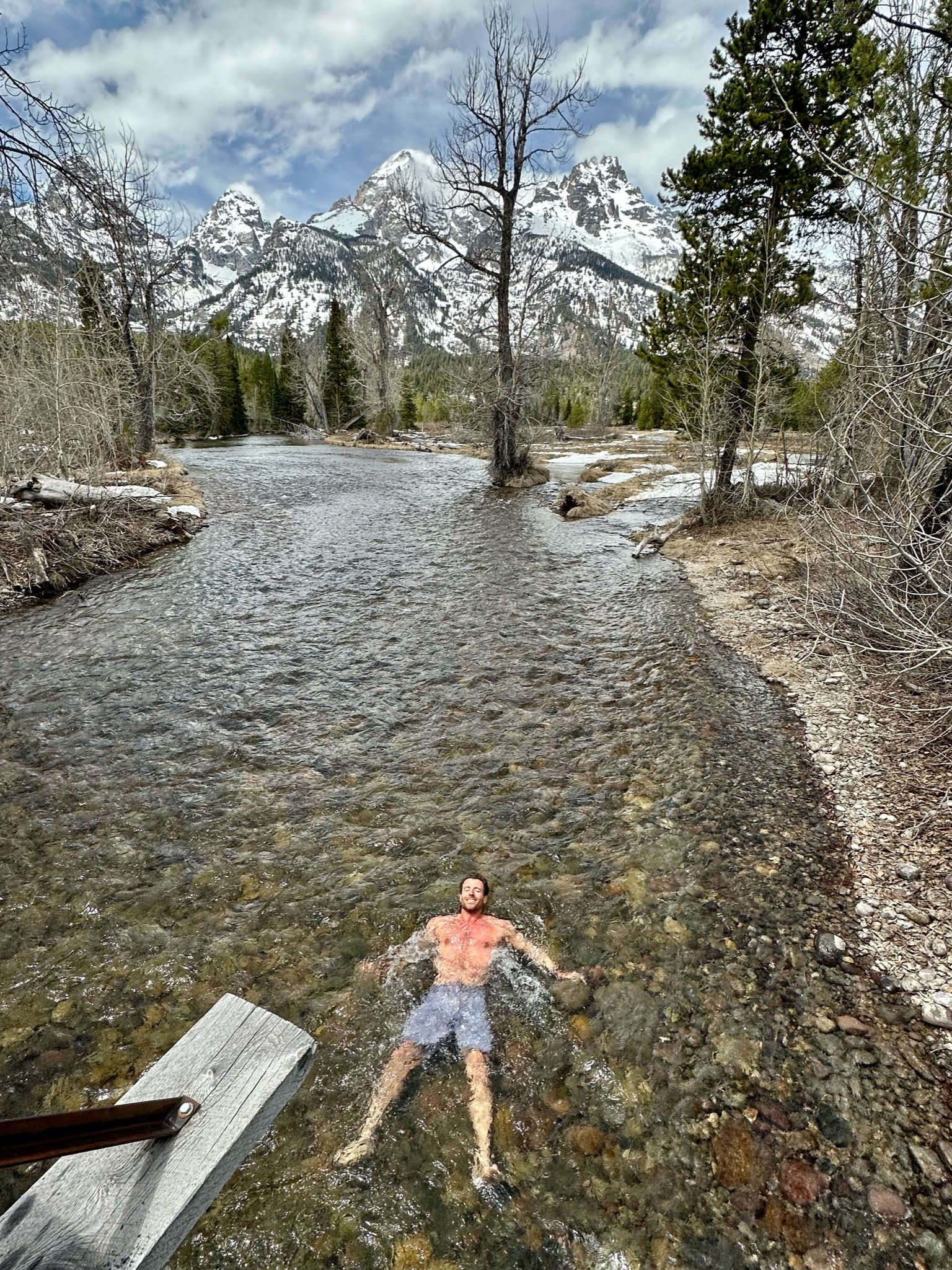
Scouting the Homestead and Xavier's cold plunge
Rain and Eggos
At 9:30pm, my phone chime broke a gummy-supported slumber. I heard footsteps upstairs, where Xavier, Rory and Connor slept. Then, I noticed an unmistakable (and concerning) pitter-patter outside my window. It was raining.
Plans in motion, I got dressed and threw my pack in the backseat of my truck. With the lengths Xavier, Rory and Sebastian took to reach the Tetons, I figured we'd at least drive to the trailhead and see if it was raining in the Park.
I joined the guys upstairs for some PB&J Eggos, plus a pre-emptive Pedialyte from Smith's. At 10:45pm, we headed for the Cowboy in my Tundra and Xavier's Subaru (mountain-town clichés noted).
Connor and I reached the Cowboy, now in heavy rain, only to miss last call. Closing time can be hard to predict at Jackson's only late-night bar (the Rose hadn't reopened yet). Connor suggested pulling the "Grand card," but with Xavier and Rory nowhere in sight, I brushed it off.
On the drive north, Connor and I aligned on conditions. If it kept raining, we'd bail. Continued rain would impair stability (and be miserable). Secretly, I rooted for the rain, a no-fault excuse to join the rest of the world in bed.



Alarm set and packed for the Cowboy
Slush, Rocks and Mud
It kept raining as we passed the Elk Refuge and Moose Junction. At ~11:45pm we met Sebastian, Xavier and Rory at the trailhead. We agreed to wait until 12:30am, flipping between weather radar and the latest Windy forecasts. It looked like the mountains might dry out soon. Xavier and Rory perused Xavier's Fifty Classic's book, wondering why they ever left the Sierras.
It stopped raining at 12:15am, and by 12:45am, a few stars emerged overhead. On long exposure, Connor's DSLR spotted mostly clear skies around the Cathedral Group. We geared up, starting in ski boots despite a half-mile hike to snow.
At 1am, we hiked west, over the bridge spanning Cottonwood Creek bridge – the site of Xavier's cold plunge twelve hours prior – and through sagebrush meadows surrounding the Homestead.
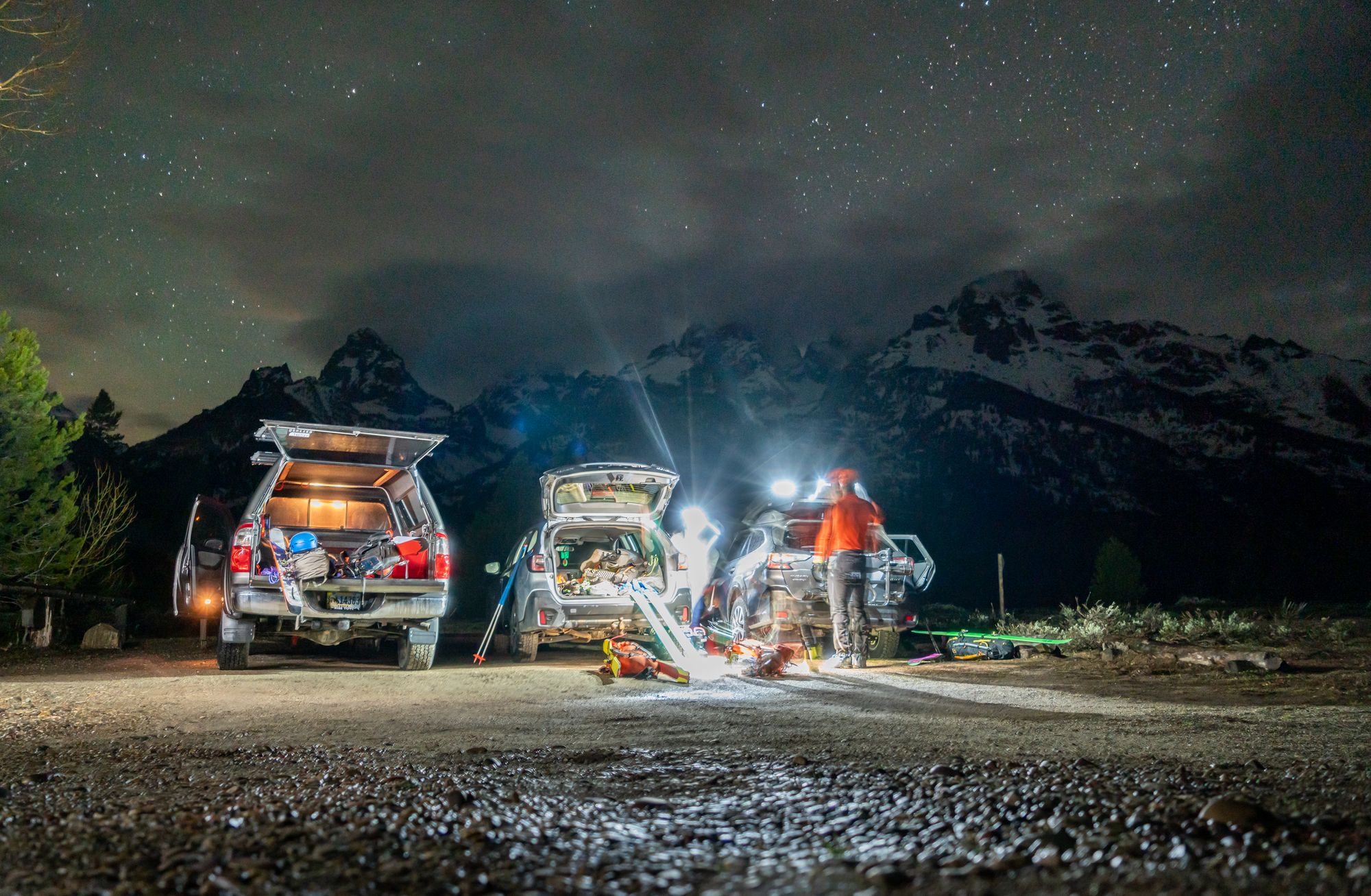
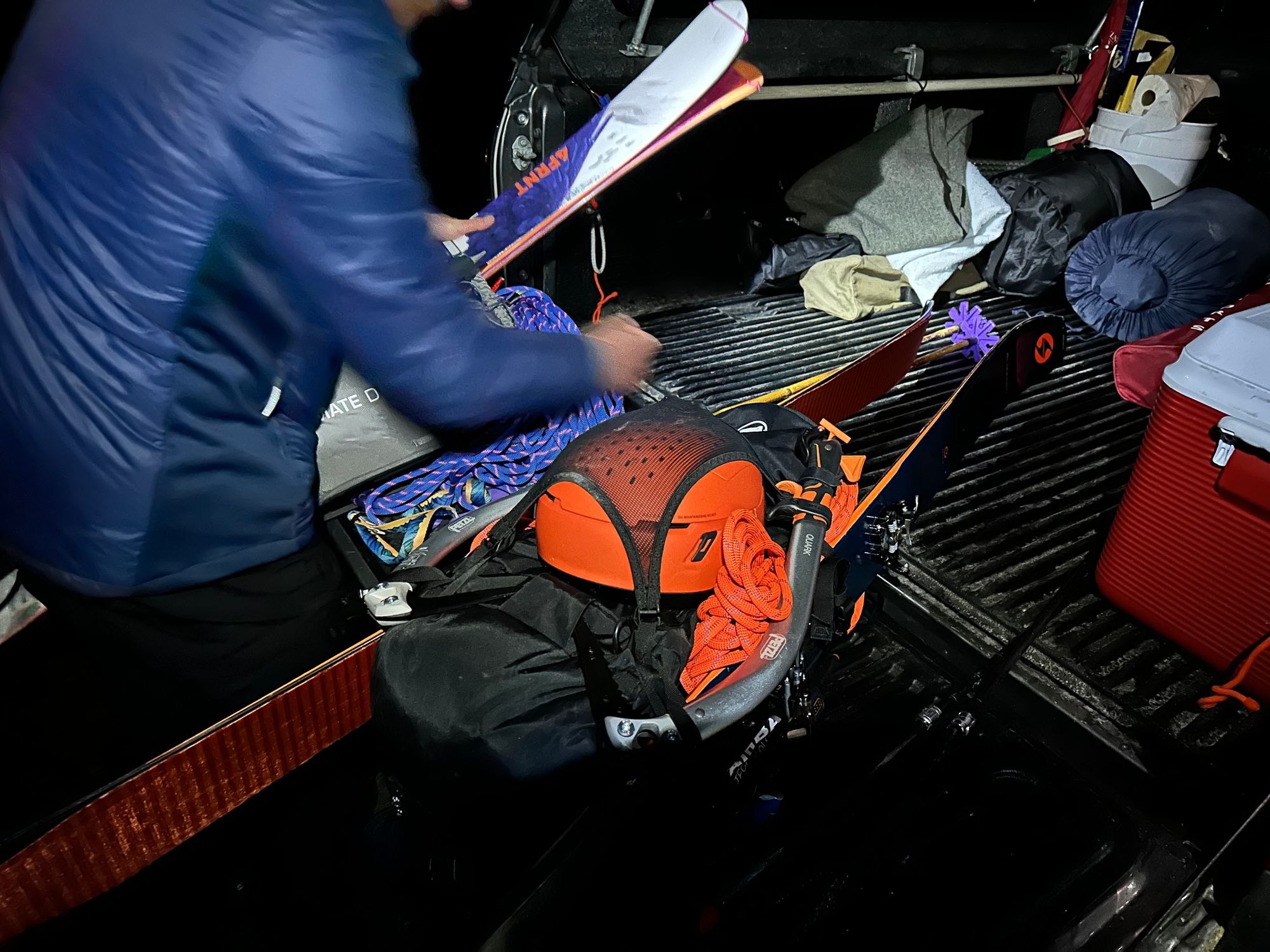
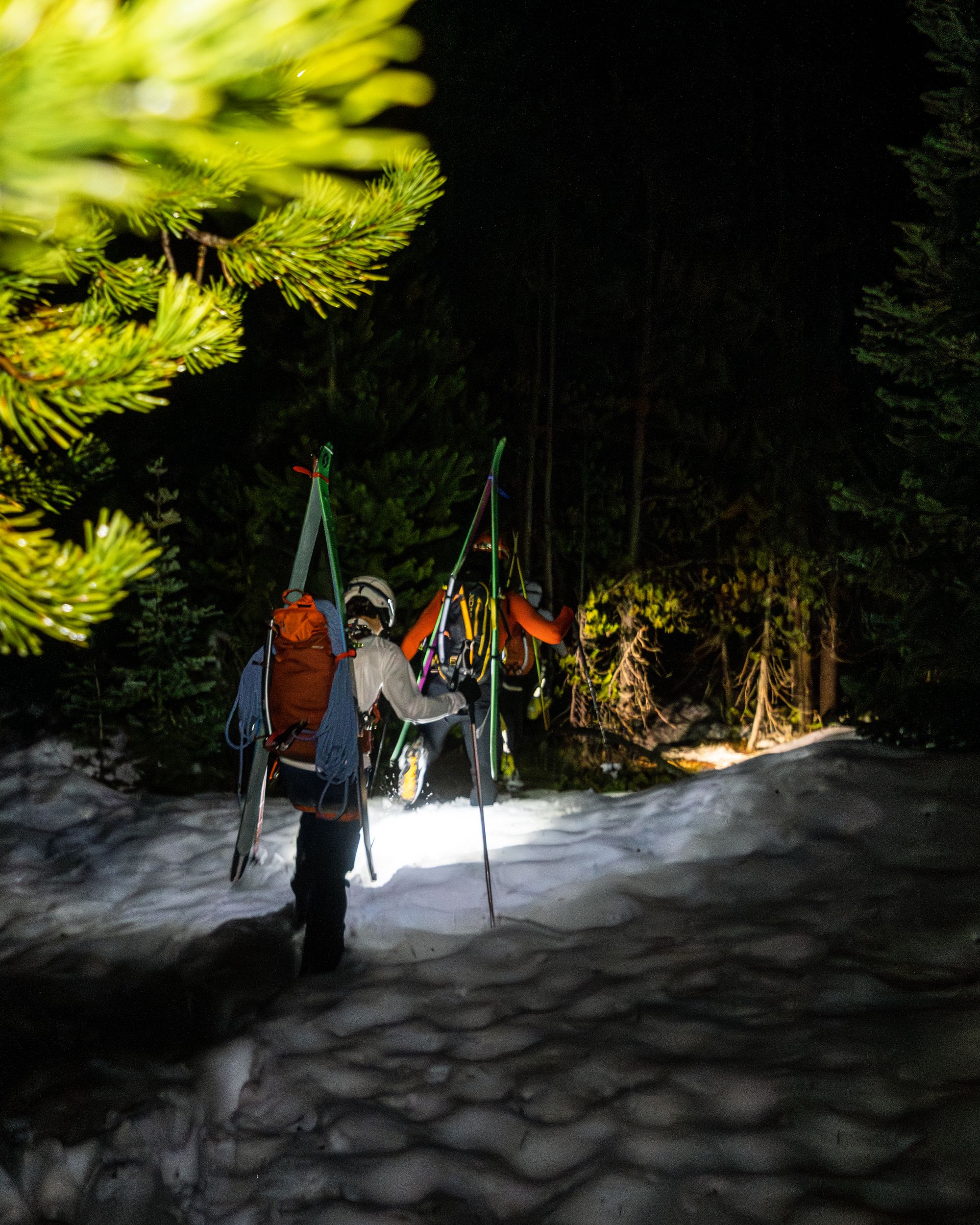
Trailhead and departure just after 1am
We reached snow in the north-facing pines bordering Burned Wagon Gulch to the west and transitioned to skin. We followed a set of tracks (possibly from a descent) ducking and weaving around fallen logs, streams and boulders, aiming for the summer switchbacks northeast of Garnet Canyon.
After ~30 minutes, a pine branch snagged my headlamp and flung it into a small waterfall. I called in the snafu over my Rocky Talkie and struggled to retrieve the torch. Its spotlight tumbled in a mini-rapid beneath the waterfall, simulating the world's smallest rave.
Fed up with a stick I tried first, and nervous I'd lose the torch to the stream, I stepped on partially-submerged rocks, soaking the bottom of my right sock. I grabbed the headlamp by hand, somehow still lit. I'd need it for five more hours.
I caught up with the guys at the ridge just below the summer trail. After a couple hundred feet of switchbacks on a southeast-facing slope, rocks and mud blocked our path. We strapped skis to our backs and hiked up a 40-degree slope.
Sebastian expressed concerns about stability. It was warm and the snow was very soft. To reduce risk of wet slides to an acceptable level, we needed an overnight refreeze. It was 2am at 7,500'. There was still a possibility of refreeze in the alpine, especially closer to sunrise, but it'd require a big gradient.
We hoped for the best and boot-packed on. At worst, we could descend at first light, before slopes warmed. Descending in the dark was a miserable prospect. I love full-moon Glory and Snow King laps, but we barely even had stars. A wet slide in the dark, seemed very unlikely, as did one at first light.
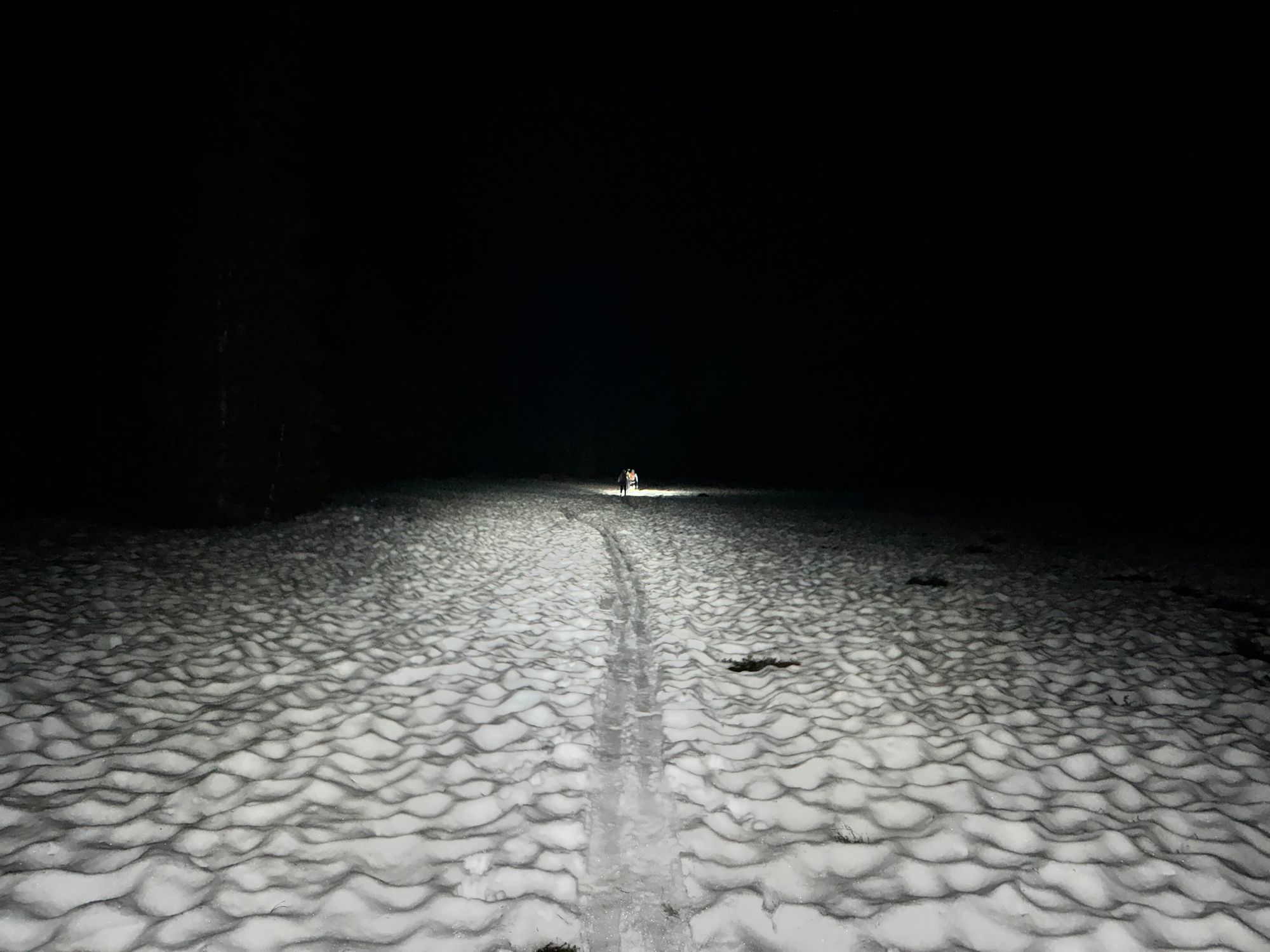

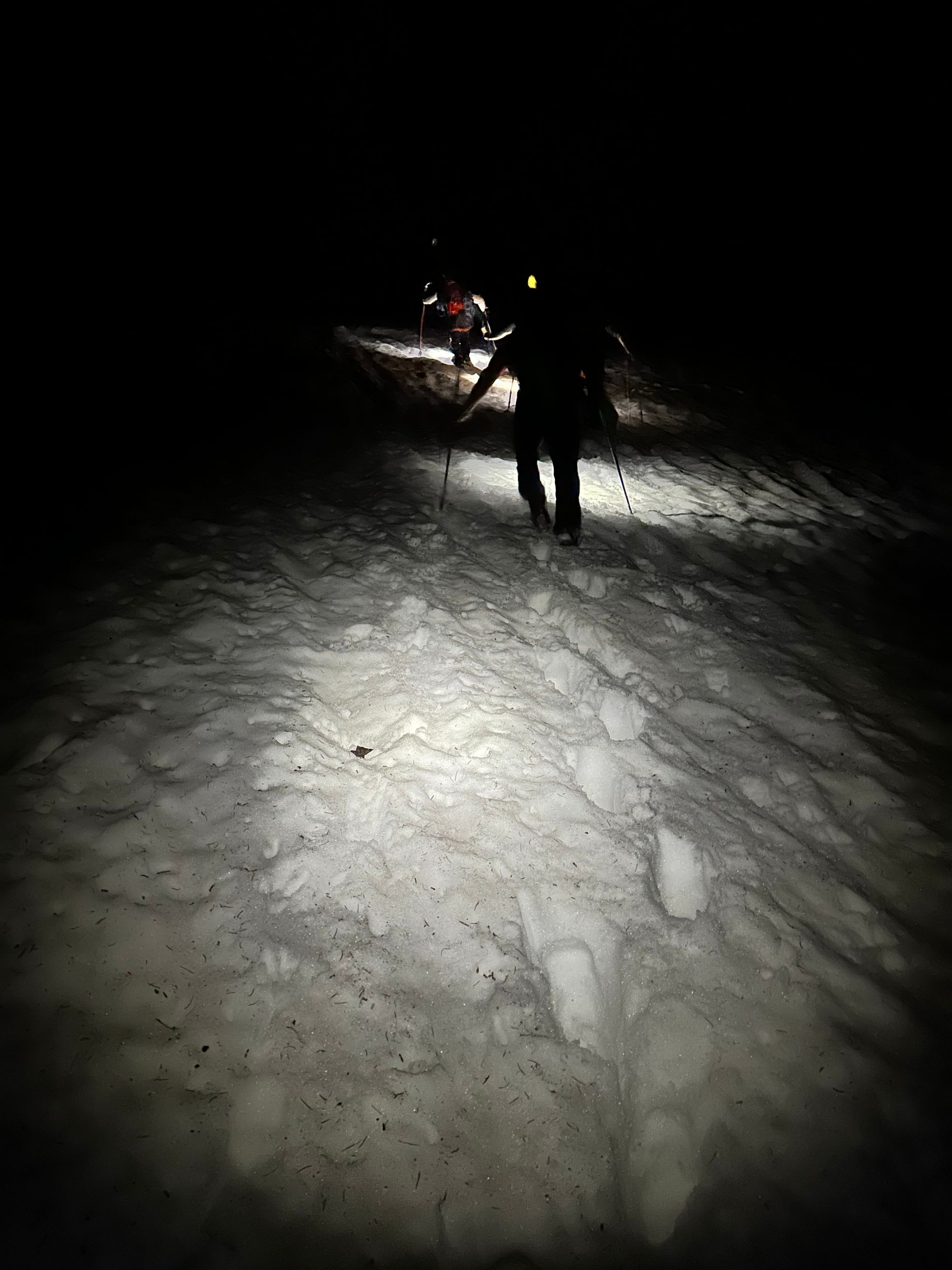
Burned Wagon Gulch and summer switchbacks
Garnet Canyon
By 2:45am, we reached the Garnet Canyon trail, at first overshooting it. An awkward side-slip in walk mode and we were back on track. South-facing, the summer Garnet Canyon trail melted more than we'd hoped. We alternated between skinning and boot-packing over rocks, transitioning at least 7-8 times.
At the entrance to Garnet, the snow was still soft. It was a bad sign for Ford-Stettner, but at the time, a relief considering no ski crampons. With refrozen or bulletproof snow, I'd want crampons for that sidehill entrance.
By 4am, we passed the boulder fields and switch-backed northwest toward Teepe Glacier. It was warm and the snow still soft. Spirits sagged, and at 5am, we took shelter beneath a boulder at ~10,000'.
Clouds engulfed us since we entered Garnet Canyon, likely contributing to the warm temperatures. Clouds trap ambient heat, preventing a refreeze.
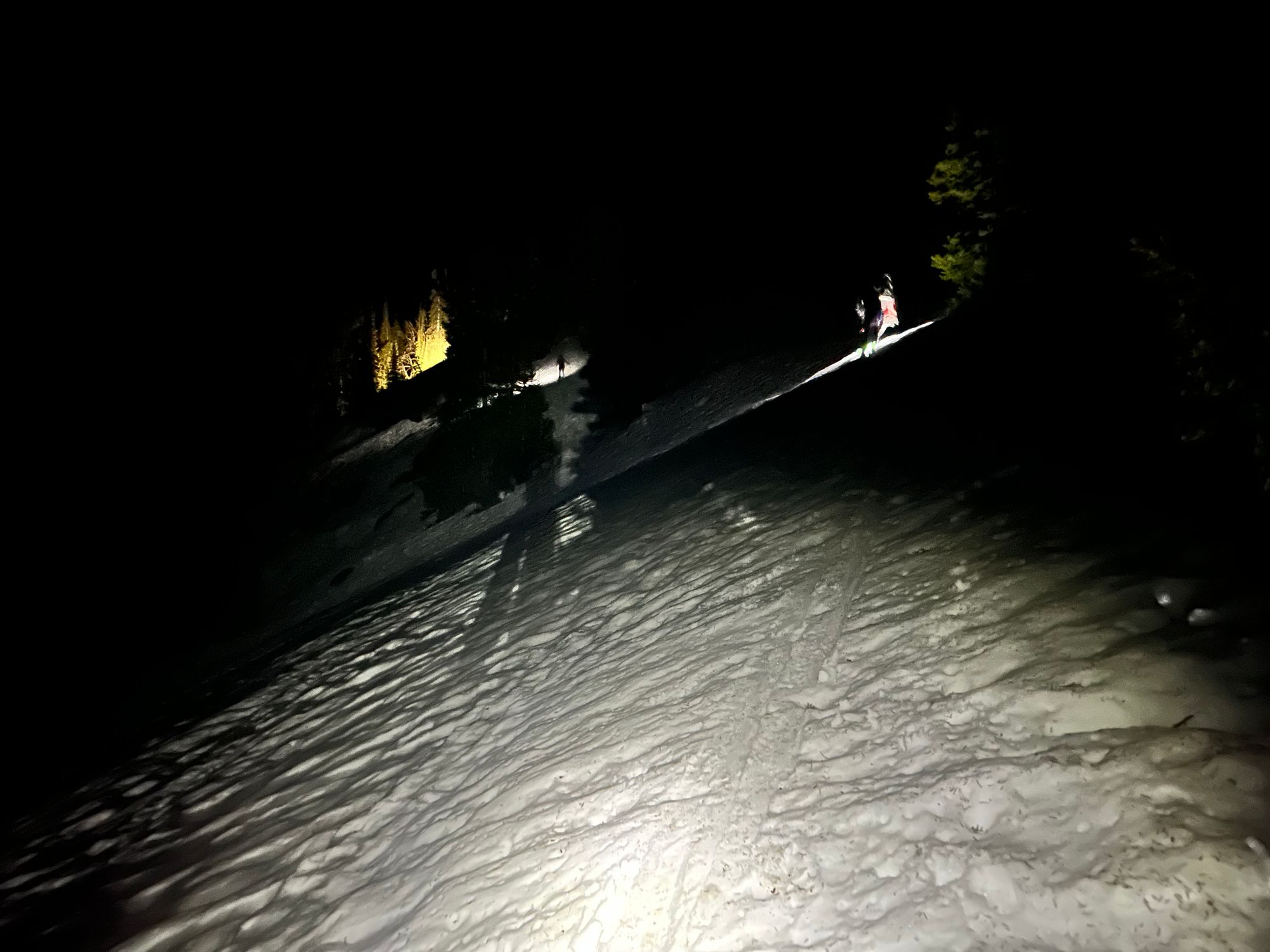
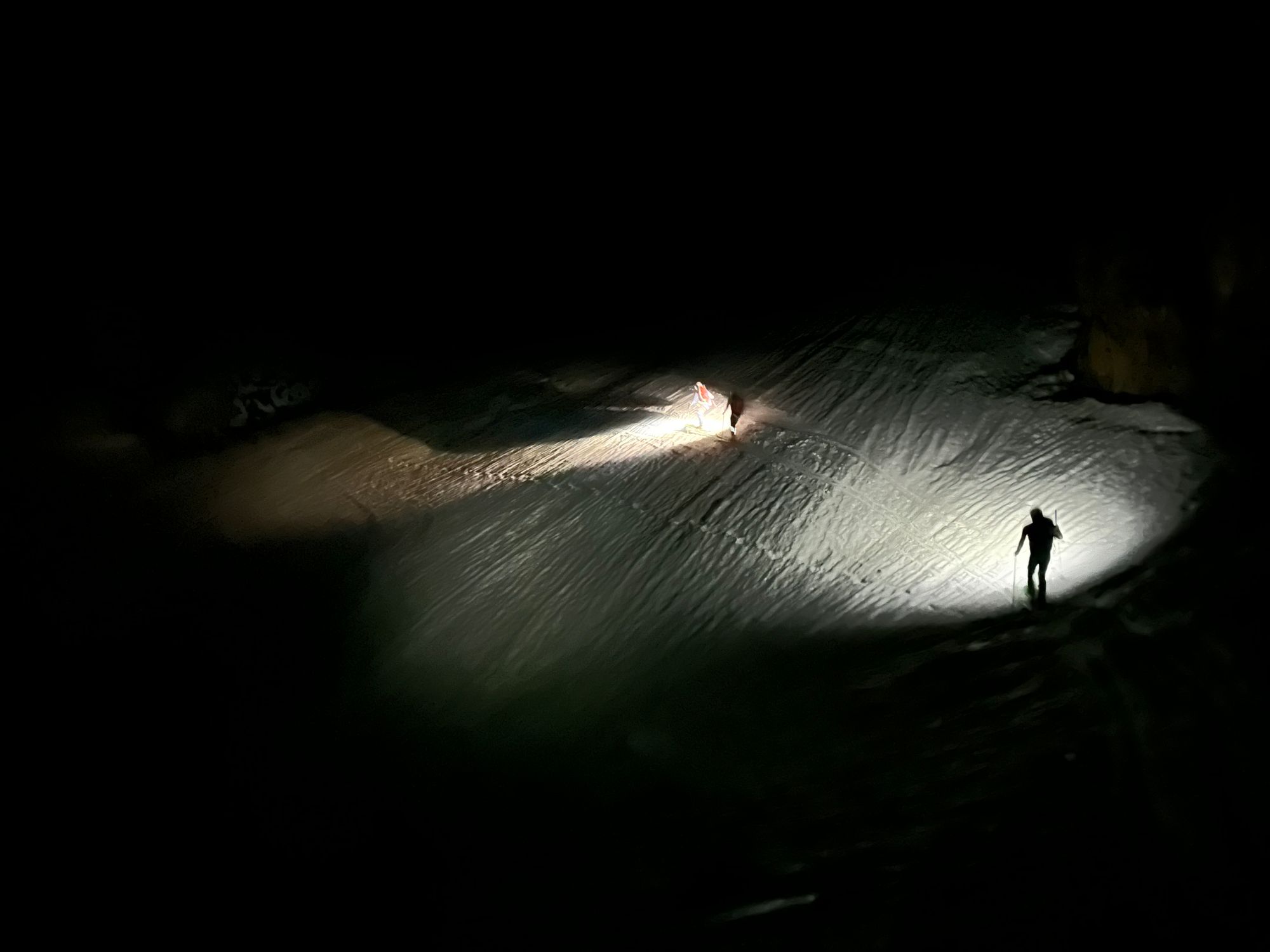
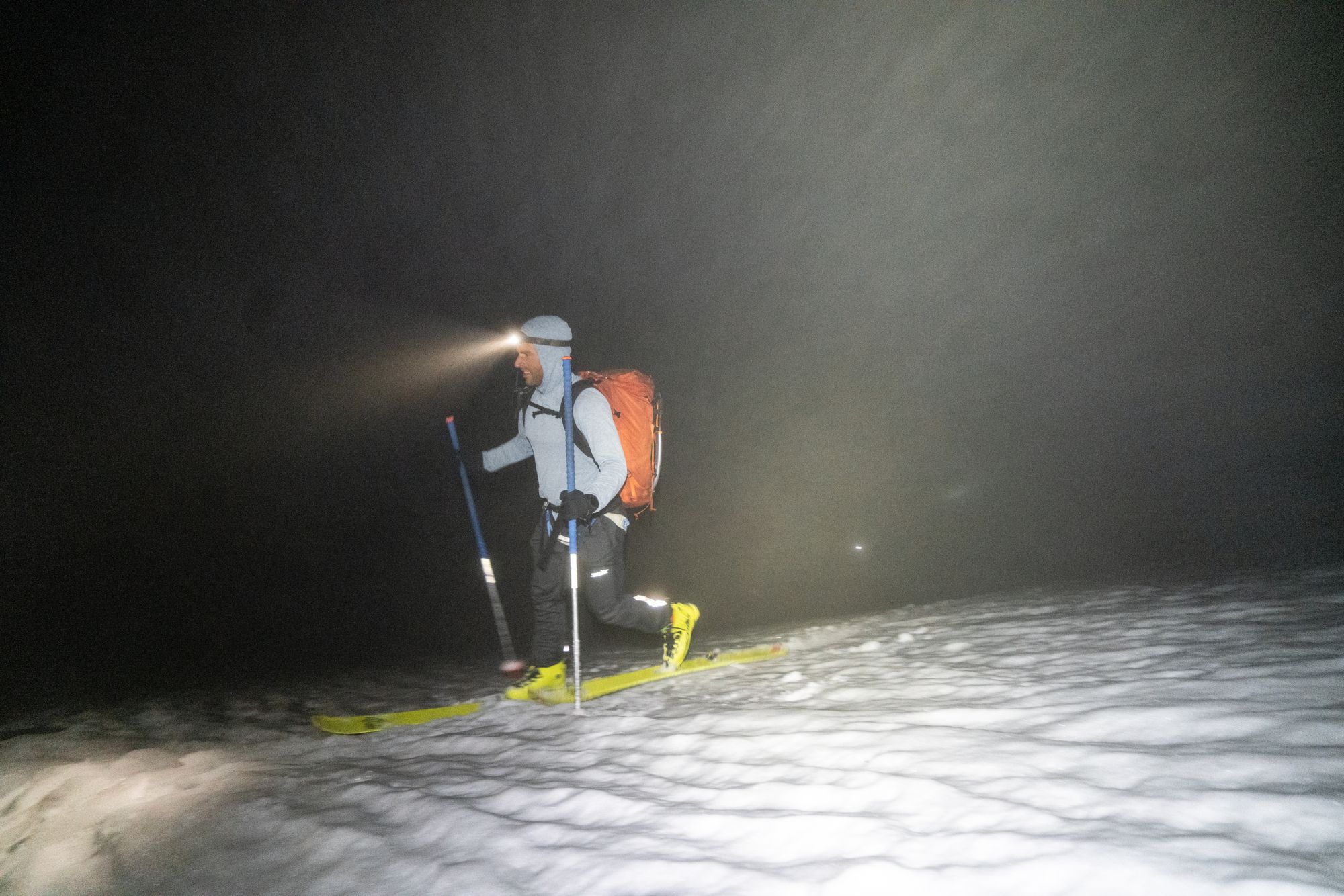
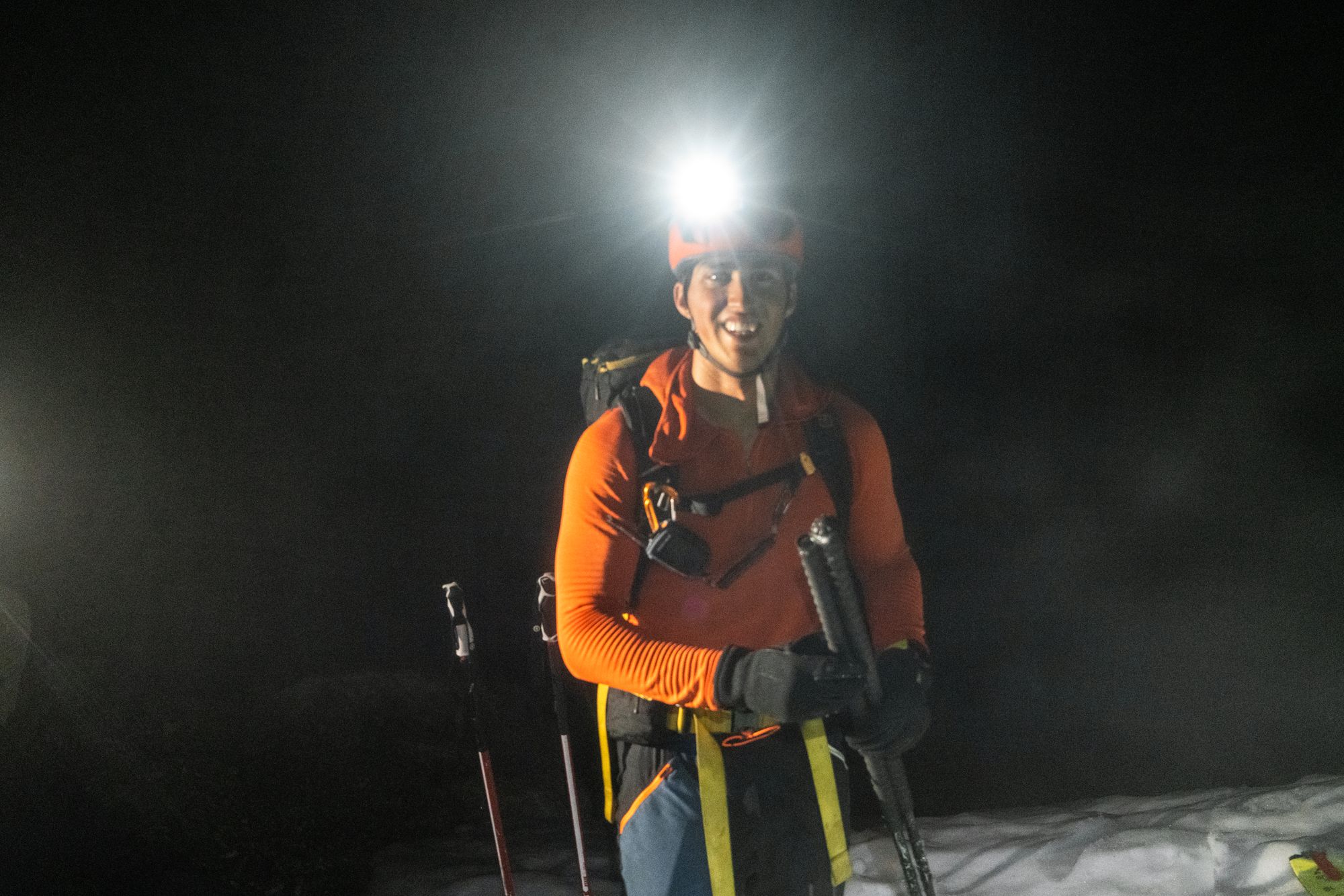
Entering Garnet Canyon (top) and initial switchbacks (bottom)
We discussed turnaround conditions and whether we should descend. With another ~hour until sunrise, we decided to skin to the base of Teepe. If the snow still hadn't refrozen, we'd turn around. We made turnaround conditions explicit, acknowledging that the further we climbed, the stronger the summit fever.
I refueled on a bar / some peanut butter and drank some water. Until that point, I only ate Clif Bloks. Rory knocked down a pepperoni slice. The alpine breeze caught up with us and we added shells.
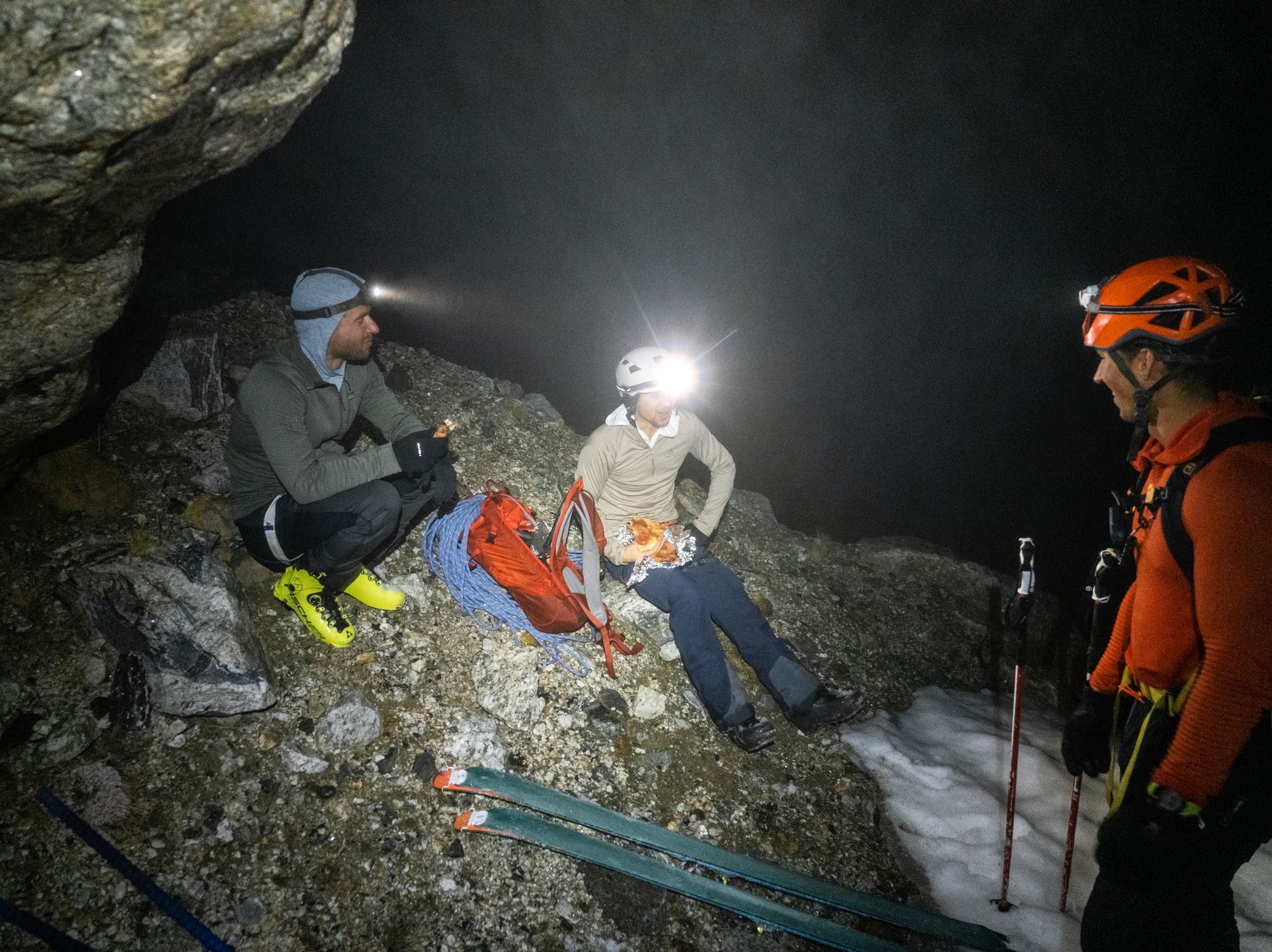

Taking refuge: Xavier, Rory, Sebastian, me (Alex) and Sebastian (again, now wearing his shell) from left to right
In 15-20 minutes, we punched above the clouds. Middle Teton towered to our left in first light. I knew mountains surrounded us, but after ~5 hours in the dark staring at my skis, the granite walls caught me off-guard.
Snow firmed. Over 10,500', ambient heat escaped in the early hours of the morning. Assuming an efficient summit, our biggest risk on descent would be a low-elevation wet slides, mostly avoidable with careful terrain selection.
With firmer snow and a steepening slope below Teepe, I took extra care on kick turns, using poles to anchor my downhill ski. Ski crampons would've been helpful, if not strictly necessary.
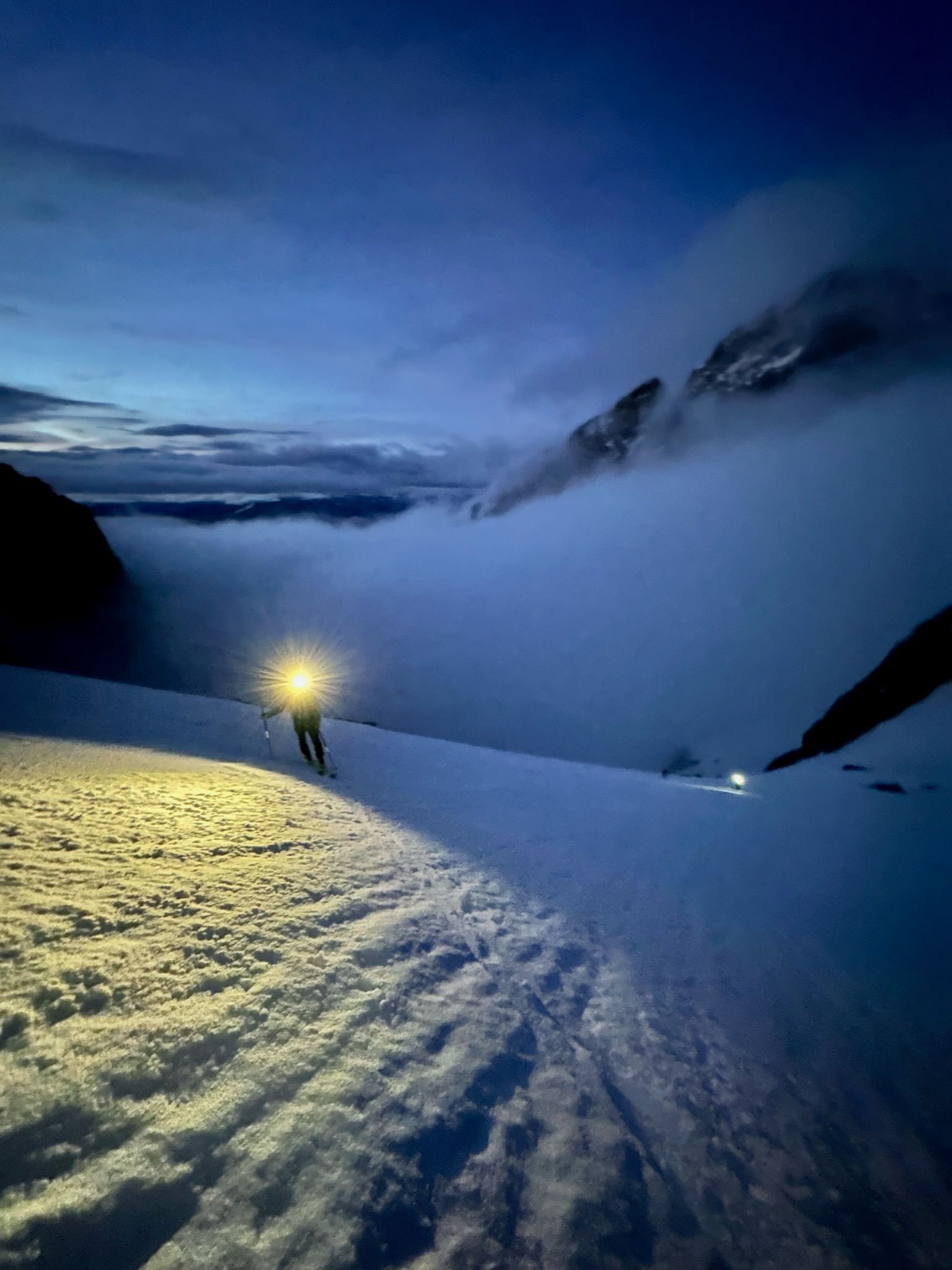

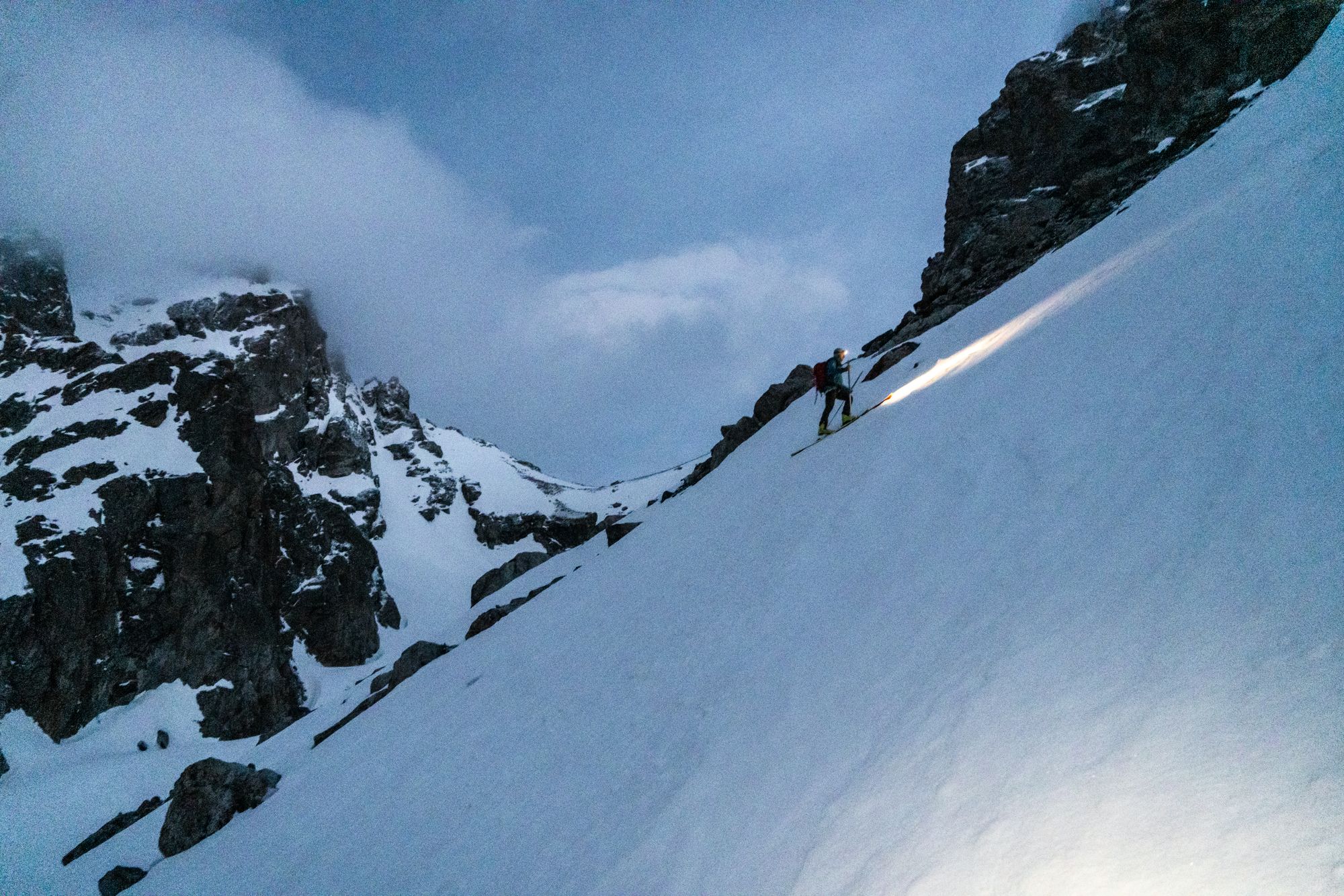
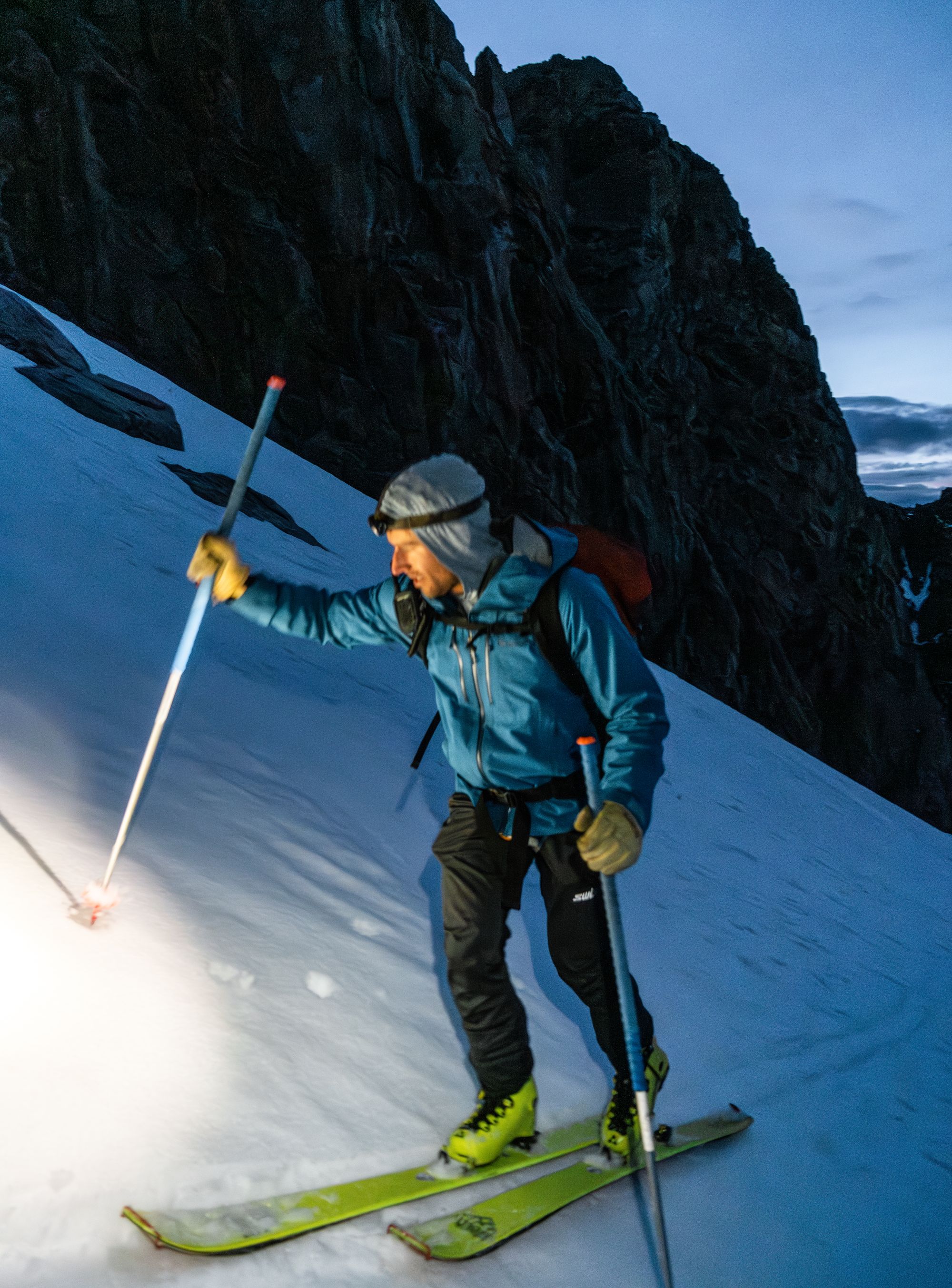
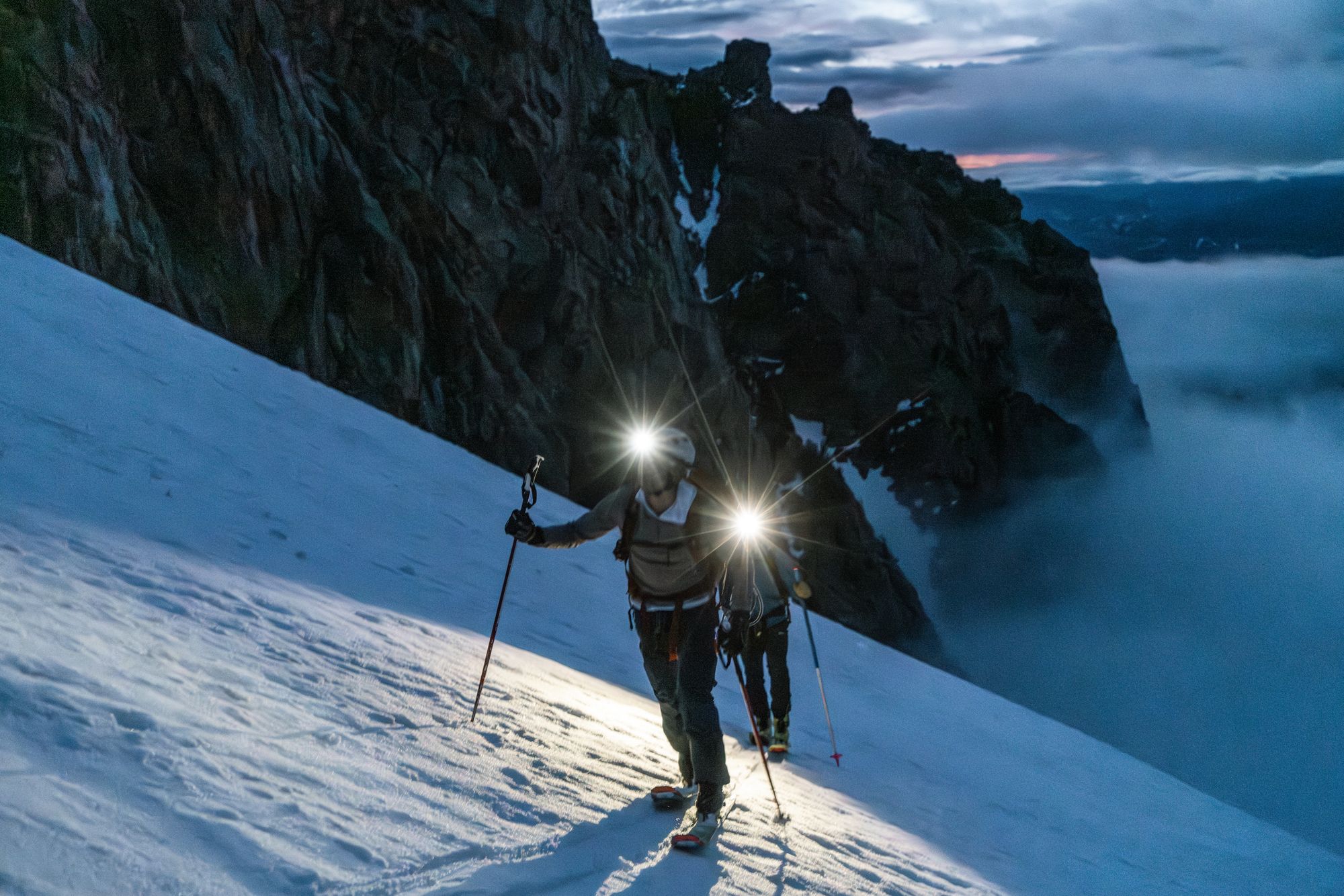
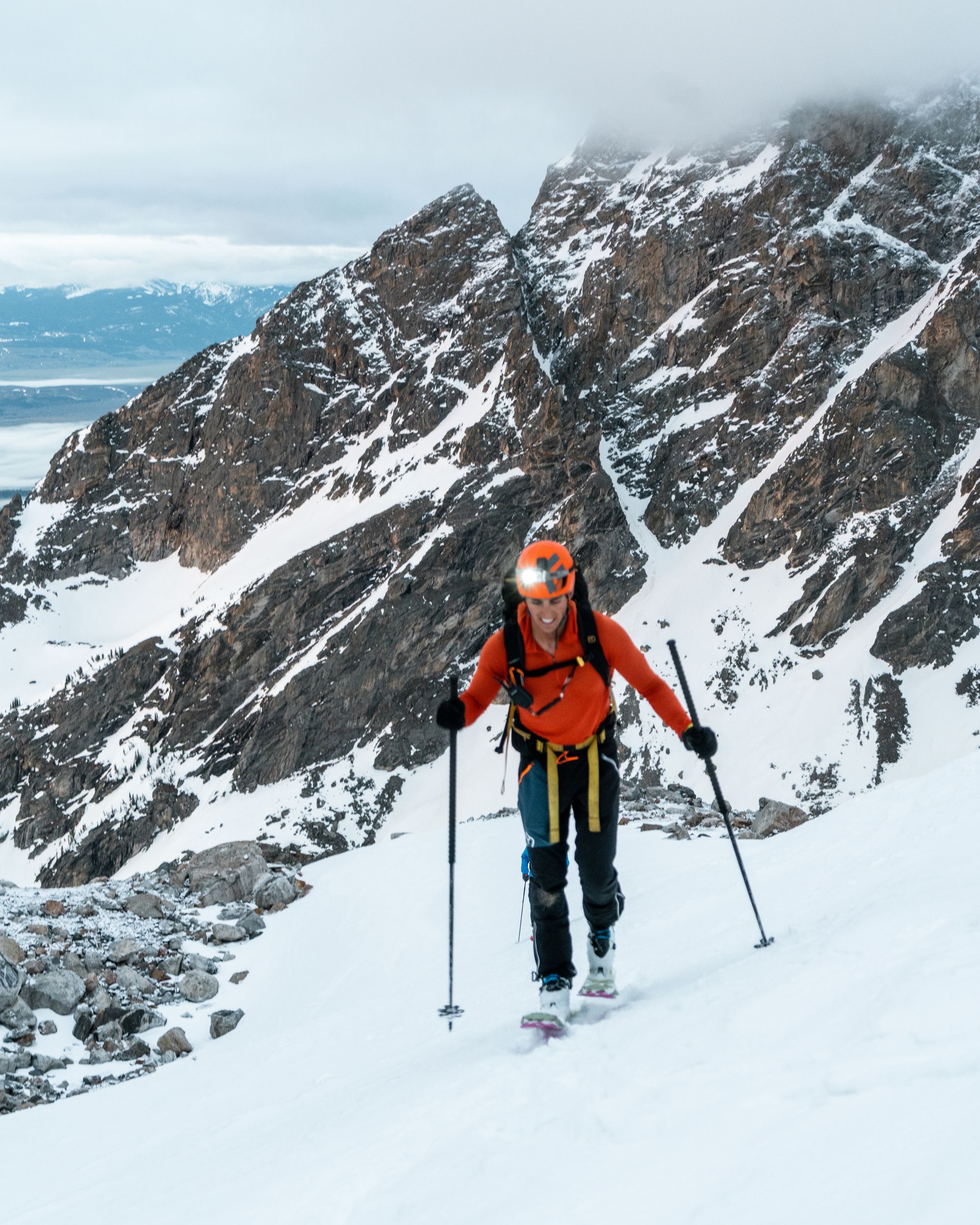
Approaching Teepe Glacier
At 5:45am, we reached the base of Teepe Glacier and decided to attempt a summit. The snow wasn't "bulletproof," but it partially refroze. We strapped skis to our packs. I also swapped lightweight gloves for the insulated, waterproof pair.
As we hiked up the Glacier, an orange spotlight hit Teepe Pillar above, Middle Teton to our left and Nez Perce behind us. Clouds drifted in and out of the summits, above and below. A sunrise for the books.
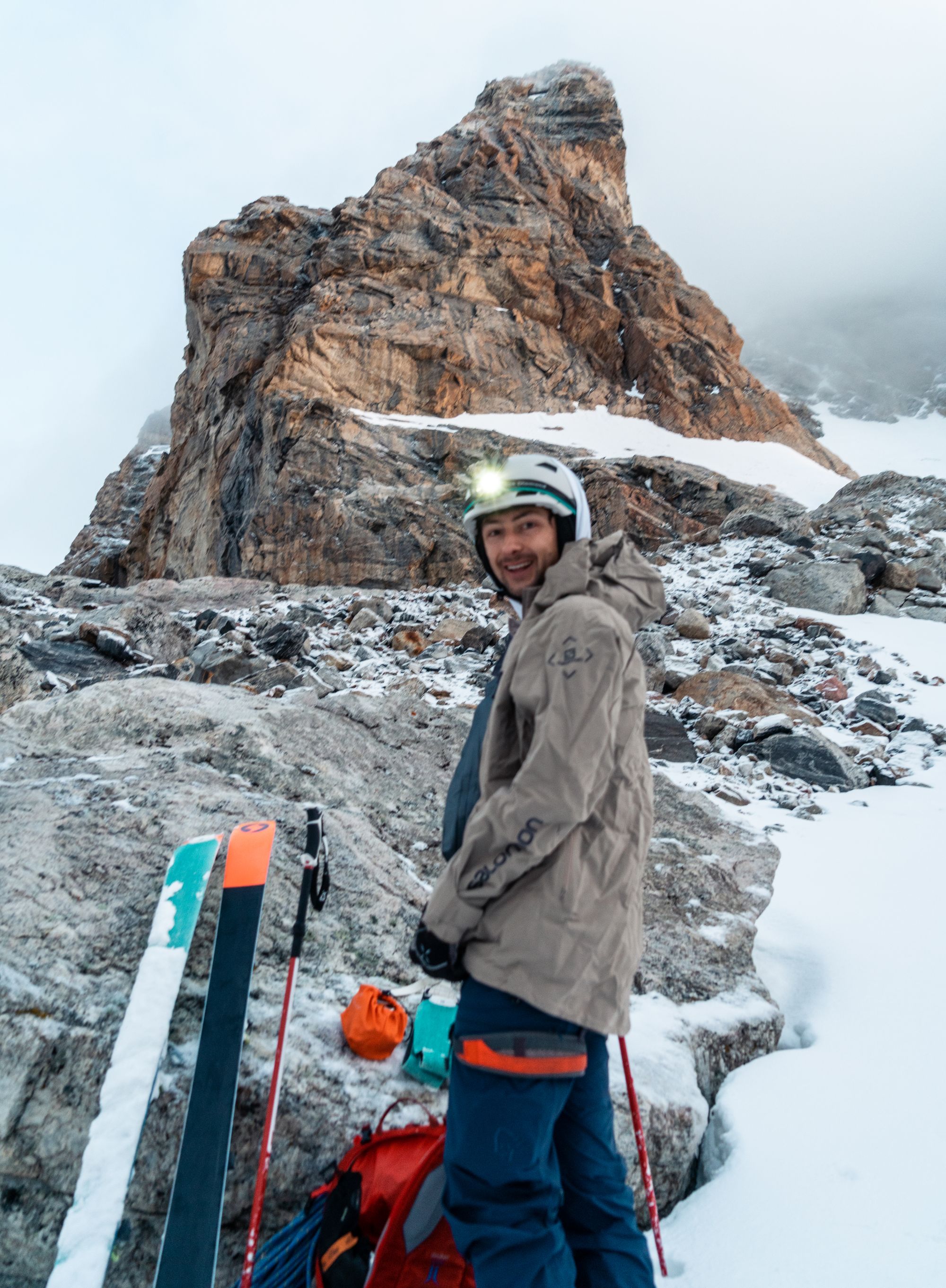

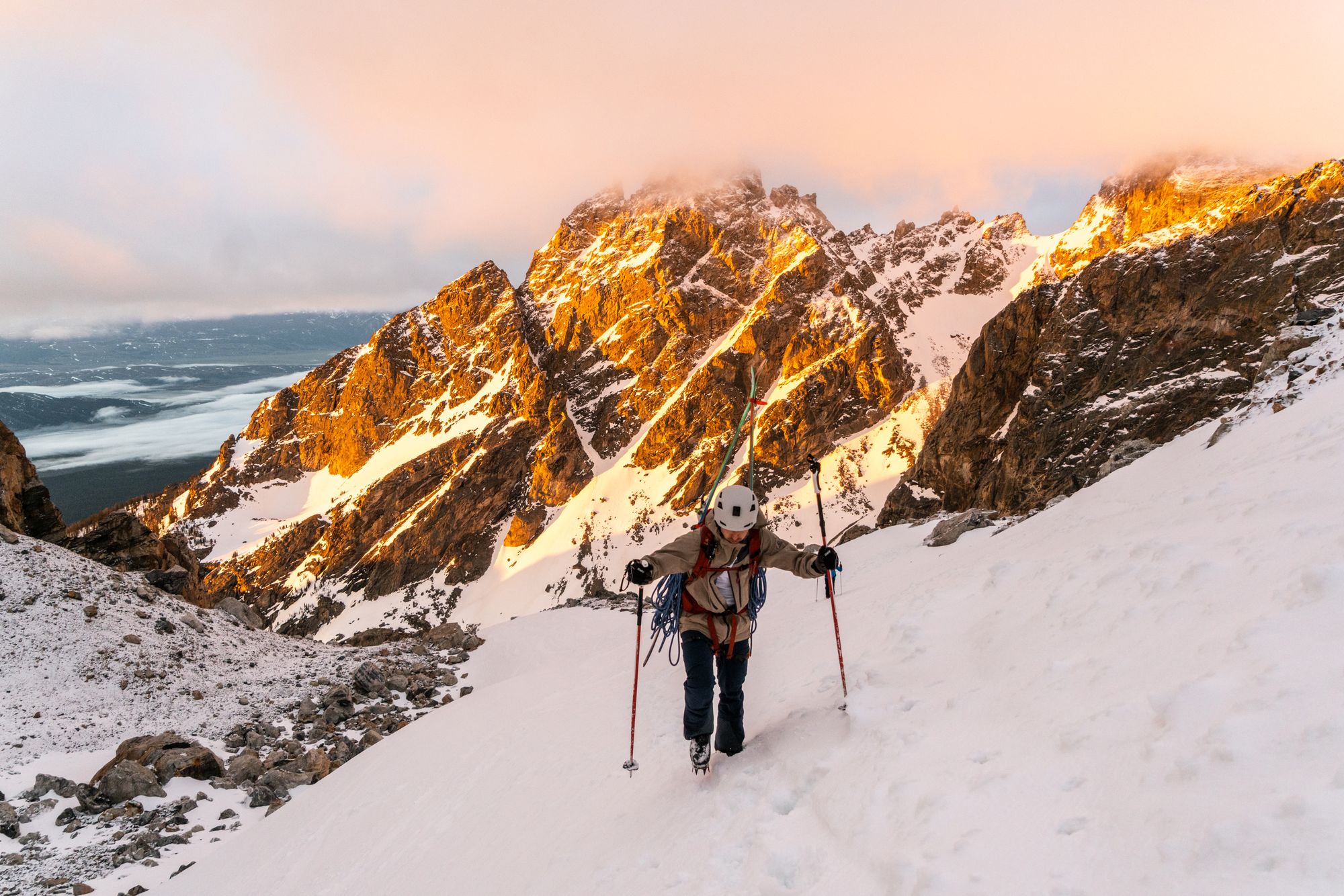
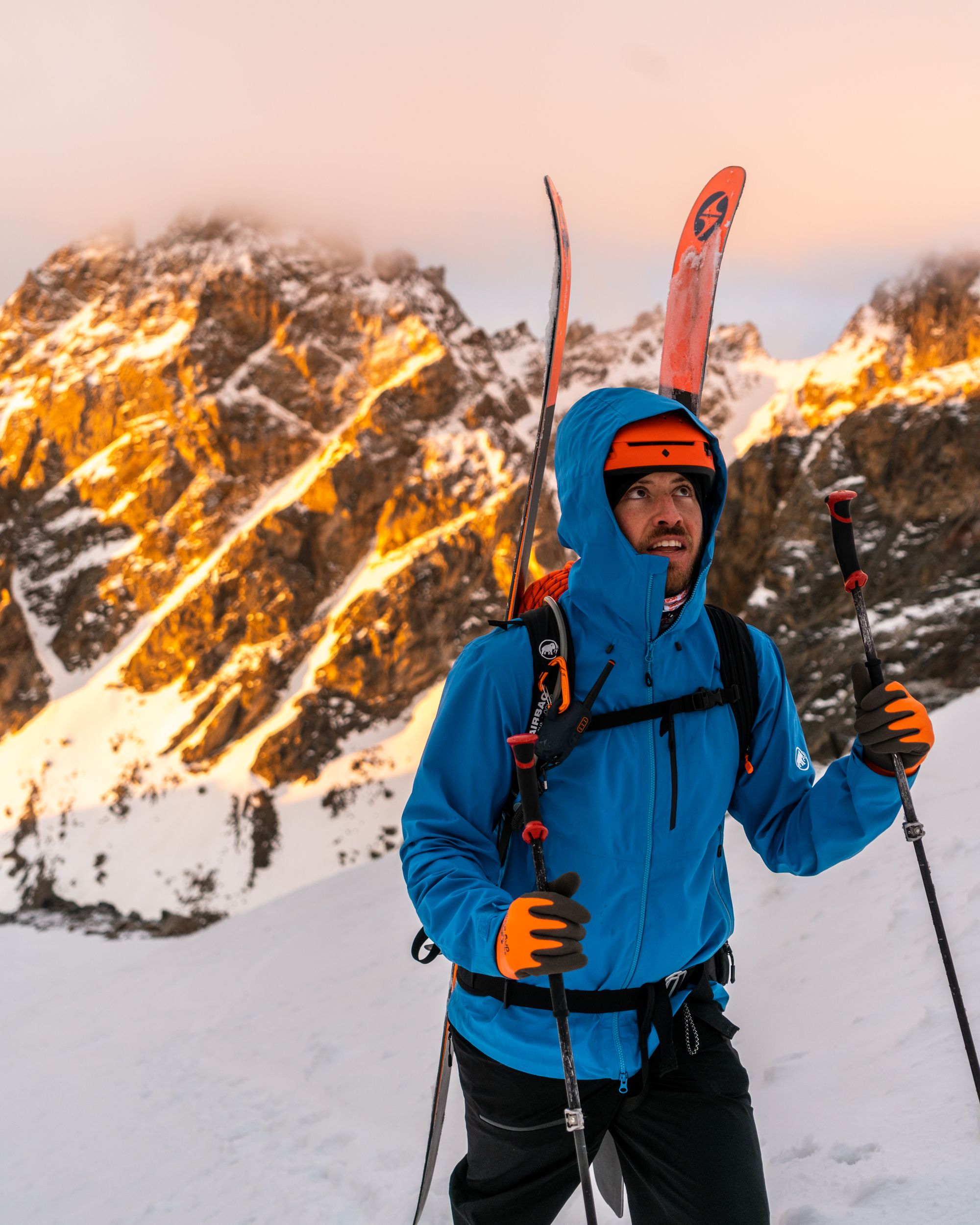
Boot-packing Teepe Glacier
The Teepe's firm snow was perfect for boot-packing. I lost my footing once, easily self-arresting by sliding hands to the baskets of my poles. We reached the top of the Glacier (or maybe not) at 6:45am. Rory was sprinting, a full 15 minutes ahead, 4pm flight to San Francisco top of mind.
In the saddle between the Grand and Teepe Pillar, we added boot crampons, swapped ski poles for ice tools and stumbled into harnesses. We scrambled, then traversed an exposed slope to the next saddle between Glencoe Spire and the Grand. Turning right, we entered the long-awaited Ford-Stettner route.

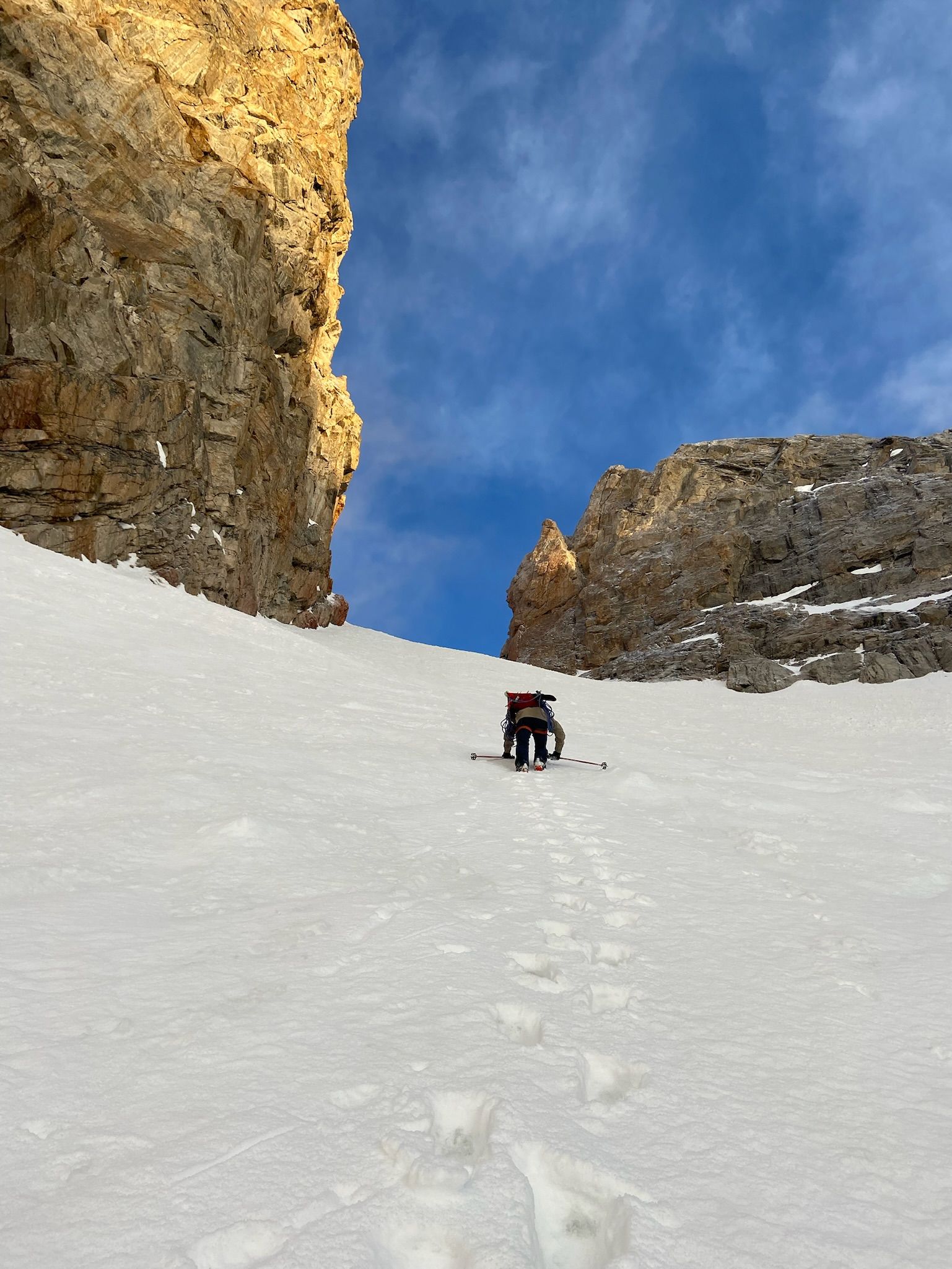

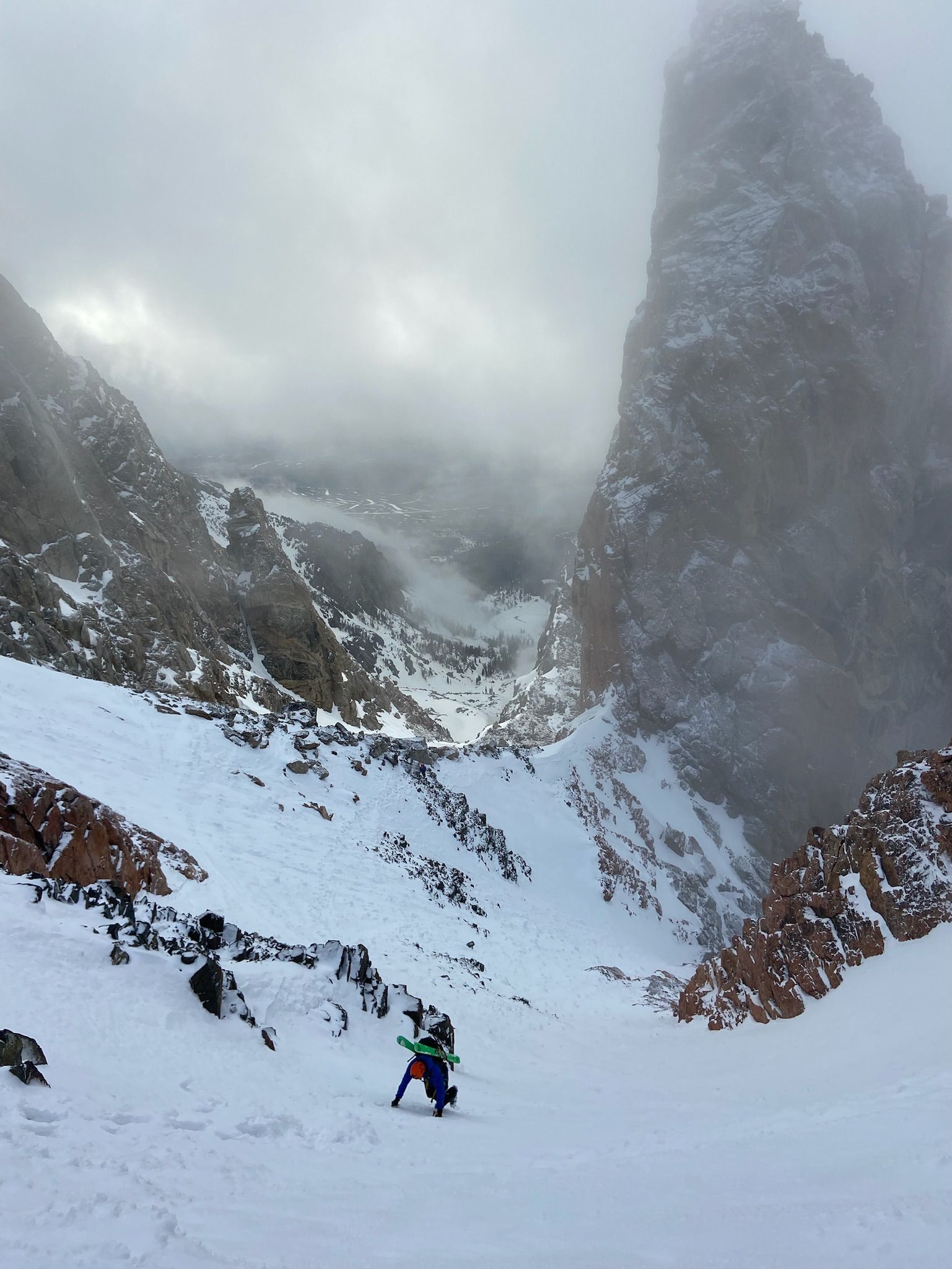
Teepe Glacier boot-pack and traverse to the Stettner
Don't Look Down
Connor and I followed Xavier and Sebastian up Stettner Couloir. Over the radio, Rory asked where to expect the Chevy Couloir turn. He almost blew past the suspected entrance, luckily only needing to downclimb a few feet. (He almost followed Bill Briggs' first descent path, full-Stettner.)
In the Stettner, I began to appreciate the route's consequences. A misstep without a quick self-arrest would parachute a climber to the Moraine below. The snow was still high-quality for booting – firm, not bulletproof – and crampons / tools made for a secure and efficient ascent.

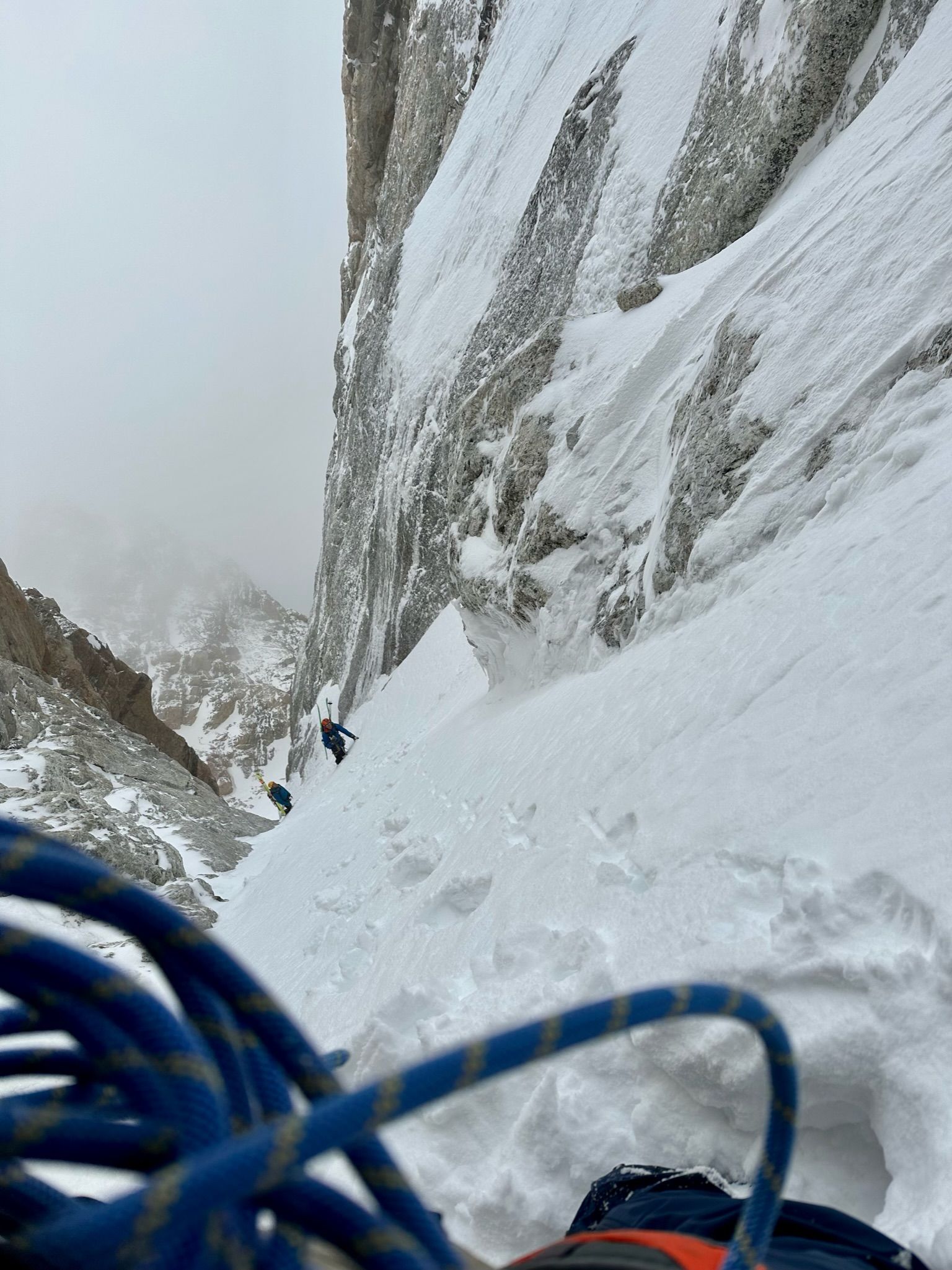
Stettner Couloir from the bottom (left) and Chevy turn-off (right)
At 7:30am, Sebastian caught up with Rory, calling out conditions in the Chevy over the radio. He compared it to blue ice in Mt. Hood's Pearly Gates, to which Xavier replied, "It's that chill?"
Before Xavier could claim the privilege, Sebastian started free soloing. Xavier would lead Rory, still perched mid-Stettner waiting for us to catch up. Mid-way up the Stettner, the four of us waited for Sebastian to clear at least a pitch, ice tools and crampons holding us on the steep snow. Xavier uncoiled one of his ropes.
After ~5 minutes, Xavier climbed, while Rory belayed. He reached the top of the first pitch in a few minutes. As he transitioned to top-belay Rory, Connor and I readied our ropes and ATCs (recommend the Guide for lead belays). Rory unclipped their rope from draws as he followed, but left the screws.
As soon as Rory reached the first anchor and clipped in his PA, Connor started climbing, belayed by me. He clipped the rope into draws on the ice screws Xavier placed at the bulges. In the interest of time, each team used only one half rope. We could have doubled up, but Connor and Xavier would have been comfortable soloing, and we were trying to make up lost time.
We found at least two washer-sized ice bulges along the two Chevy pitches. The climbing itself was much easier than our practice icefalls in Hyalite. But thousands of feet of exposure and a ~6,000' ascent made each move feel more substantial. My calves screamed on the bulges. Flipping boots to ski mode might've helped.
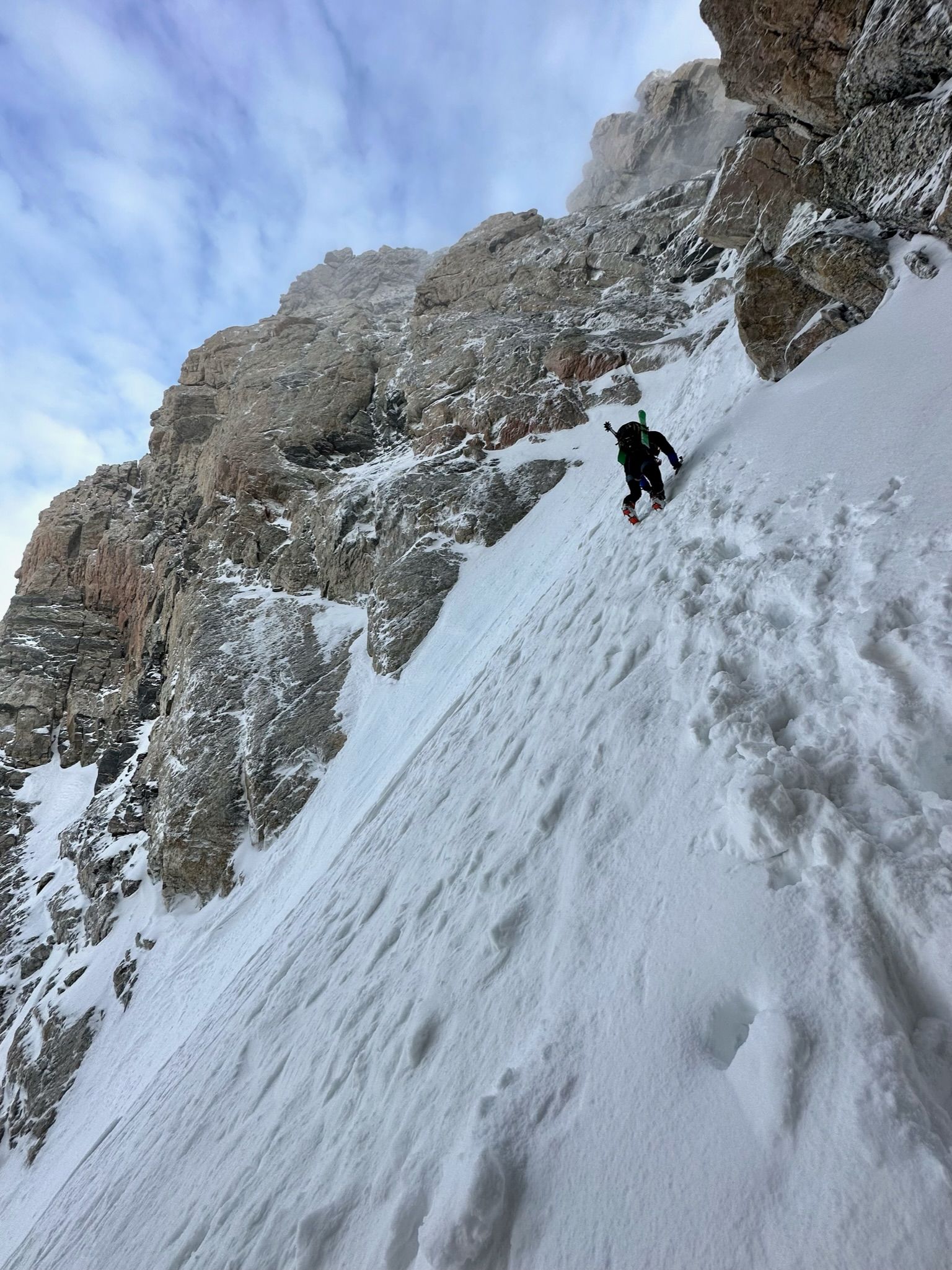

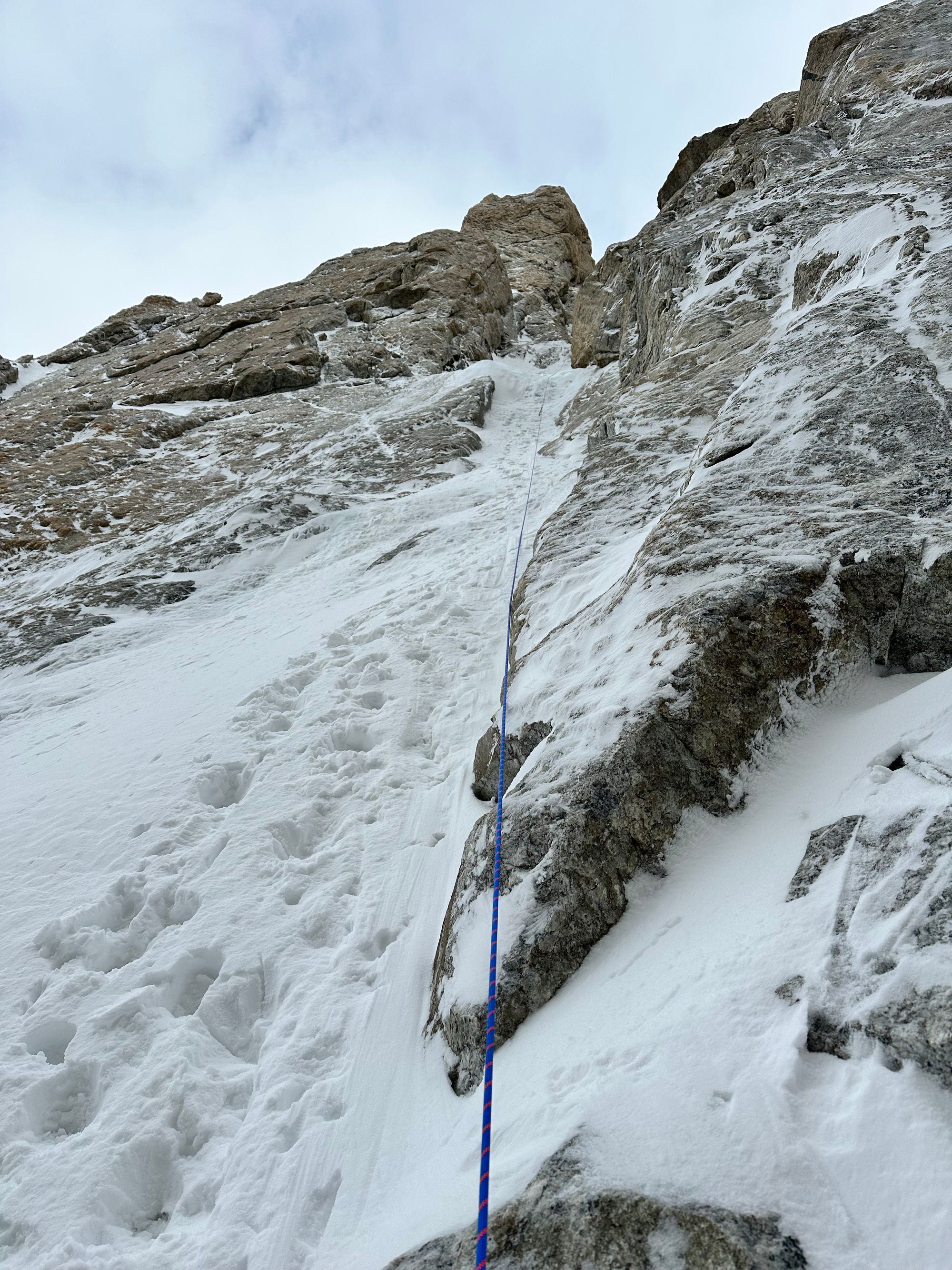
Chevy Couloir
By 9:15am, I reached Connor at the end of the second pitch. Managing a large group on a roped Chevy ascent slowed us down. A free solo group could've cleared the couloir in 30-45 minutes.
Usually groups free solo again at that point, but with a rope already out, I belayed Connor to the Ford rappel anchor. We left ropes at that anchor to save weight on the final boot-pack. (Halfway up the Ford, I realized I forgot to ditch mine...)
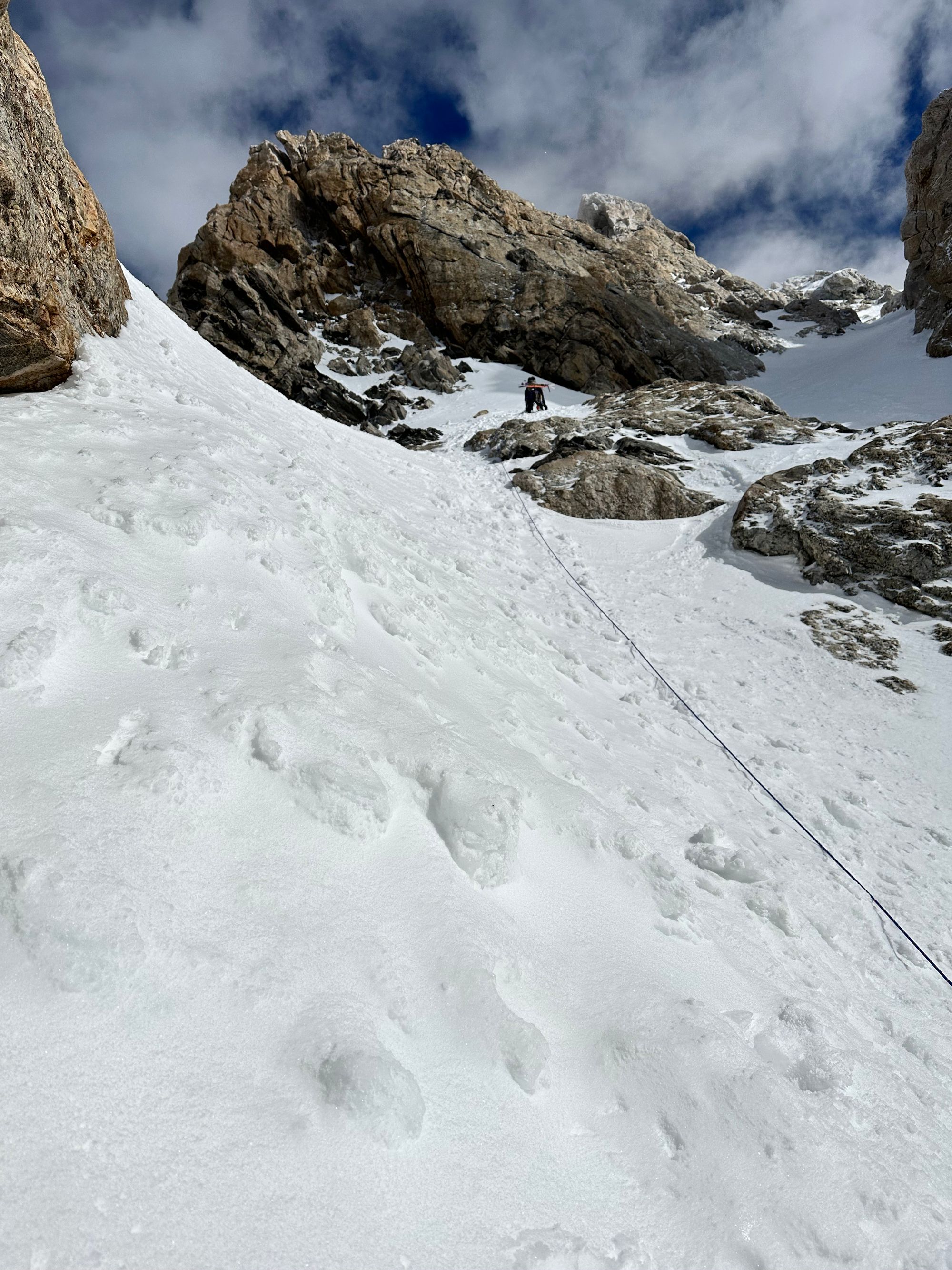
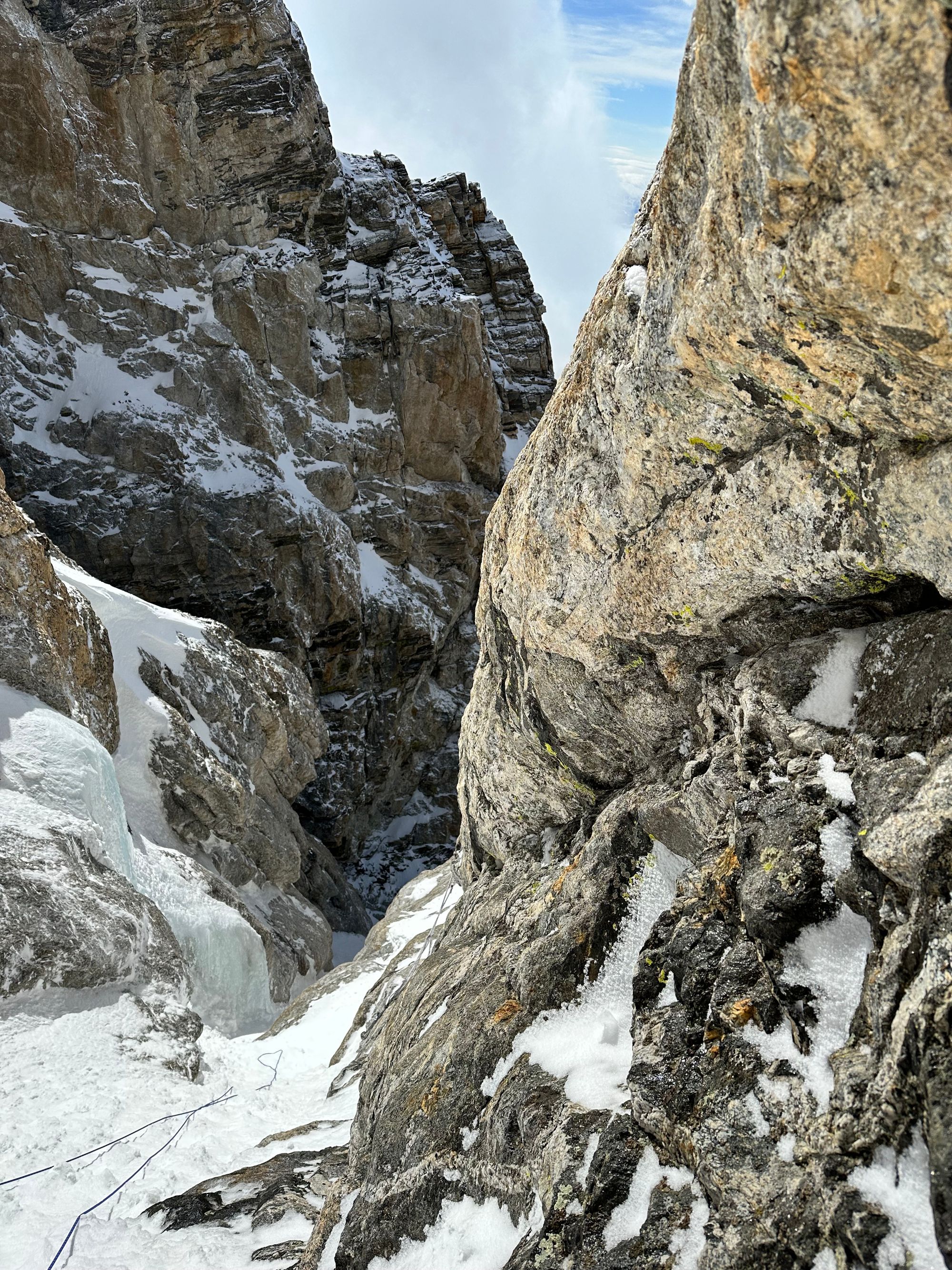
Final belay to the Ford rappel anchor (left) and looking down into the Chevy (right)
Group one – Sebastian, Xavier and Rory – were already boot-packing up the Ford. By 9:40am, Connor and I stashed gear at the anchor and started up the Ford.
The Grand was largely in the clouds after sunrise, buying us a couple extra hours. (We were late.) As we neared the Ford, some spring sun poked through, but aside from that brief warming, clouds kept the snow cool. At 13,000', it wasn't quite "corn-o-clock." In Garnet Canyon, it was "mashed potatoes-o-clock."
Halfway up the Ford, at ~10:15am, group one called over the radios. They summitted and were ready to descend. Connor and I took cover behind rocks to skier's left / looker's right and snapped pictures as they skied past.
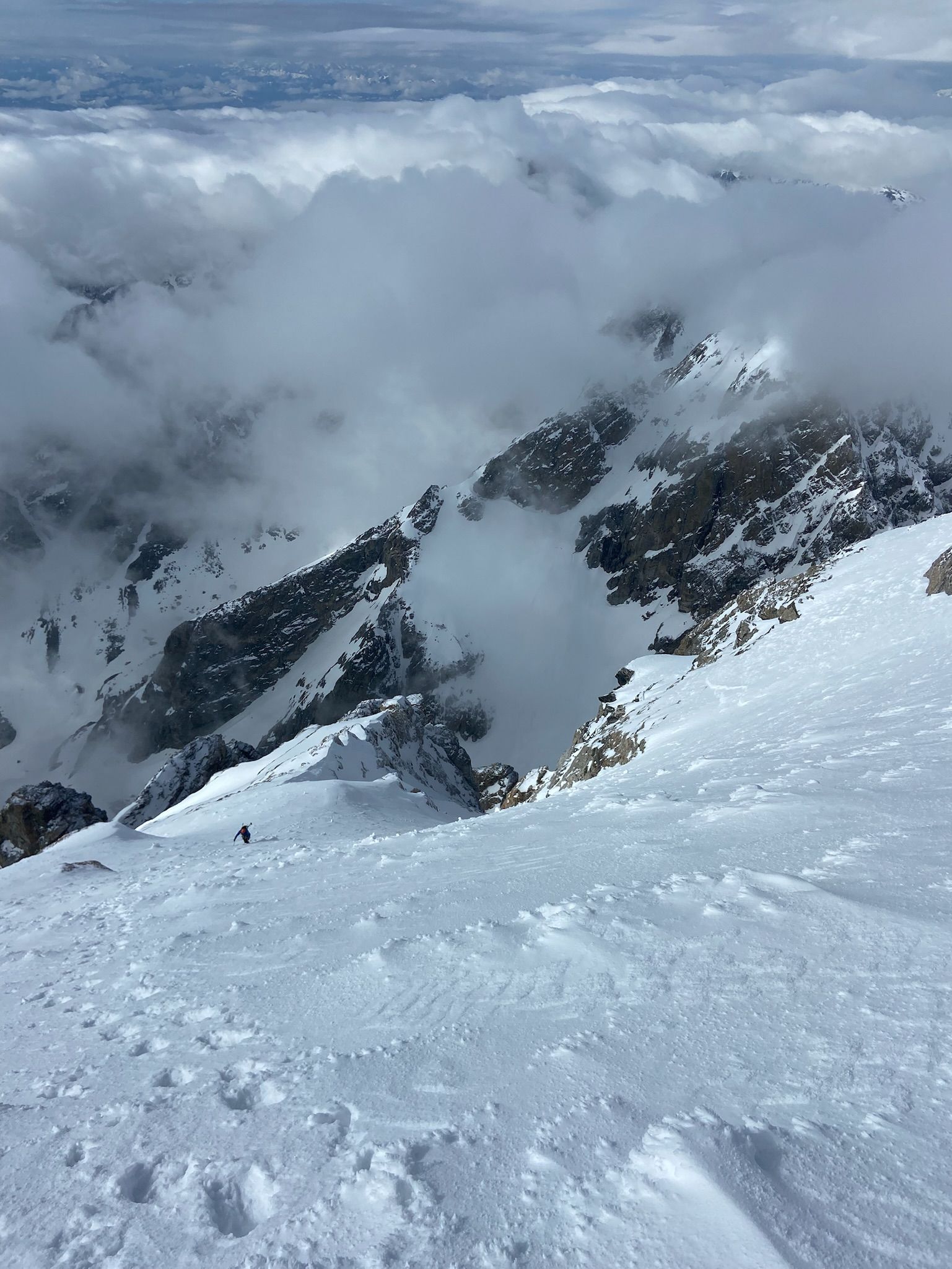
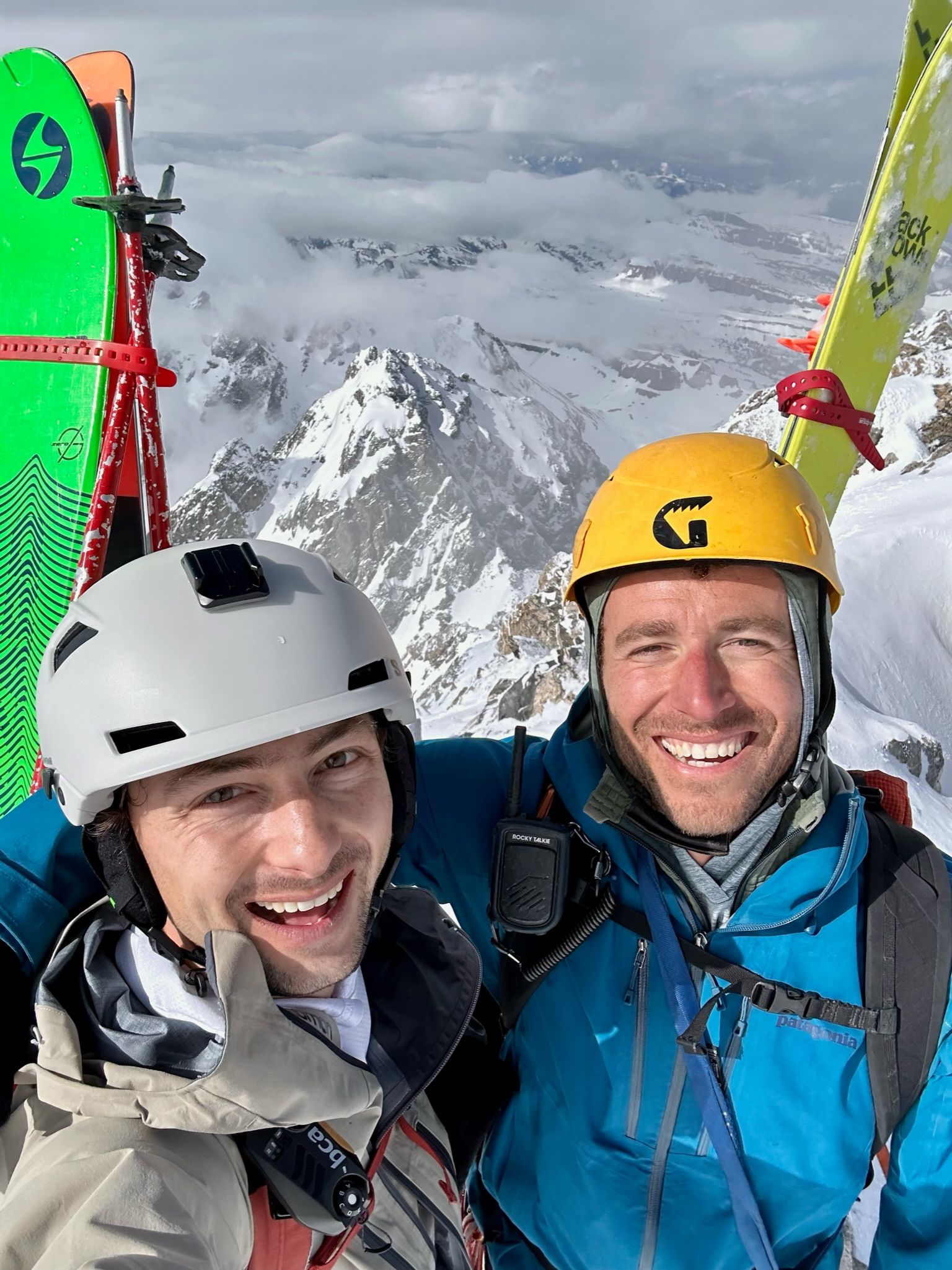
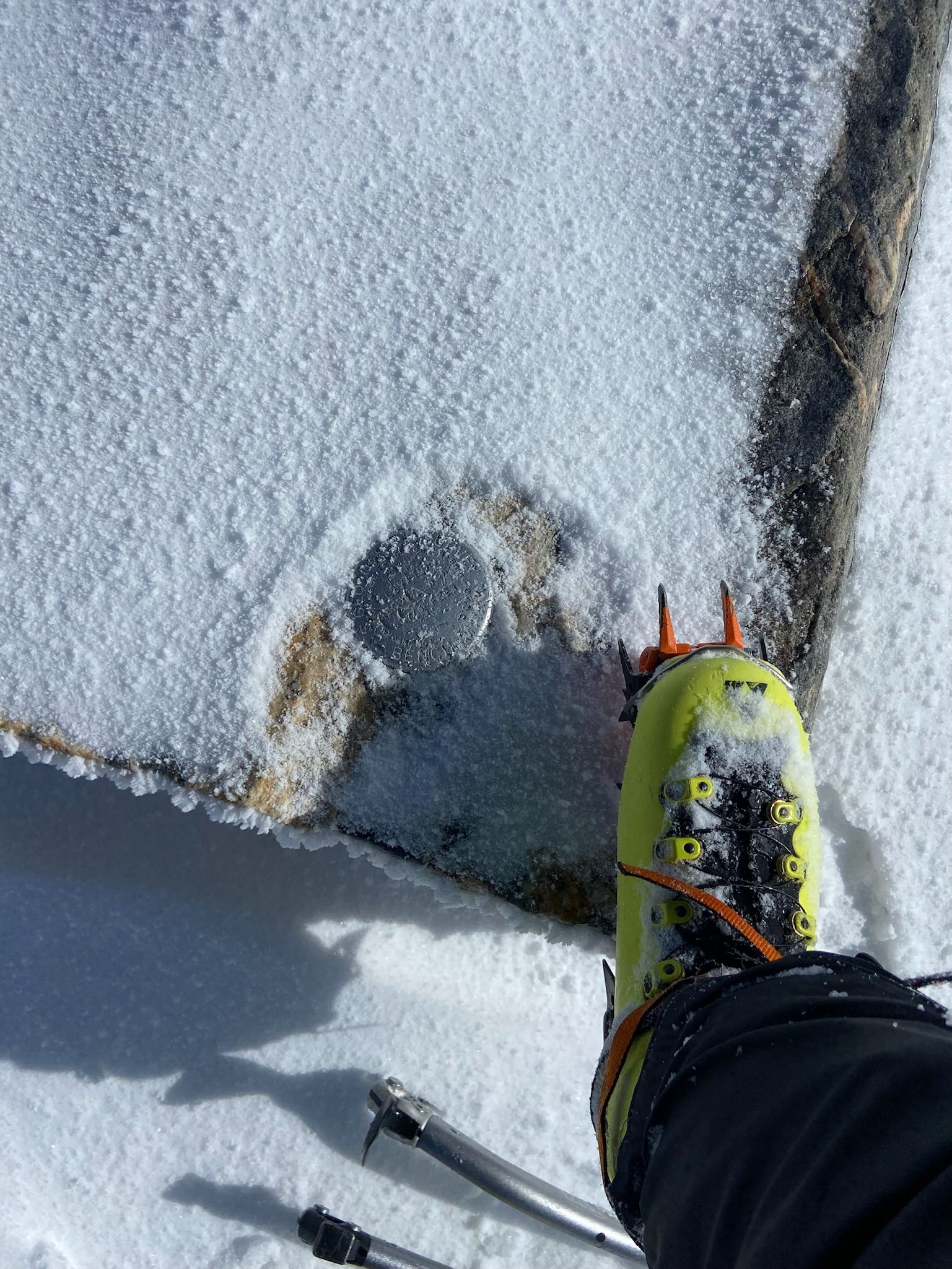
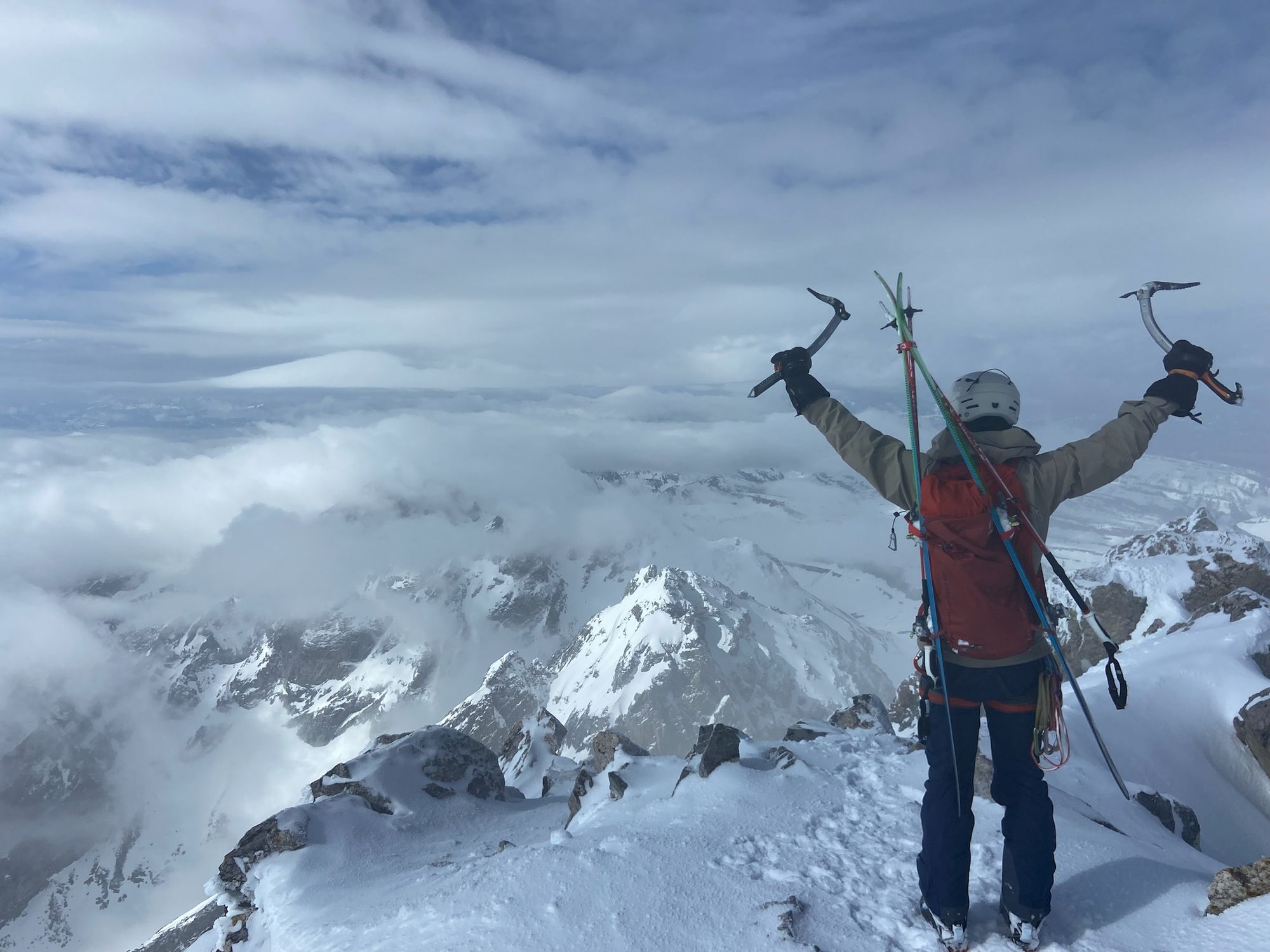
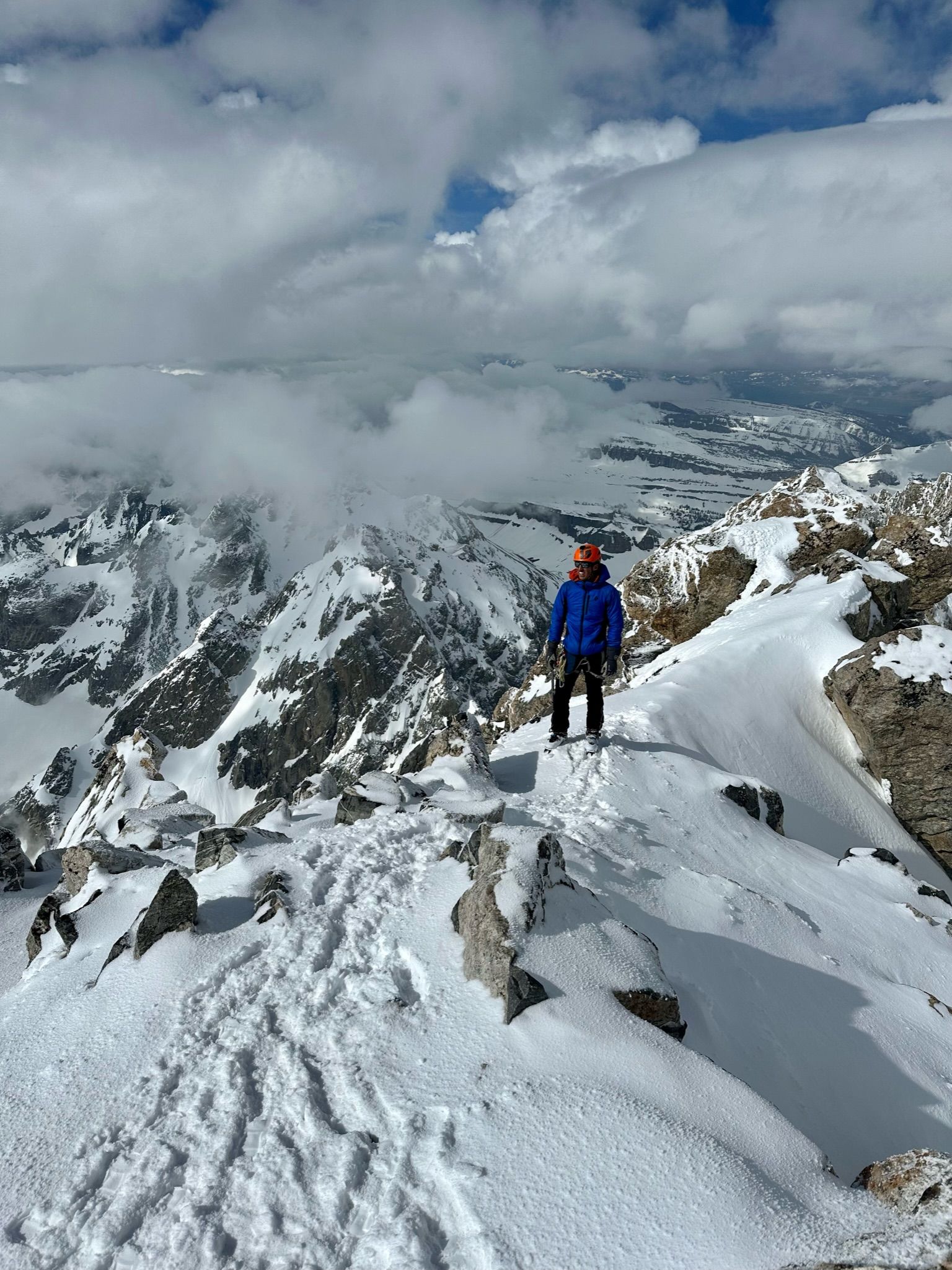
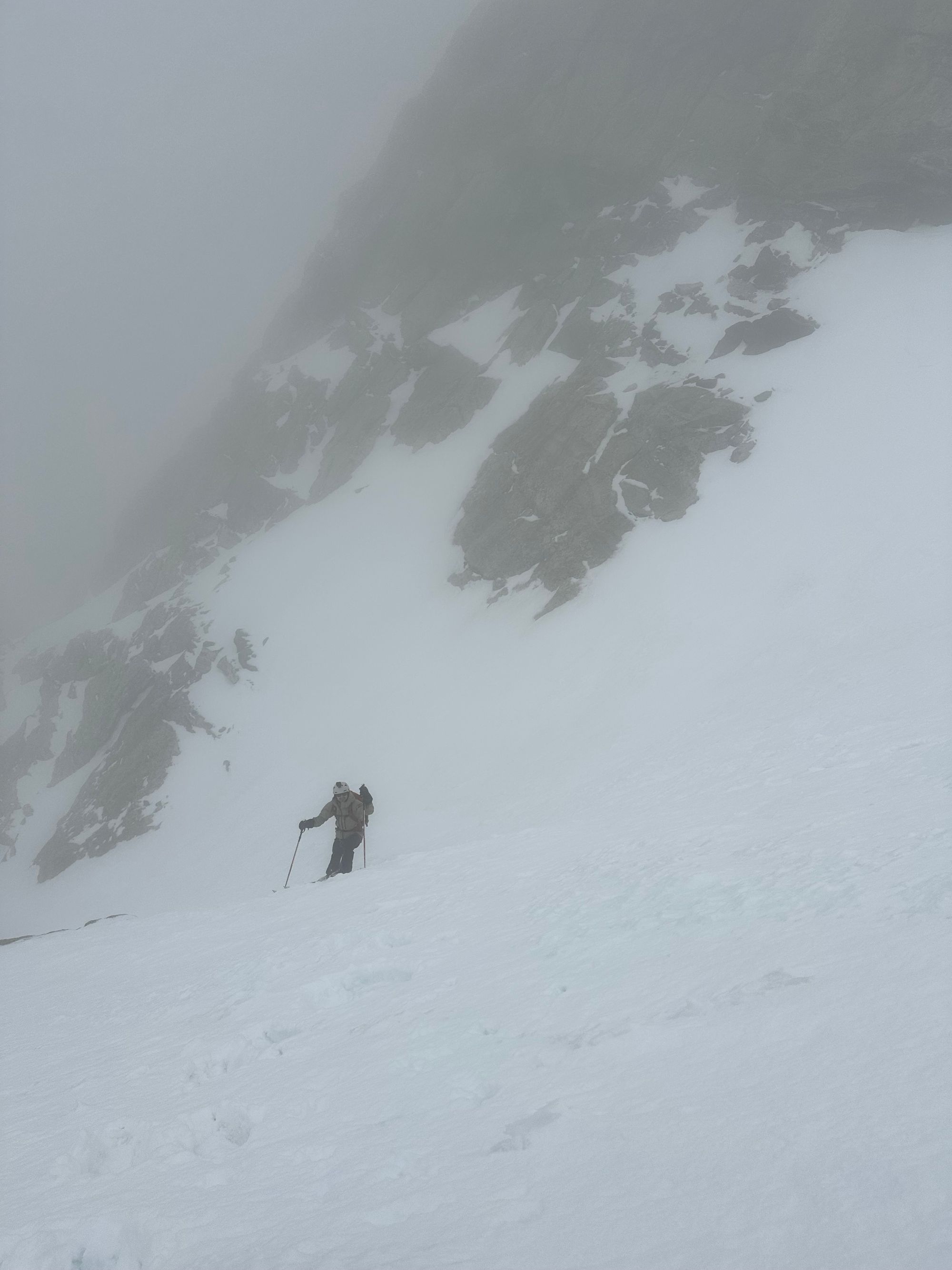
Group one (Xavier, Sebastian and Rory) summiting and skiing the Ford, clouds briefly parting up top
The Ford was a straightforward, though exposed, 1,000' boot-pack. But after all that elevation gain and moving time, each step felt like four. Time on the couch post-MCL sprain didn't help.
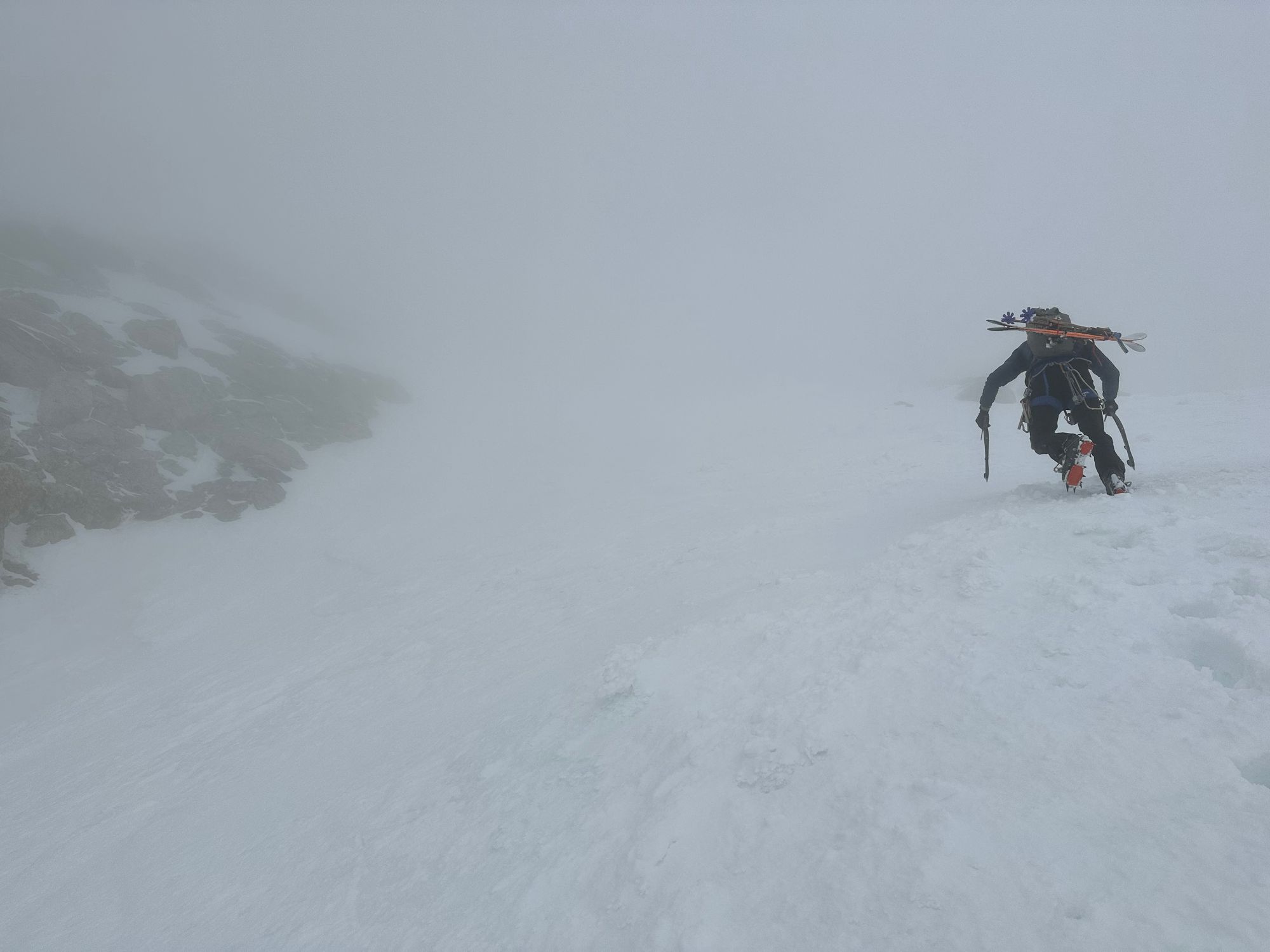
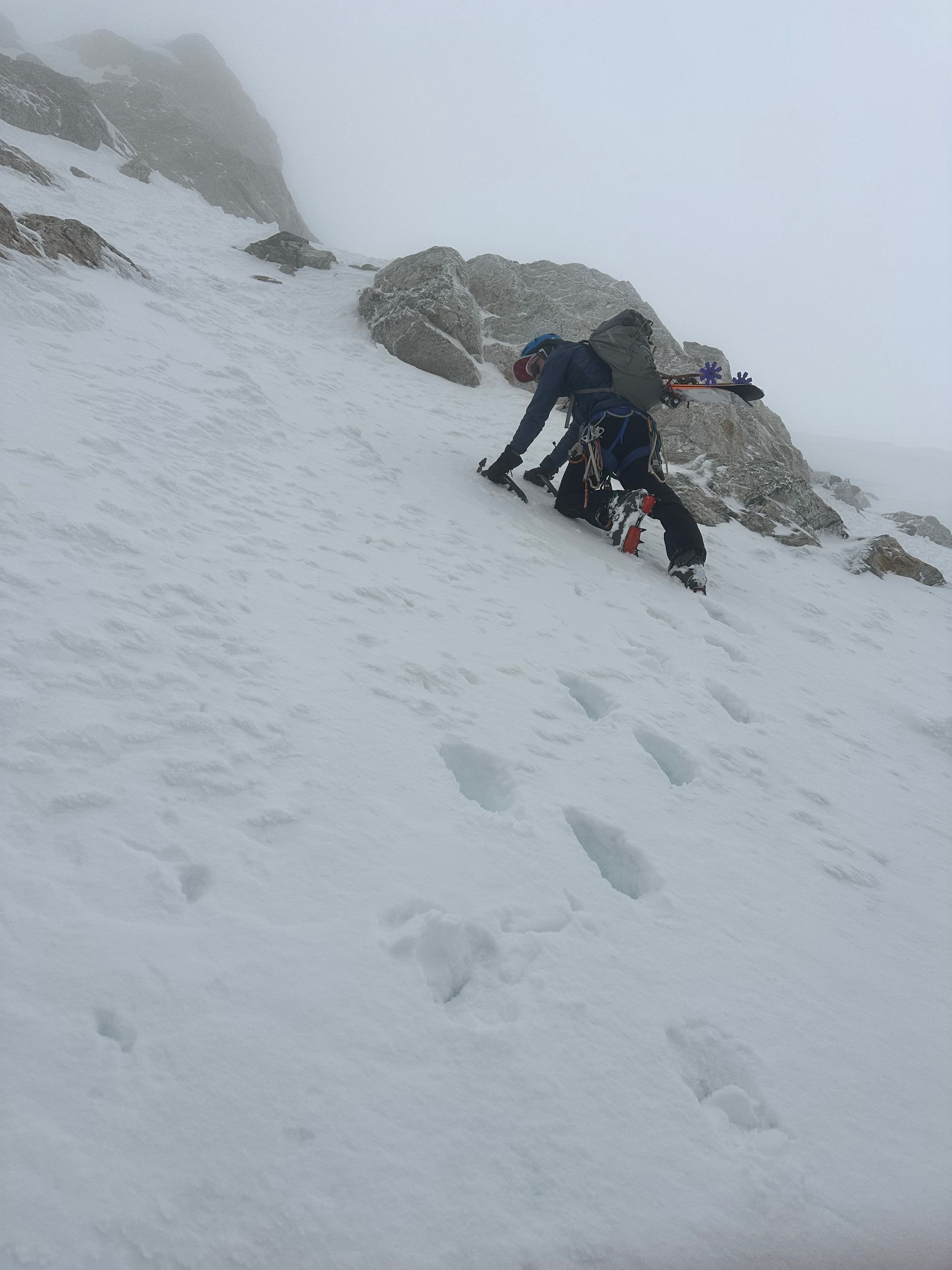
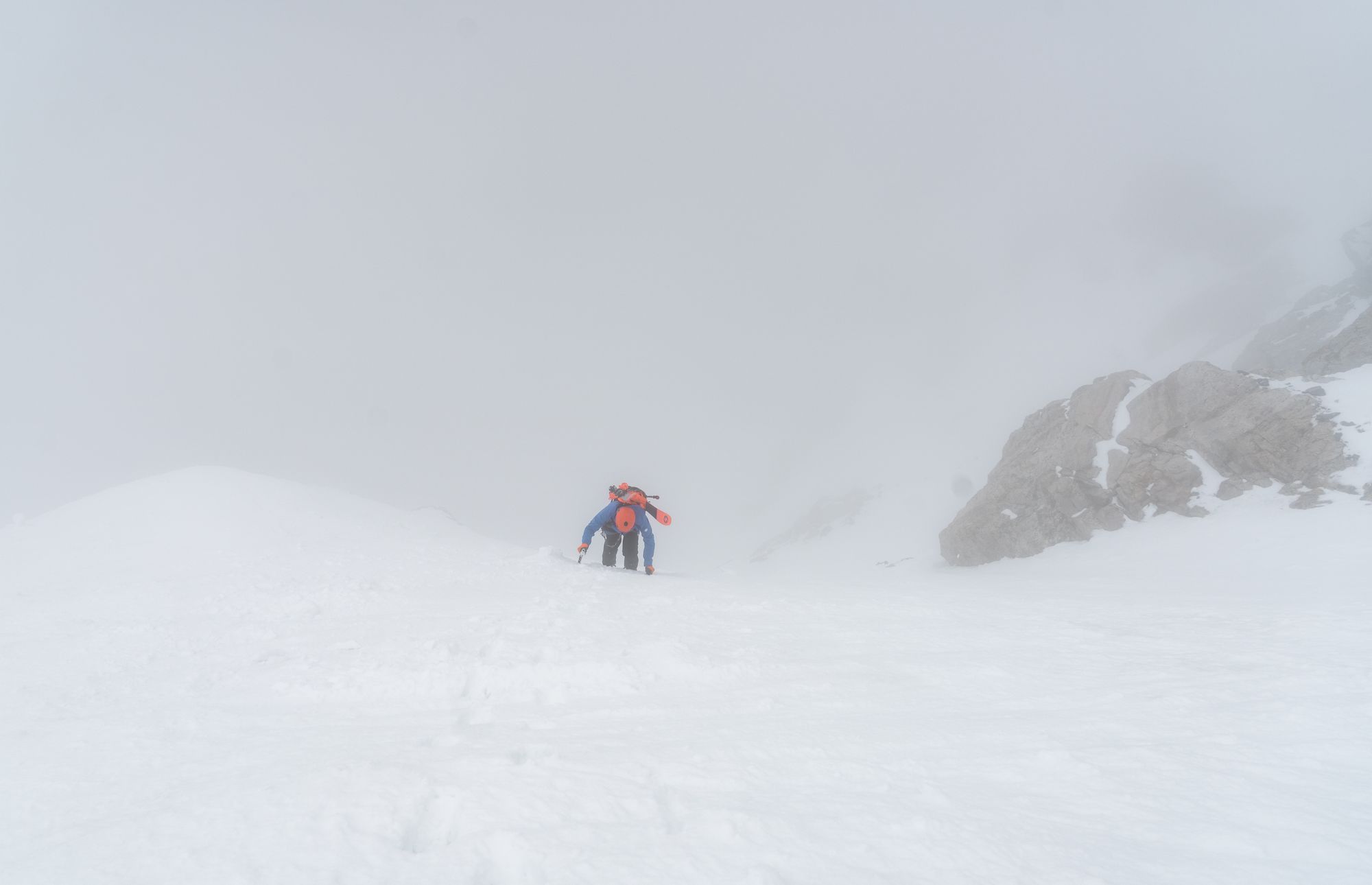
Me and Connor boot-packing up the Ford, back in the clouds
At 11:15am, we reached the summit block. Clouds broke just before we summitted and started heating the snowpack. We watched patches of snow and ice slide off boulders, frozen solid only minutes before.
Scattered clouds surrounded the summit from 11,000-14,000'. Between them, we could see portions of the Teton range to the south and north, Jackson Hole and Teton Valley to the east and west.
Clock ticking, we soaked up the views, snapped a couple photos and scarfed down calories / water, including a few handfuls of celebratory Goldfish.
Nerves and a sense of urgency replaced our relief from summitting. We needed to ski the exposed East Face and Ford Couloir, then rappel through the Chevy and Stettner before wet-slide risk became untenable.
I created a poor-man's whippet with a ski pole, ice tool and ski strap, and transitioned my boots to ski mode.
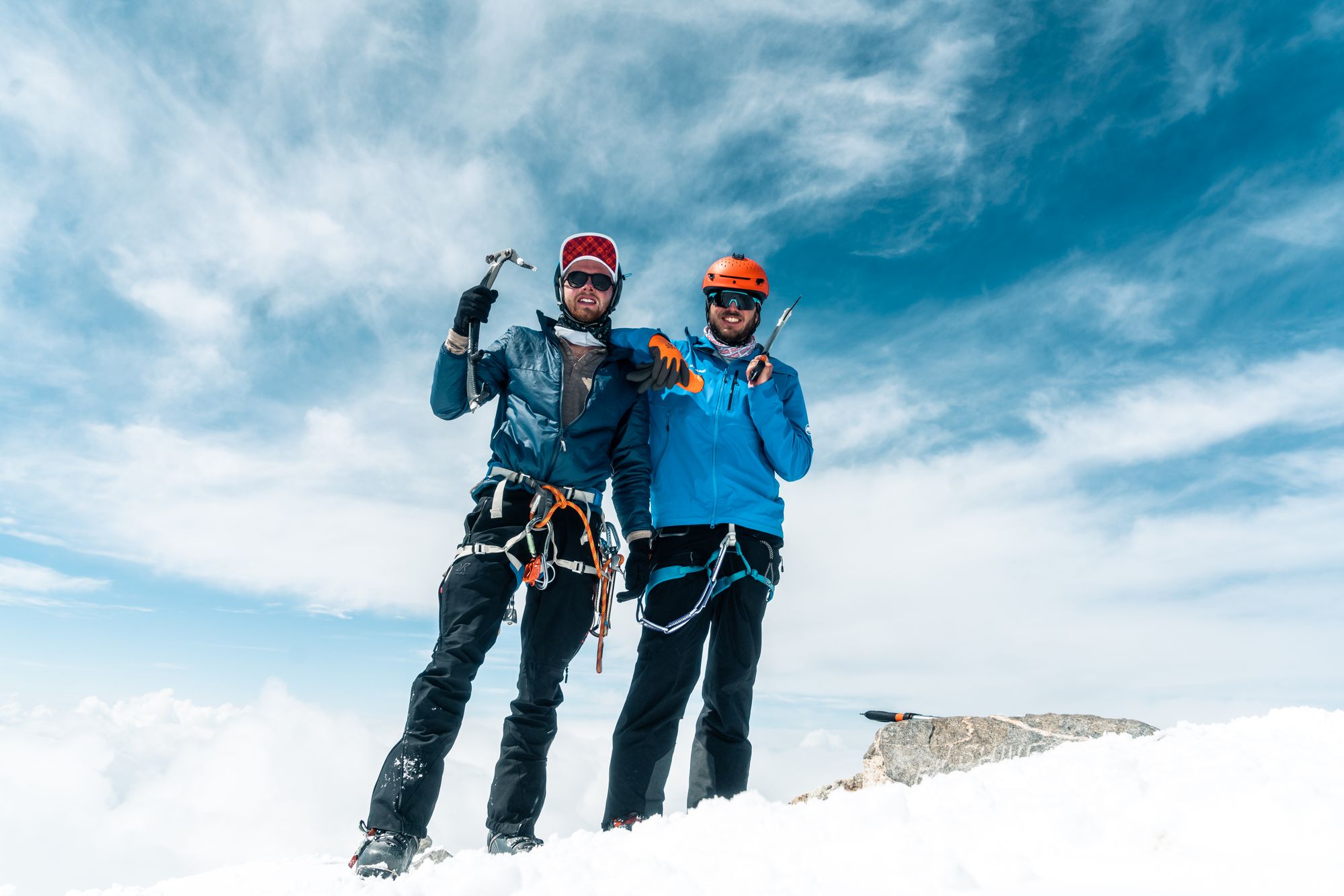
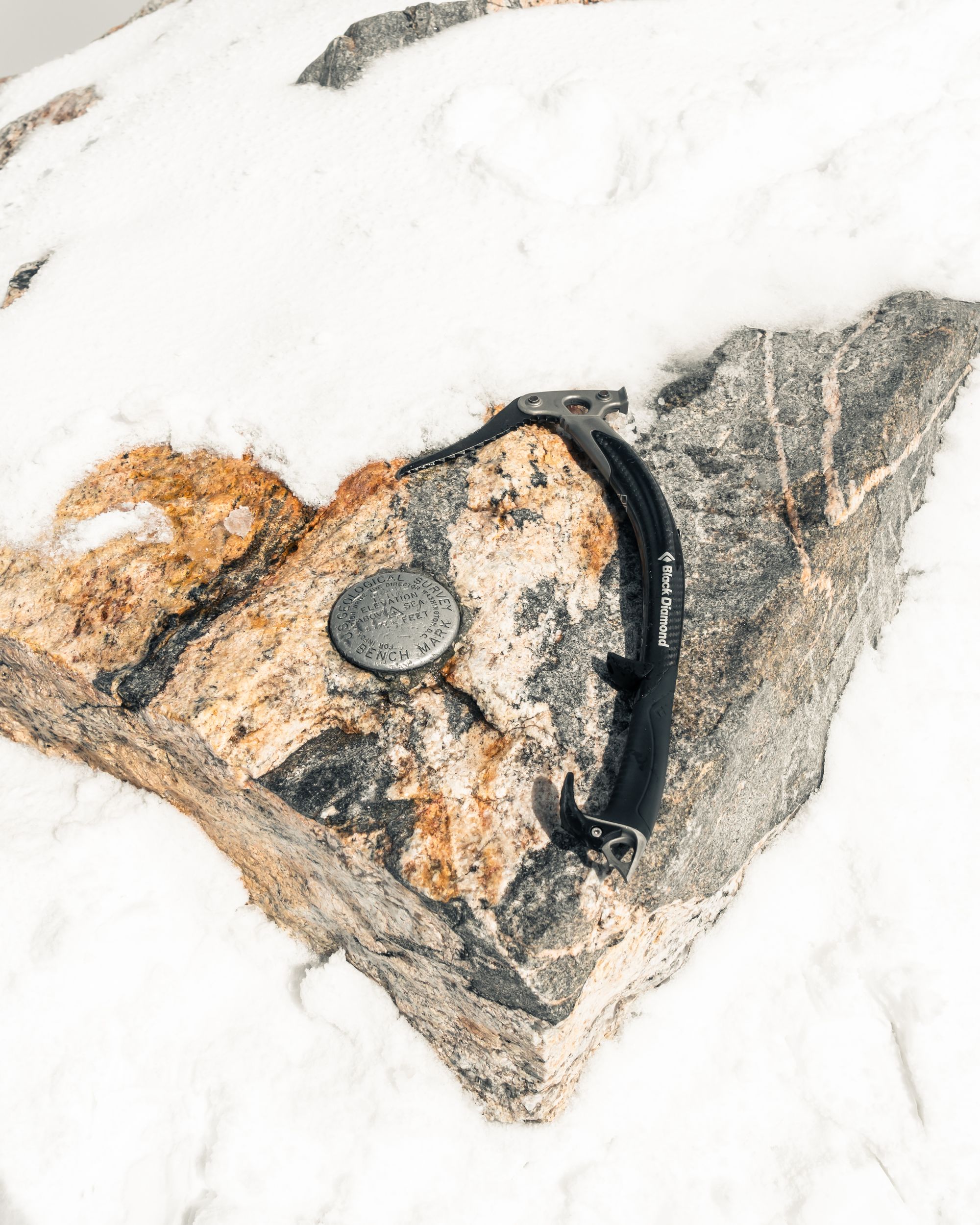


Grand Teton summit
Descending into the Clouds
Connor dropped first, linking up turns on a ski slope in the clouds. I lost sight of him as he dropped from the East Face into the steeper Ford Couloir.
I waited for Connor's call that he reached a protected pull-off. We planned to ski the Ford in 2-3 segments one at a time to minimize risk that sluff (loose snow) would sweep us off our feet. Clouds continued to dissipate, providing progressively clearer views of Middle / South Teton and Buck to the south.
I linked up secure turns to the choke mid-way down the Ford. It was definitely "corn-o-clock." In exchange for sitting in the Chevy traffic jam, Connor and I lucked out with enjoyable skiing.
Nearing the rappel anchor, "avalanche avalanche avalanche" rang out over the radios. Loose sluff hit group one on rappel. Rory and Sebastian were anchored, but Xavier was downclimbing after stretching the rope on a rappel. Thankfully, he found an alcove and protected himself with a hand jam. Too close of a call.
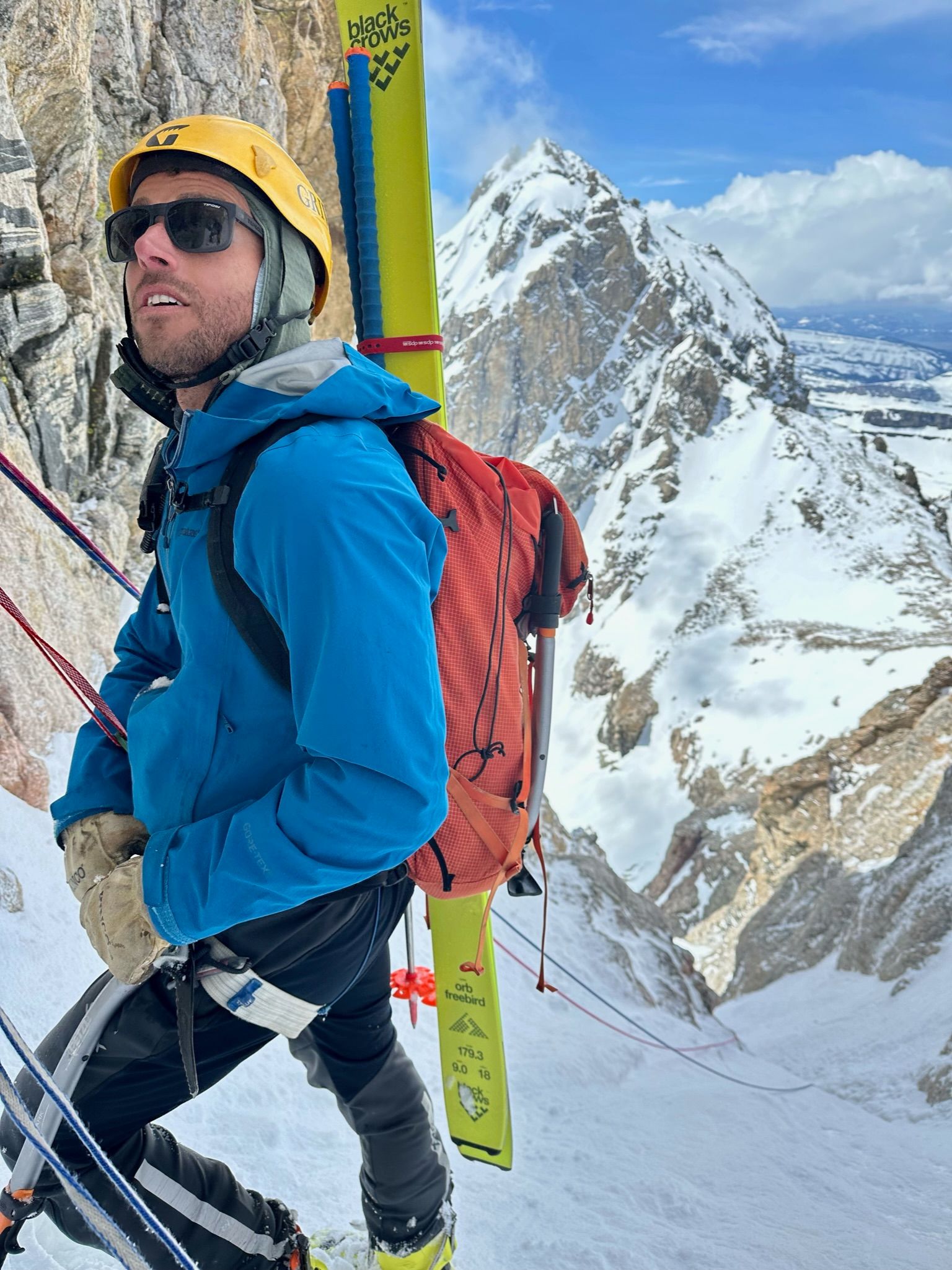
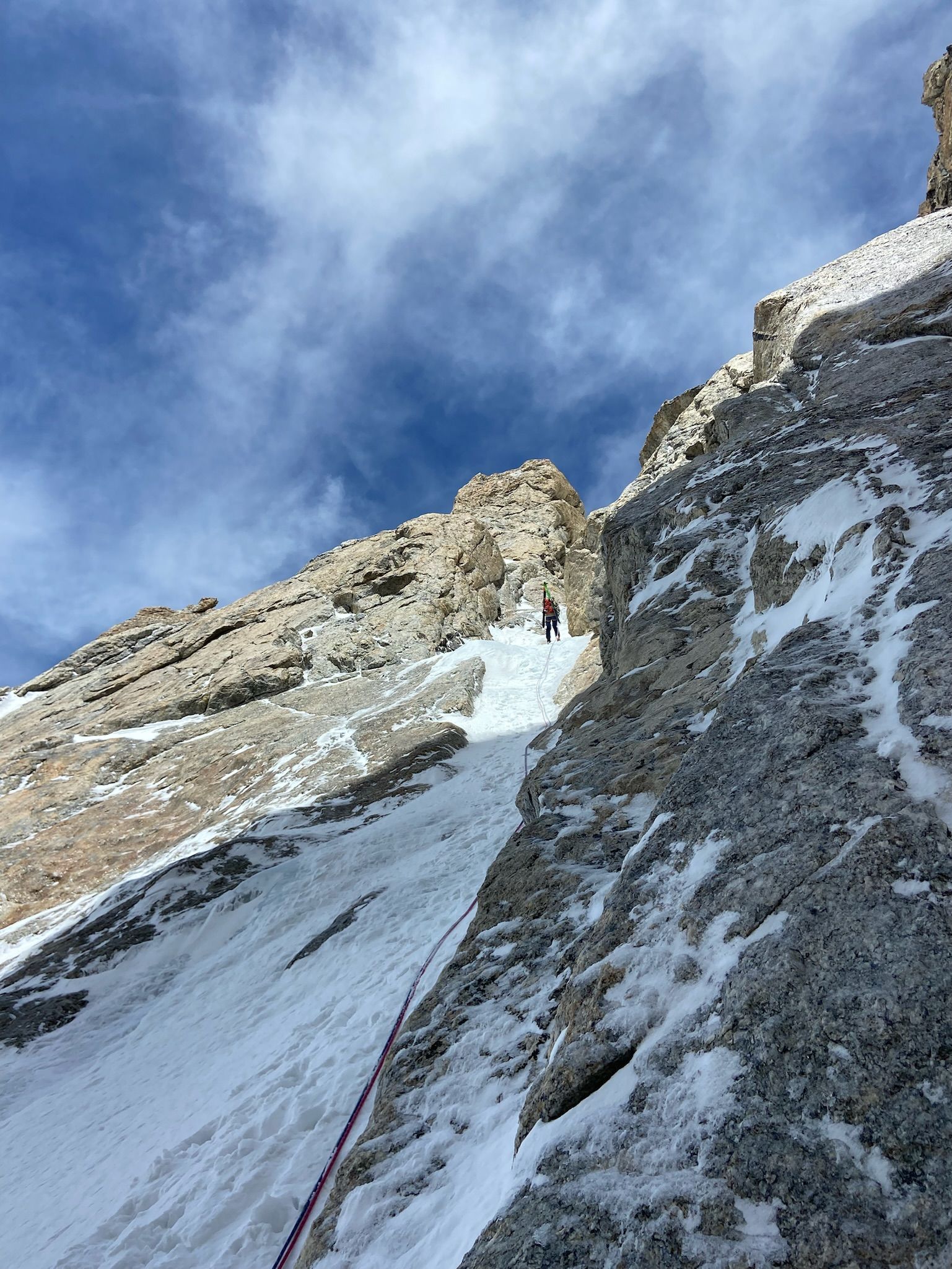
Group one rappelling below
From the amount of sluff group one described, it sounded like a release in the upper Stettner, maybe combined with some sluff from me / Connor. Downside of multiple groups on the Ford-Stettner – at least we were all on the same channel. (Here's an interesting suggestion to manage congestion.)
After pausing so group one could secure themselves, I skied to Connor at the Ford rappel anchor. The trickiest part of the descent was transitioning to rappel without dropping gear off the cliff below.
Connor tossed an extender my way, so I could clip my PA into the anchor. I also clipped my pack handle to reduce the odds of losing it. One-by-one, I removed my skis, handing them to Connor to jam in the snow to his left.

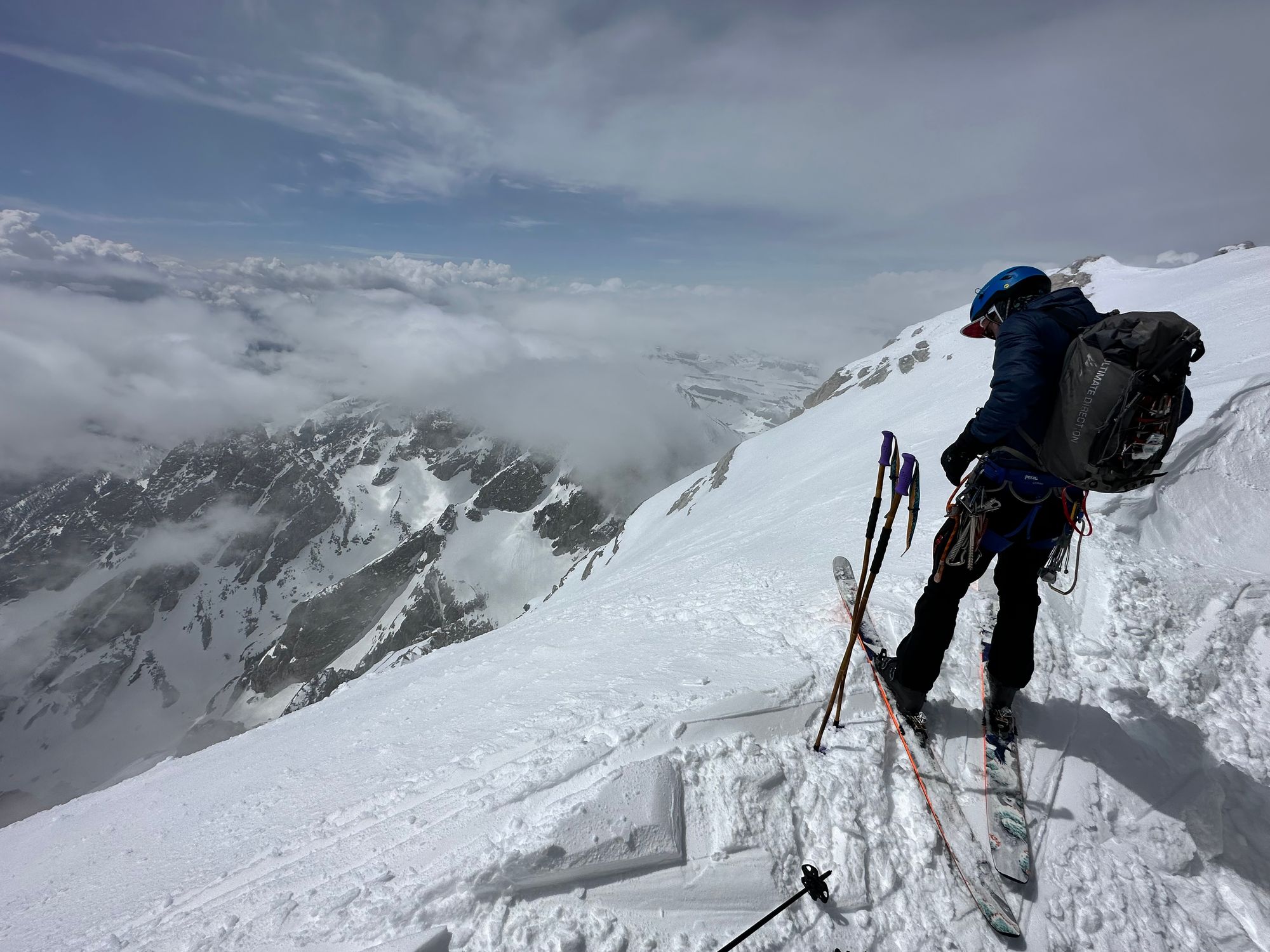
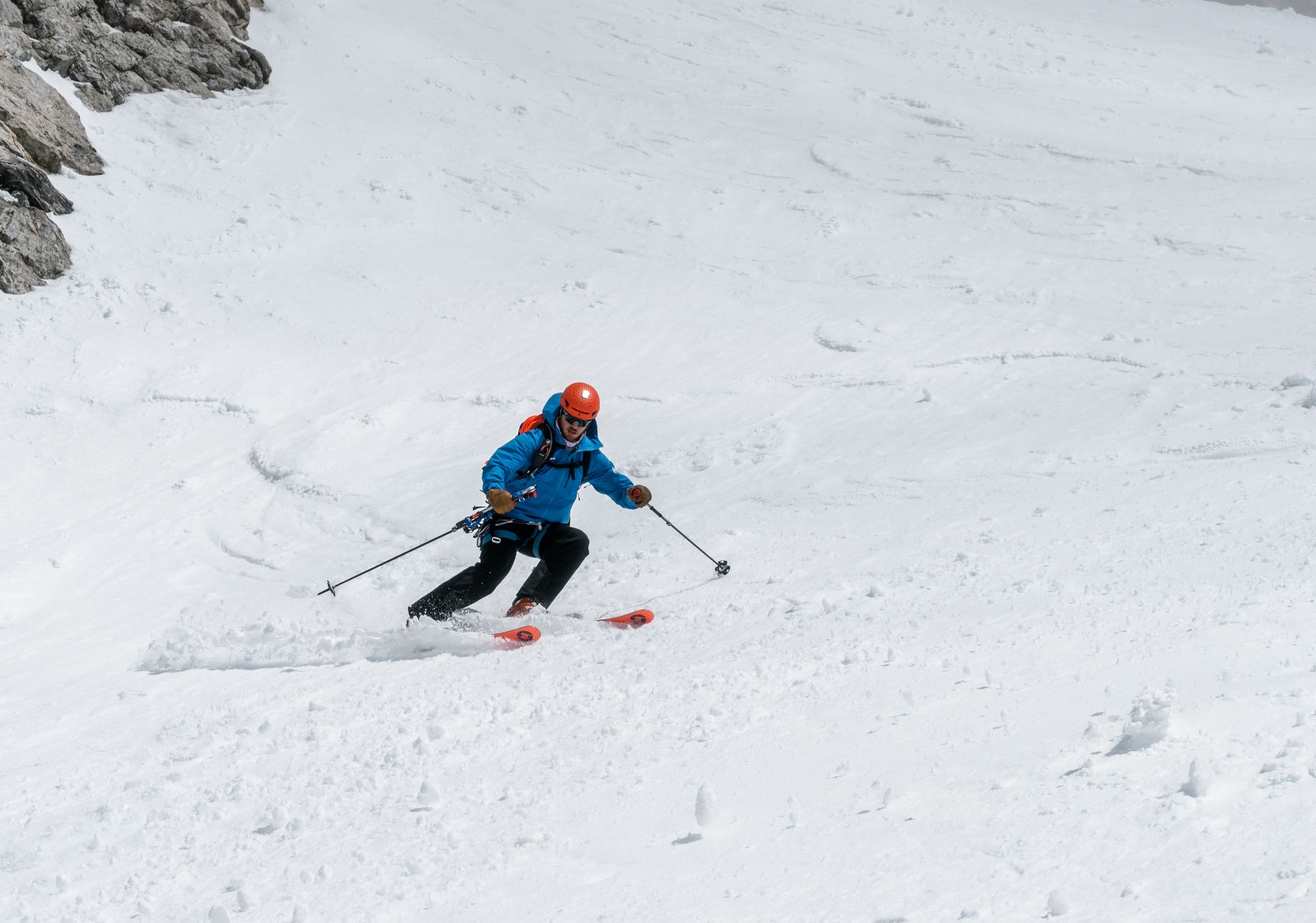
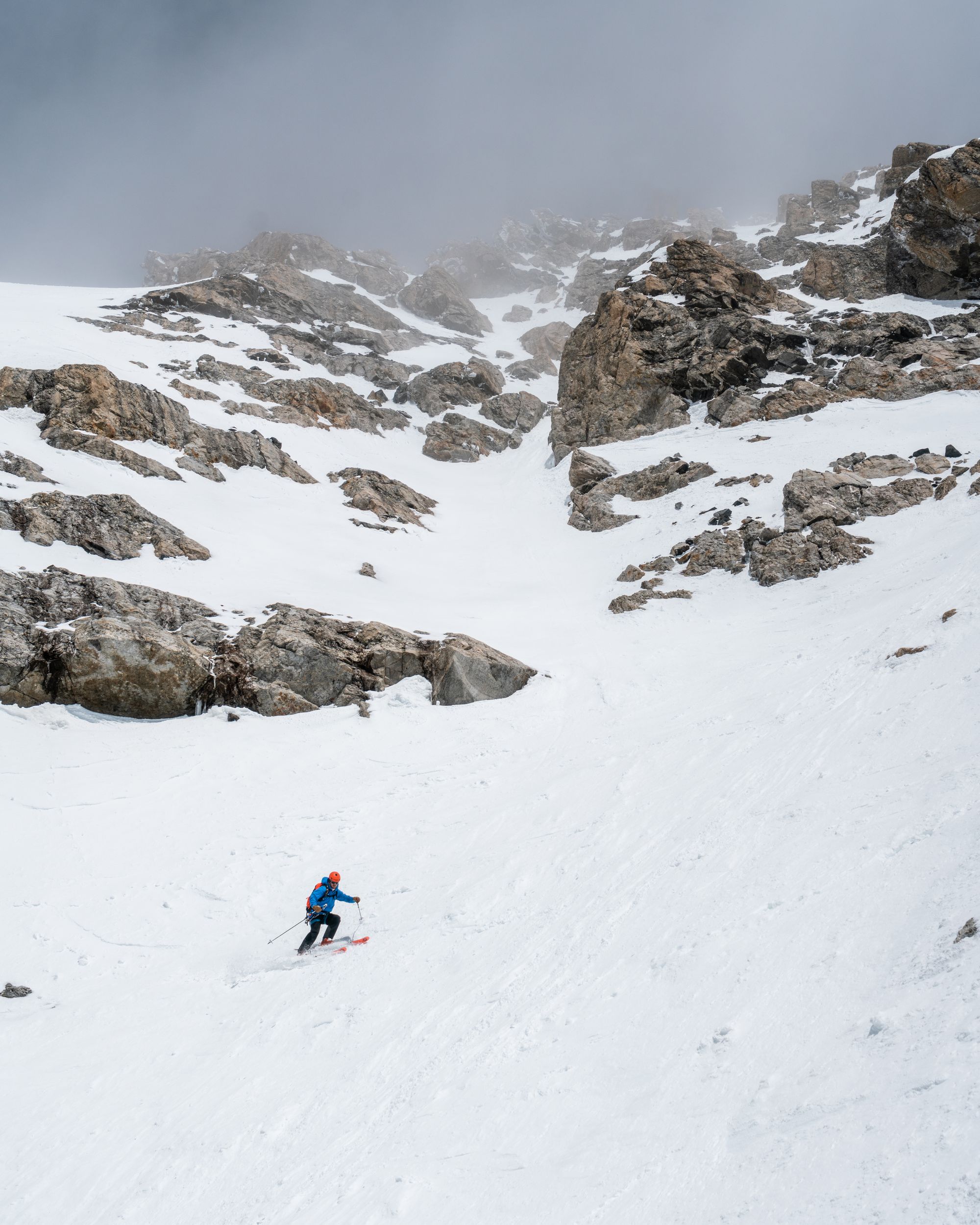
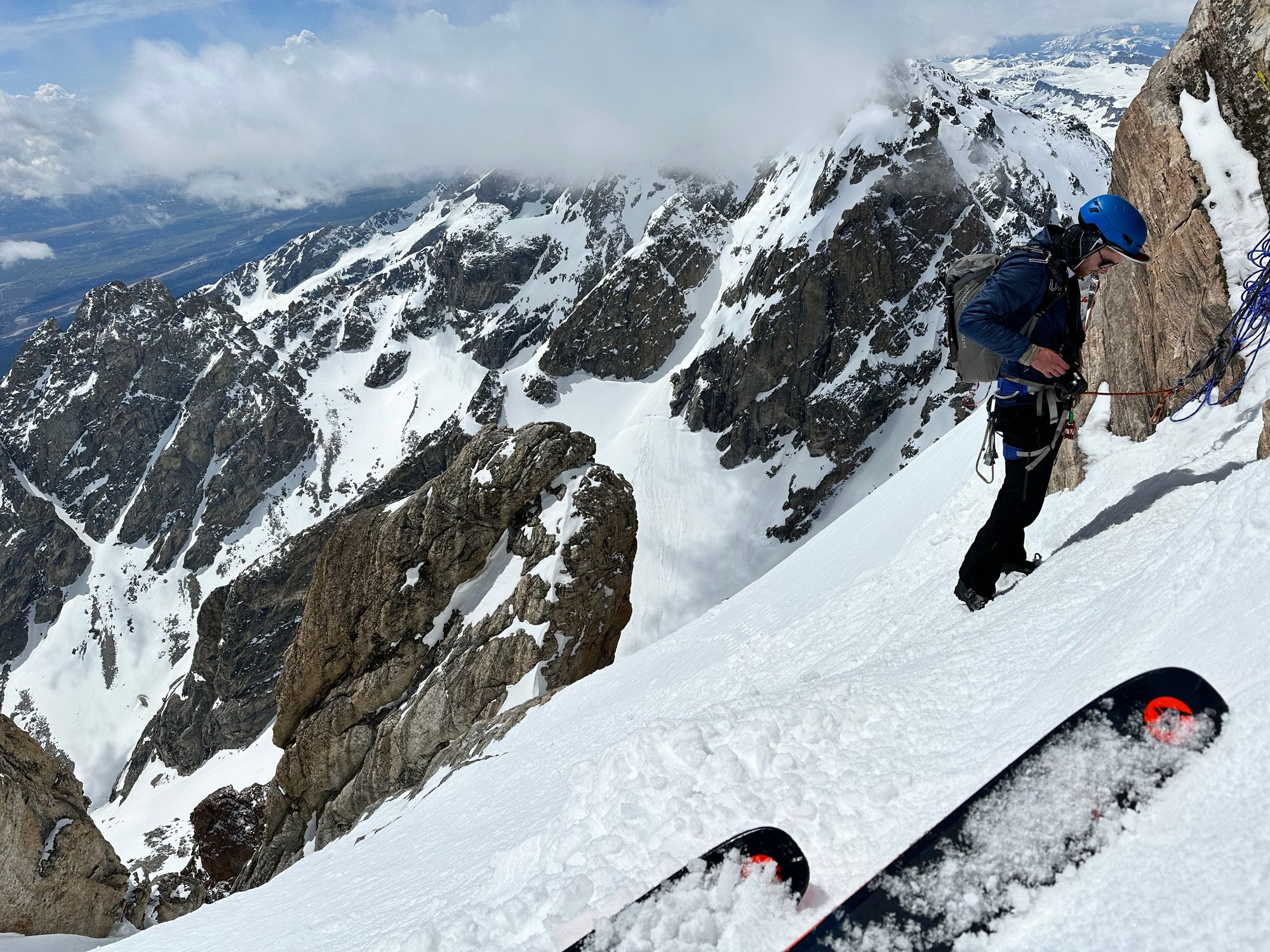
Ford Couloir ski descent, regrouping at the rappel anchor (bottom right)
Rappelling with skis might've been easier at this stage. But, we would've struggled to reach a few high rappel anchors, through the choke and over some rock.
We reached the base of the Stettner in 5-6 rappels using two 60-meter ropes. 3-4 rappels should've sufficed (confirmed by group one). Tiring on ascent, we hadn't memorized anchors, and Connor played it safe, rather than stretch the ropes. We set new rappels at each solid, accessible anchor he found. A group with a single 45 to 50-meter rope could've accomplished a similar schedule with slightly more skiing and downclimbing.
By the time we reached the base of the Stettner, it was warm. My leg loops had rubbed my sun-poisoned thighs raw, so I was grateful to ditch my harness. We could see the East Face of Middle Teton, and its intimidating exposure, to our southwest from our perch next to Glencoe Spire.
We pulled our ropes from the last anchor in the Stettner, struggling against some resistance. When the ropes finally released and we started butterfly coiling, Connor noticed a nick in my brand-new half rope. (Reorganizing the next day, I'd be relieved to find it at 10 meters, leaving me with a salvageable 50-meter rope.)
We strapped ropes to our packs and traversed east to the top of Teepe Glacier. We transitioned to ski (hopefully) all the way to the trailhead.

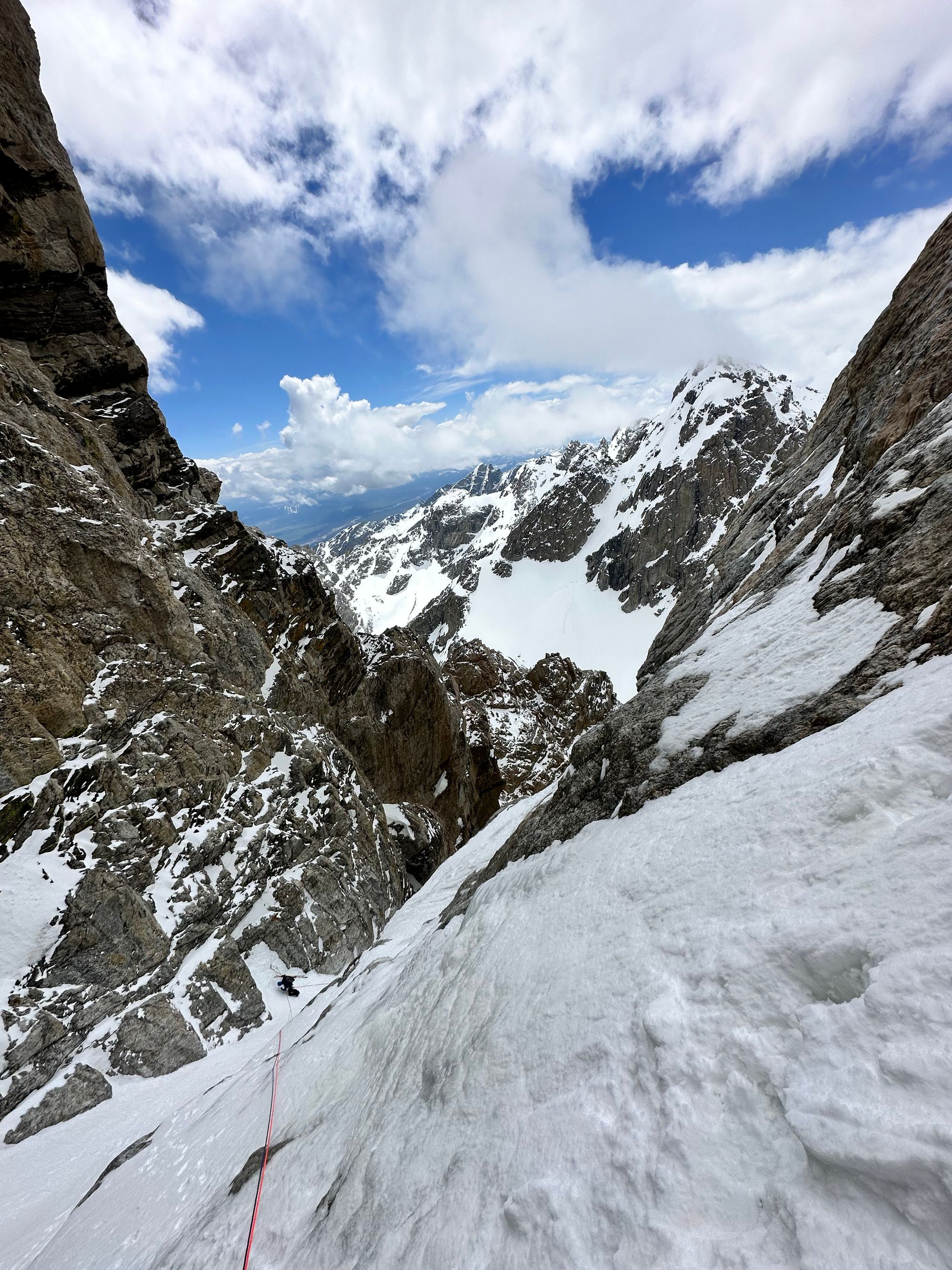
Stages of Chevy-Stettner rappels
Slush, Rain and Creek Crossings
At 2:30pm, Connor dropped onto Teepe Glacier, now a mushy mess. We planned to scout an exit via Dike Snowfield to Delta Lake. The shade from Disappointment Peak might preserve more snow than in lower Garnet Canyon.
Aware of heightened wet-slide risk, I waited for Connor to reach the bottom before I skied. We each watched the other's descent. Lacking recent beta on Dike Snowfield, and unable to observe much from its entrance, we stuck with the devil we knew. We would aim for lower Garnet's north-facing aspects.
The slush was heavy, but consistent enough to ski comfortably. We didn't witness any significant instability. We cruised through Garnet Canyon, pausing near the boulder fields to shed a layer. We followed tracks (likely from group one) on the north-facing (or south) side of the Garnet entrance.
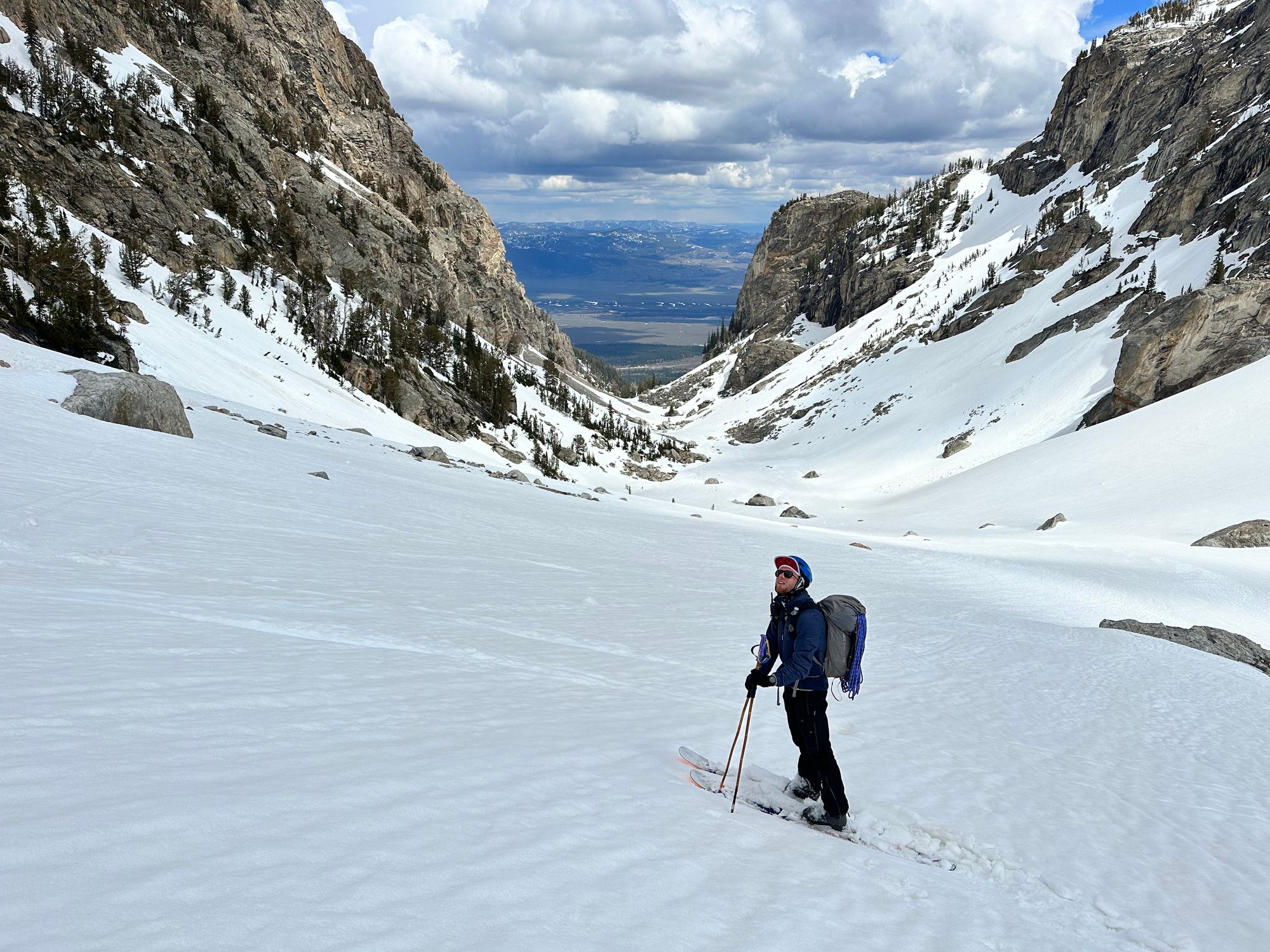
The bet paid off, up until a dead-end on a cliff above Bradley Lake, a mile or so south of the summer trail. Frustrated and increasingly delirious, we walked in a couple circles, then debated left (Connor) vs. right (me).
Connor insisted we head north, crossing Garnet Canyon Creek and then hiking across a muddy hill to reach the ridge bordering Burned Wagon Gulch. My brain didn't connect the dots to our pitch-black ascent, but he swore that path would return us to snow we skinned from 1-2am.
I stood in the shelter of pine branches as an afternoon rainstorm washed some of the mud off my boots, then acquiesced. I followed Connor over a ski-width snow bridge to the other side of Garnet Canyon Creek, shouldered my skis for one more muddy boot-pack and kicked my way through sagebrush.
At the top of the ridgeline, as Connor promised, we found snow and transitioned to ski again. We powered through 45 minutes of (mostly) low angle skiing, plus shuffling, pole pushing, log hopping and some mud / grass gaps. Somehow, Connor recognized the waterfall that stole my headlamp 15 hours earlier. For the final, flat half mile, we went "Nordic" – free heels, no skins.

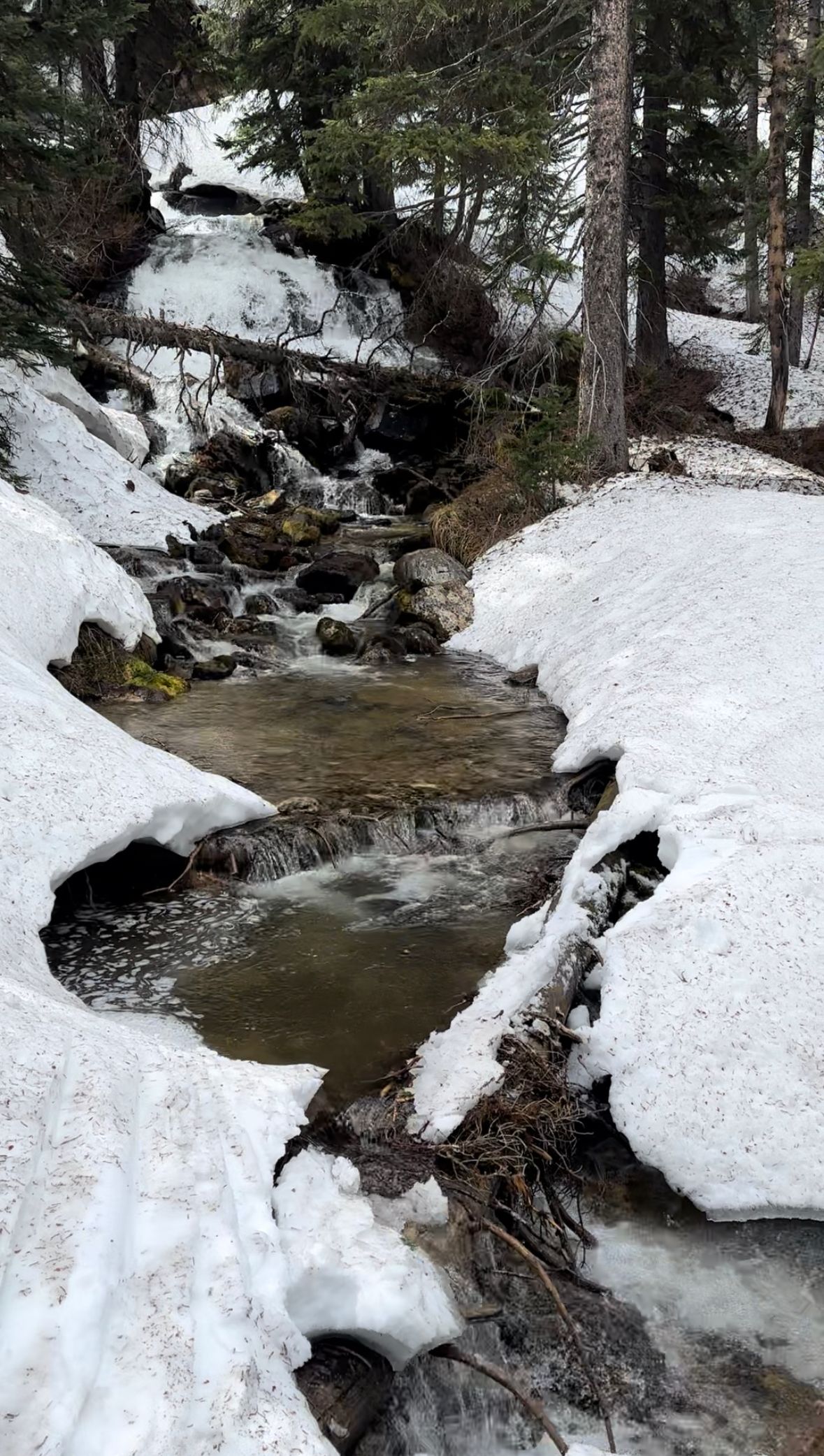
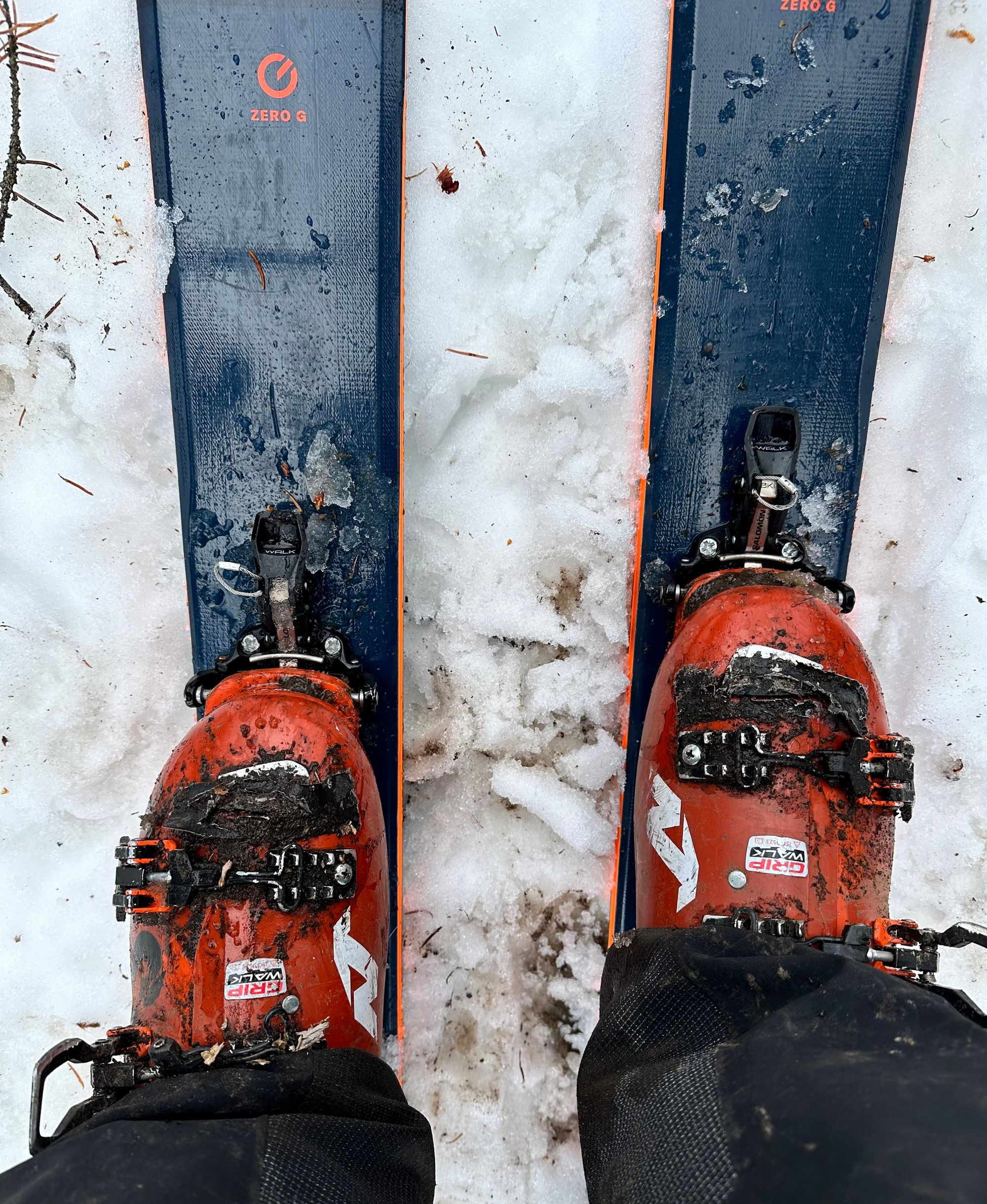
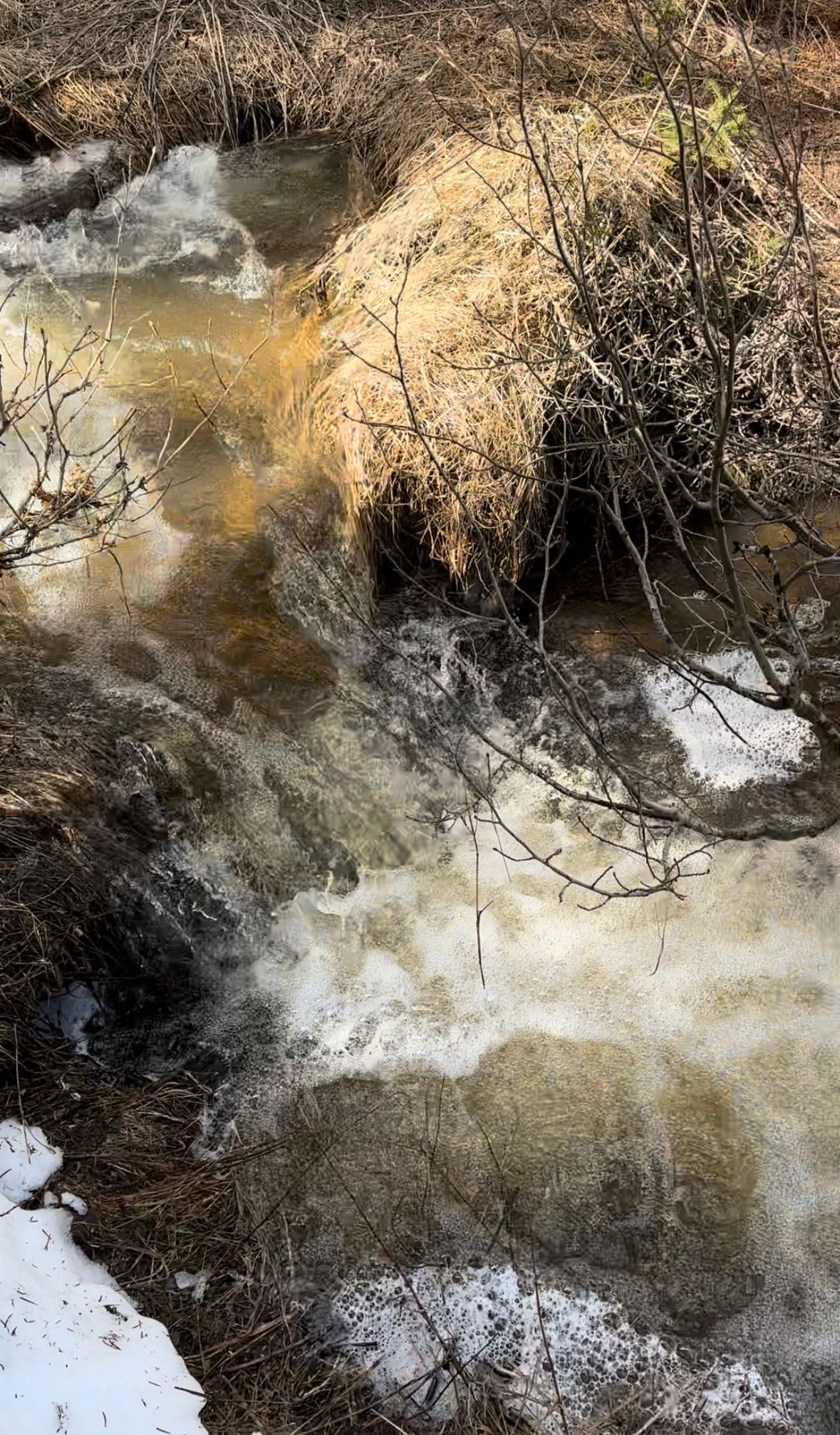
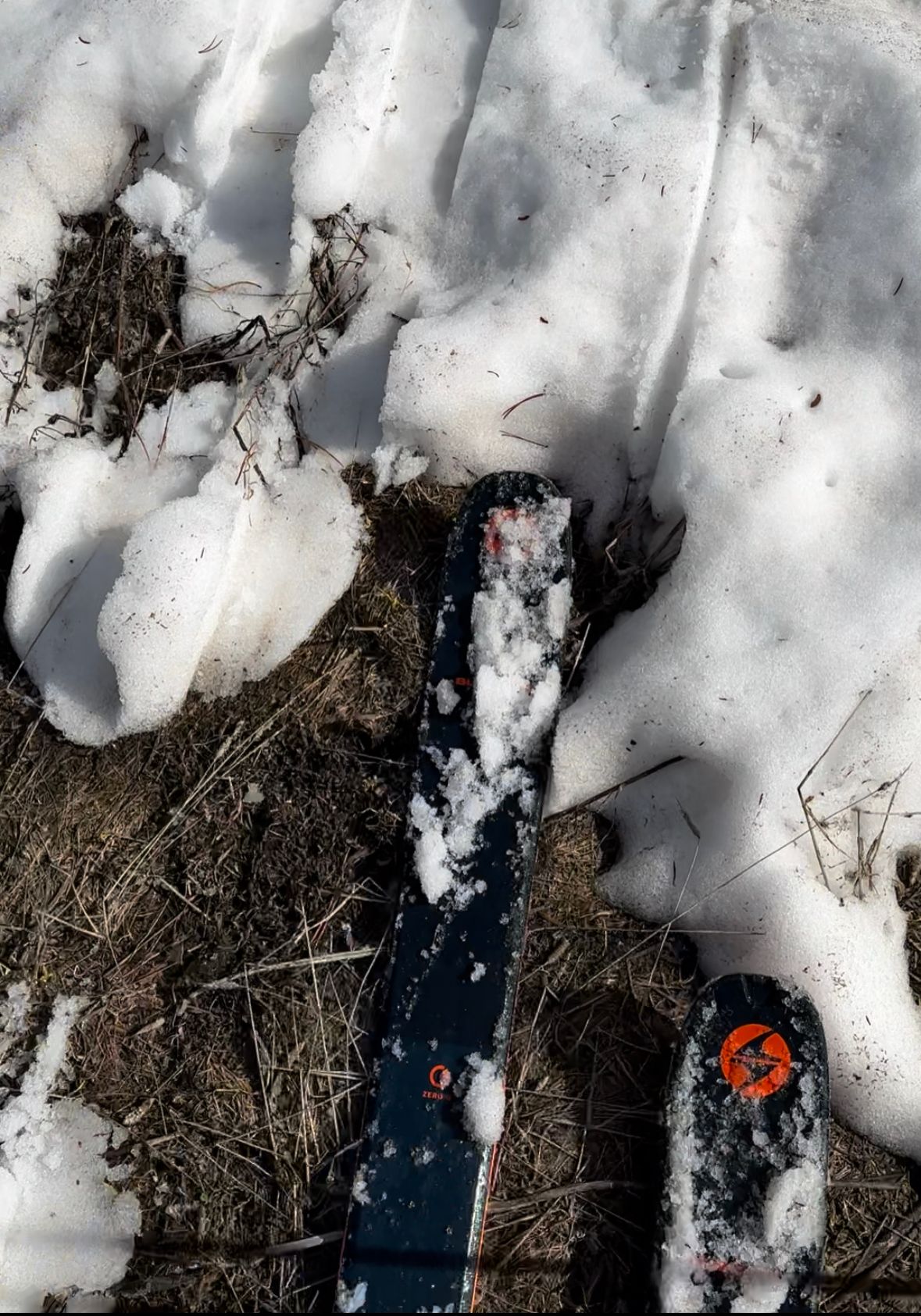
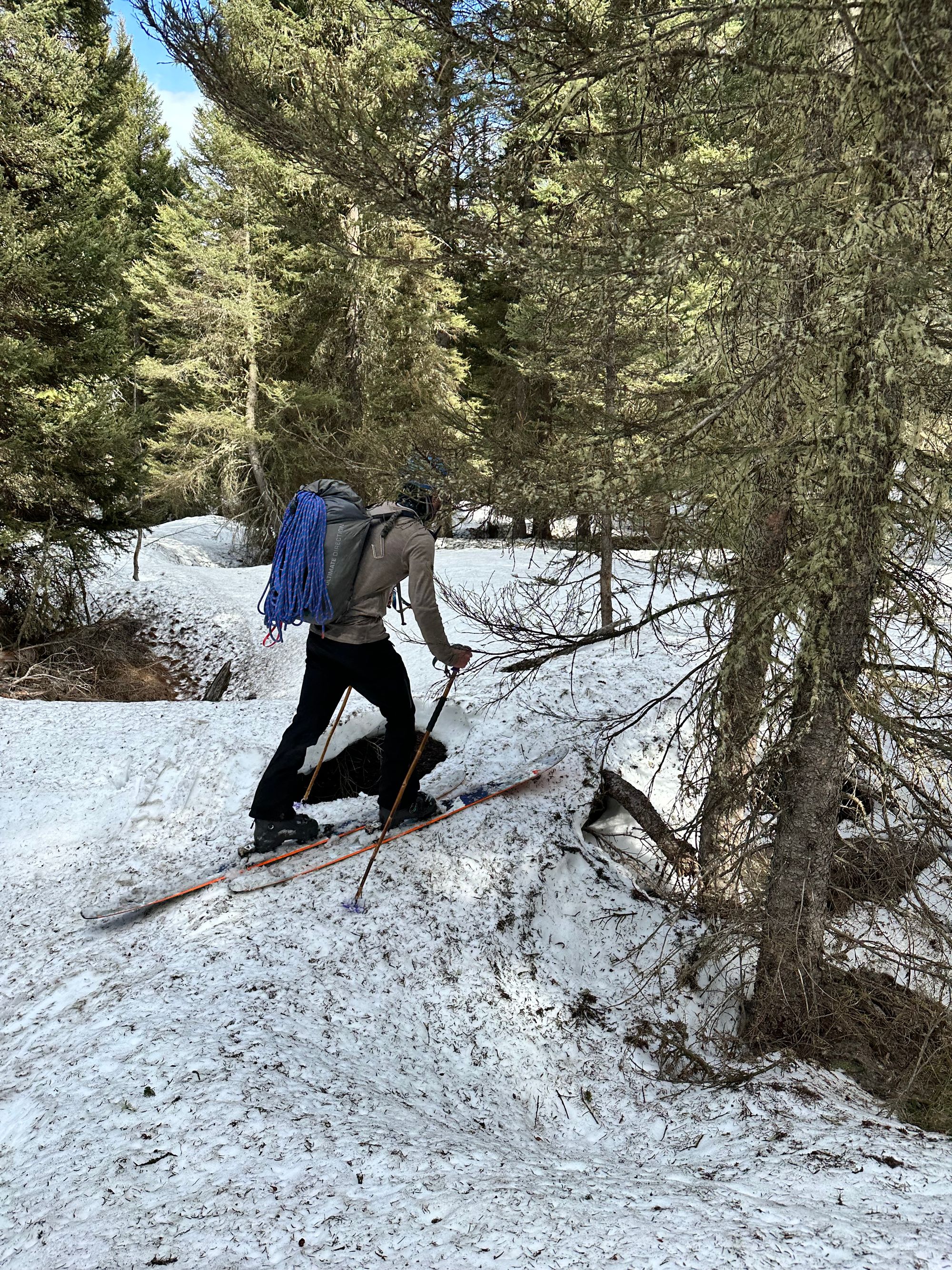
Stages of our descent
Just after 5pm, we spotted the Homestead, shouldered our skis one last time and stumbled the remaining quarter mile to my truck. Gentle steps minimized further blistering from our hybrid ski boots. After a few rounds of learning-the-hard-way (e.g., Table, Skillet and Williamson), I'm buying dedicated touring boots.
We looked back at the Tetons. The Grand ducked in and out of the clouds. Connor was so tired he took a commemorative picture of the wrong mountain – Teewinot. We tossed gear in the back of my Tundra and swallowed a few handfuls of emergency Jelly Beans. We split a slice of pepperoni pizza we'd forgotten amidst midnight rain.
I pried ski boots off blistered feet. Not wanting to further aggravate the raw skin, I drove home barefoot. Sometimes seeing double, I mistook shadows on the road for elk and bushes for stop signs. By 6pm, we were safely parked outside my house.
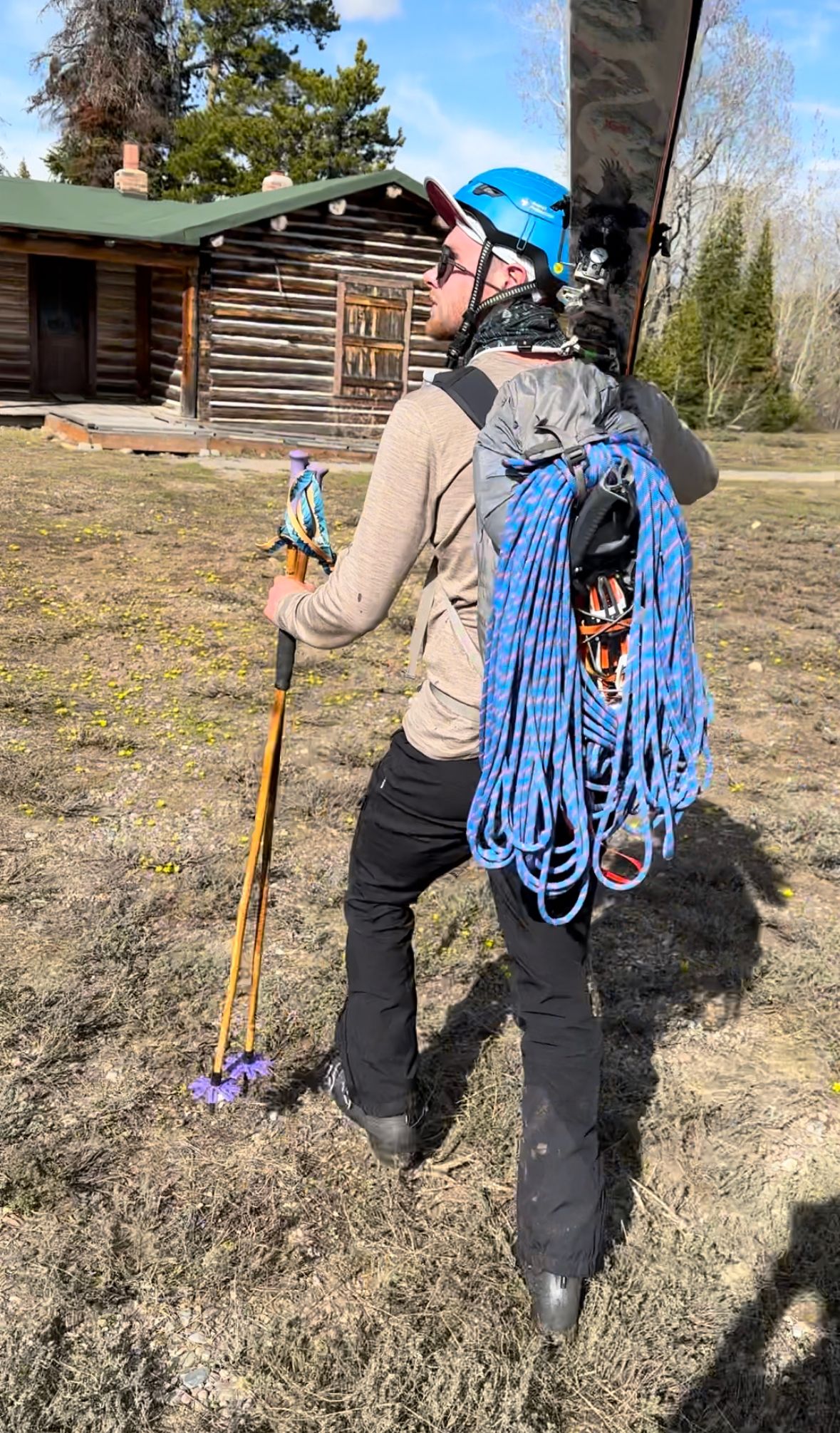

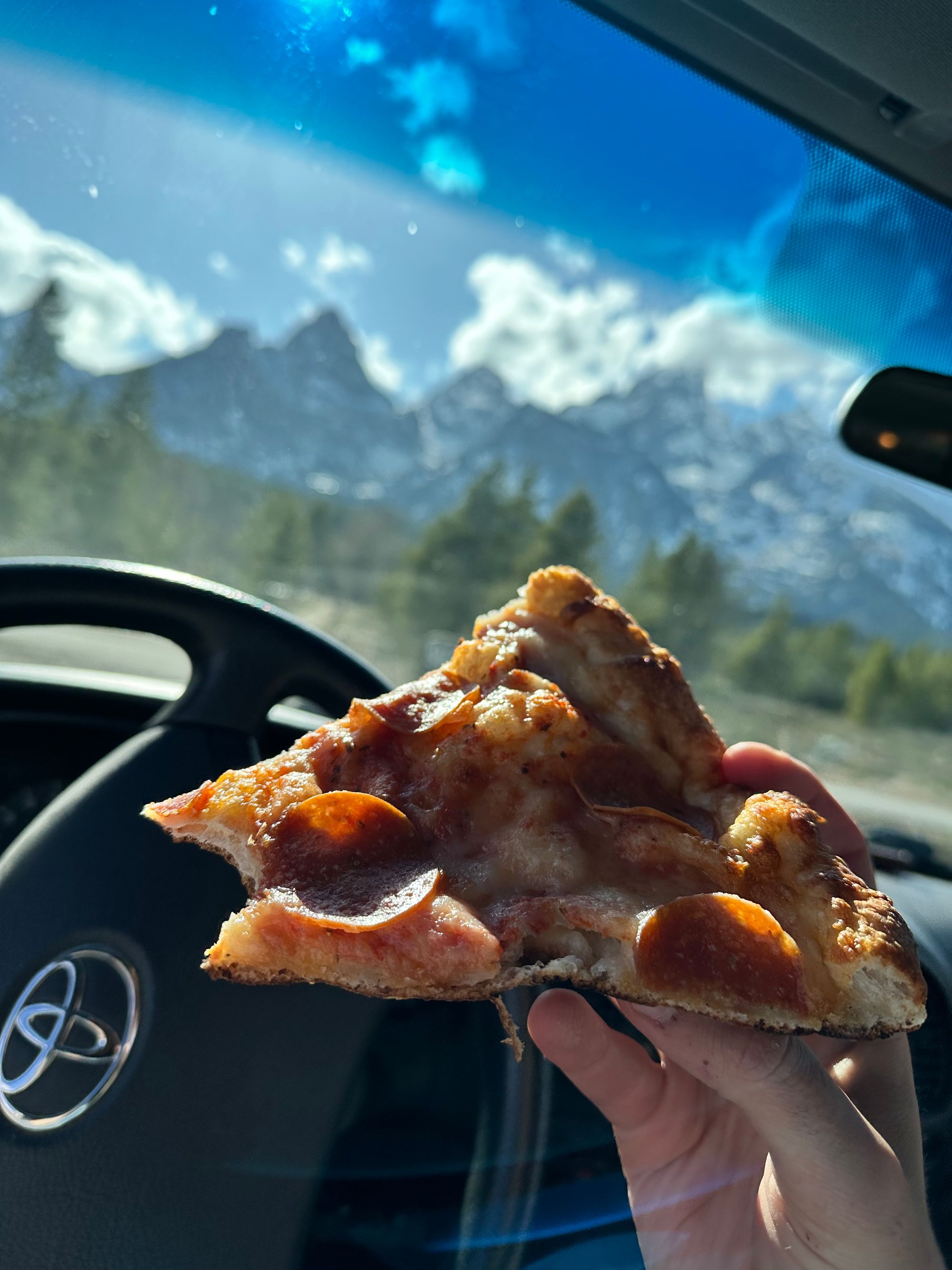
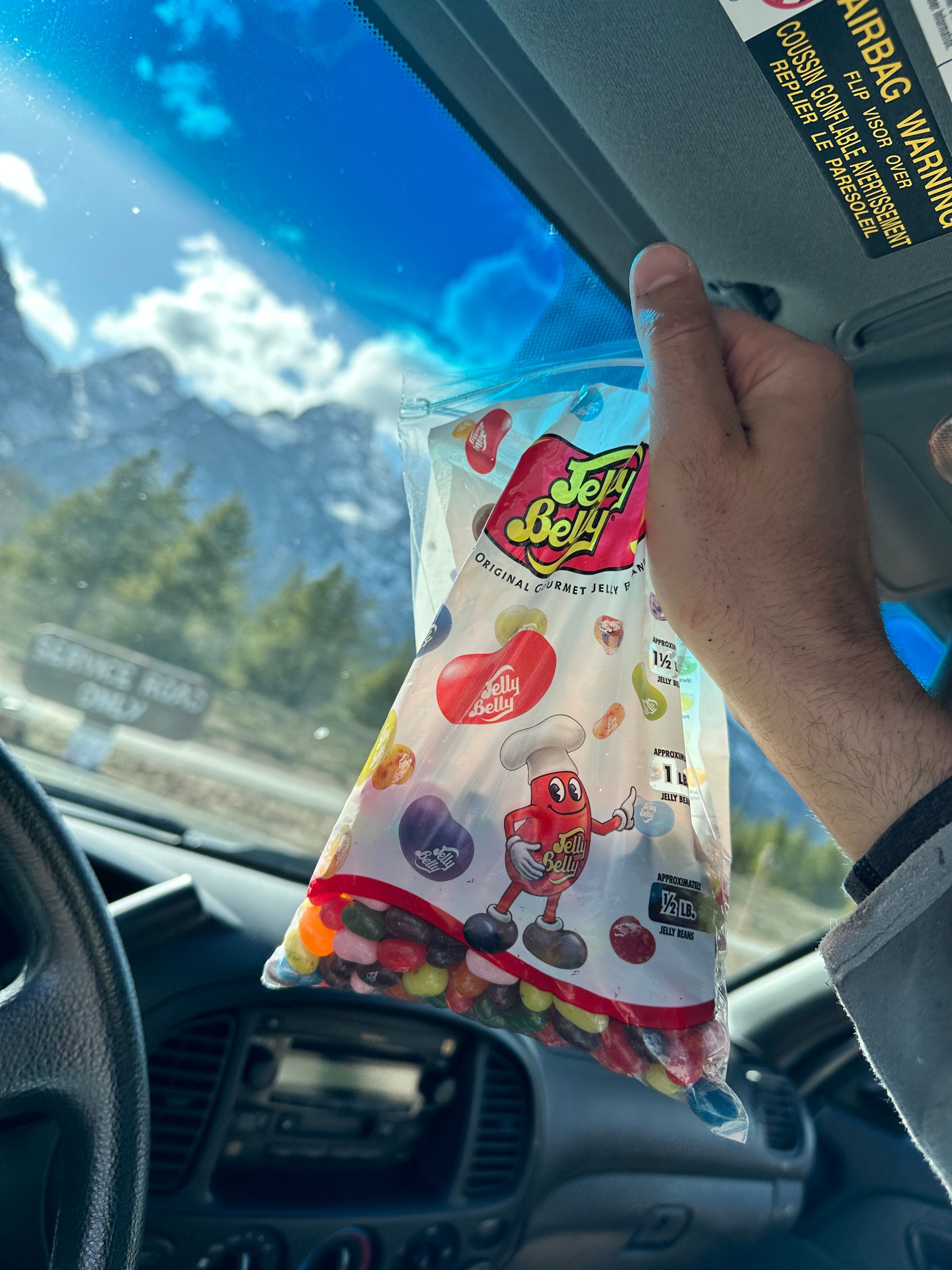
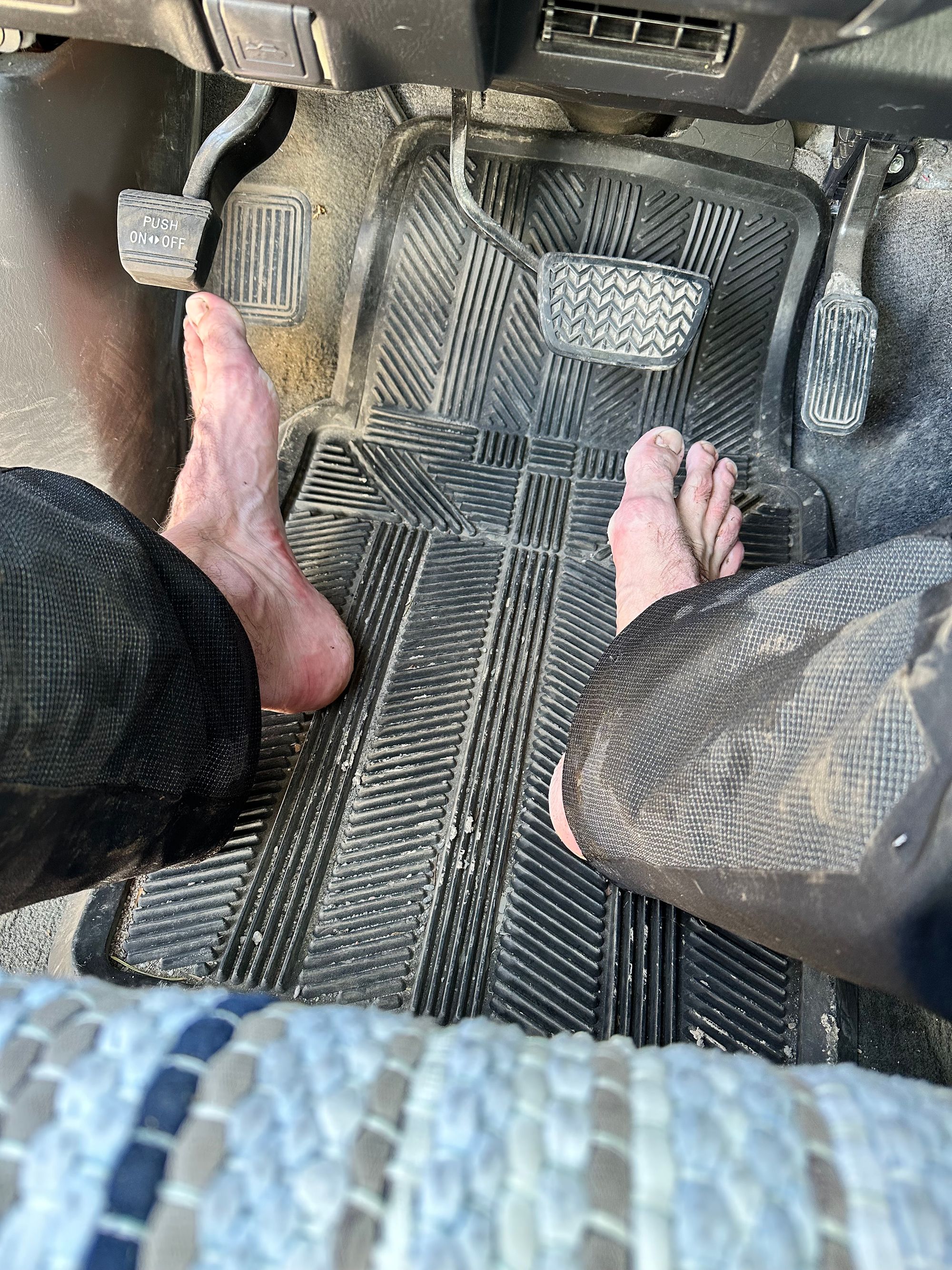
Homestead and trailhead
Cowboy Bar Burgers and Tan Lines
The last we heard from Xavier, around 4:30pm, he asked if we'd seen Sebastian. In their rush to catch Rory's 4pm flight, Xavier and Rory skied ahead.
At 6:30pm, we finally reconnected with Xavier. Rory was in the air and Sebastian made it to his car. Sebastian started the 13-hour drive back to Bend, but he'd pull over in a couple hours (if that long) to nap.
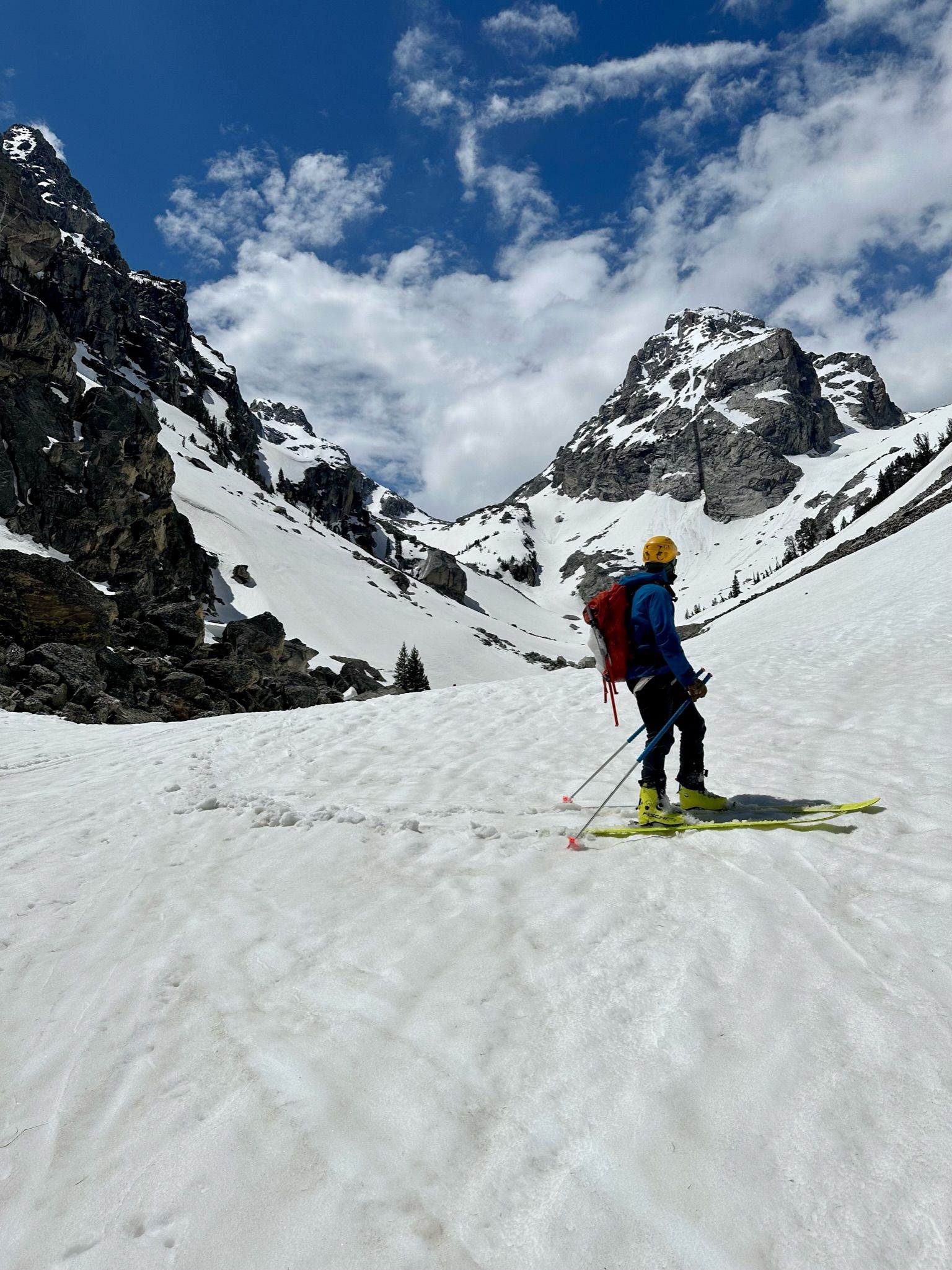
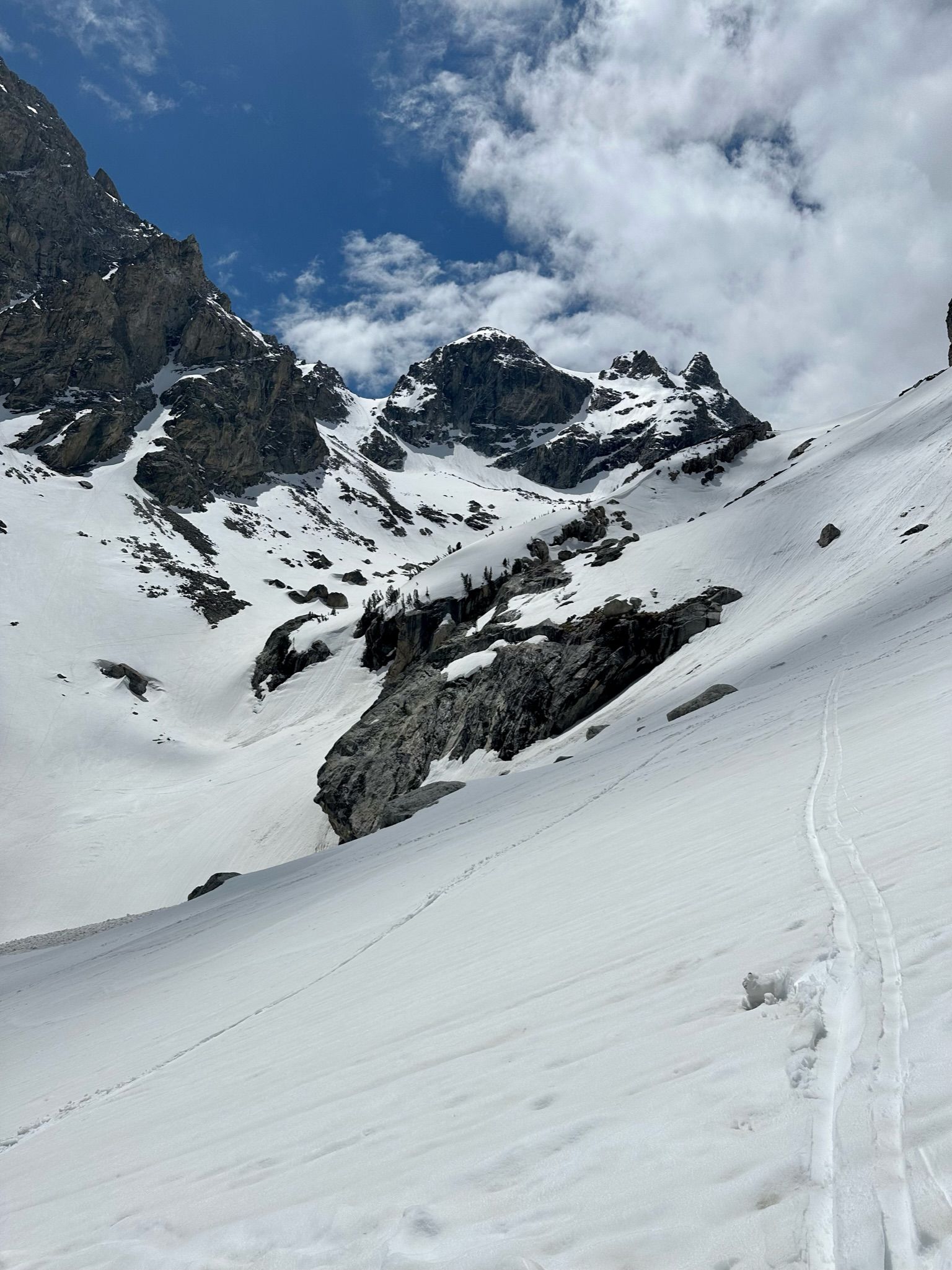
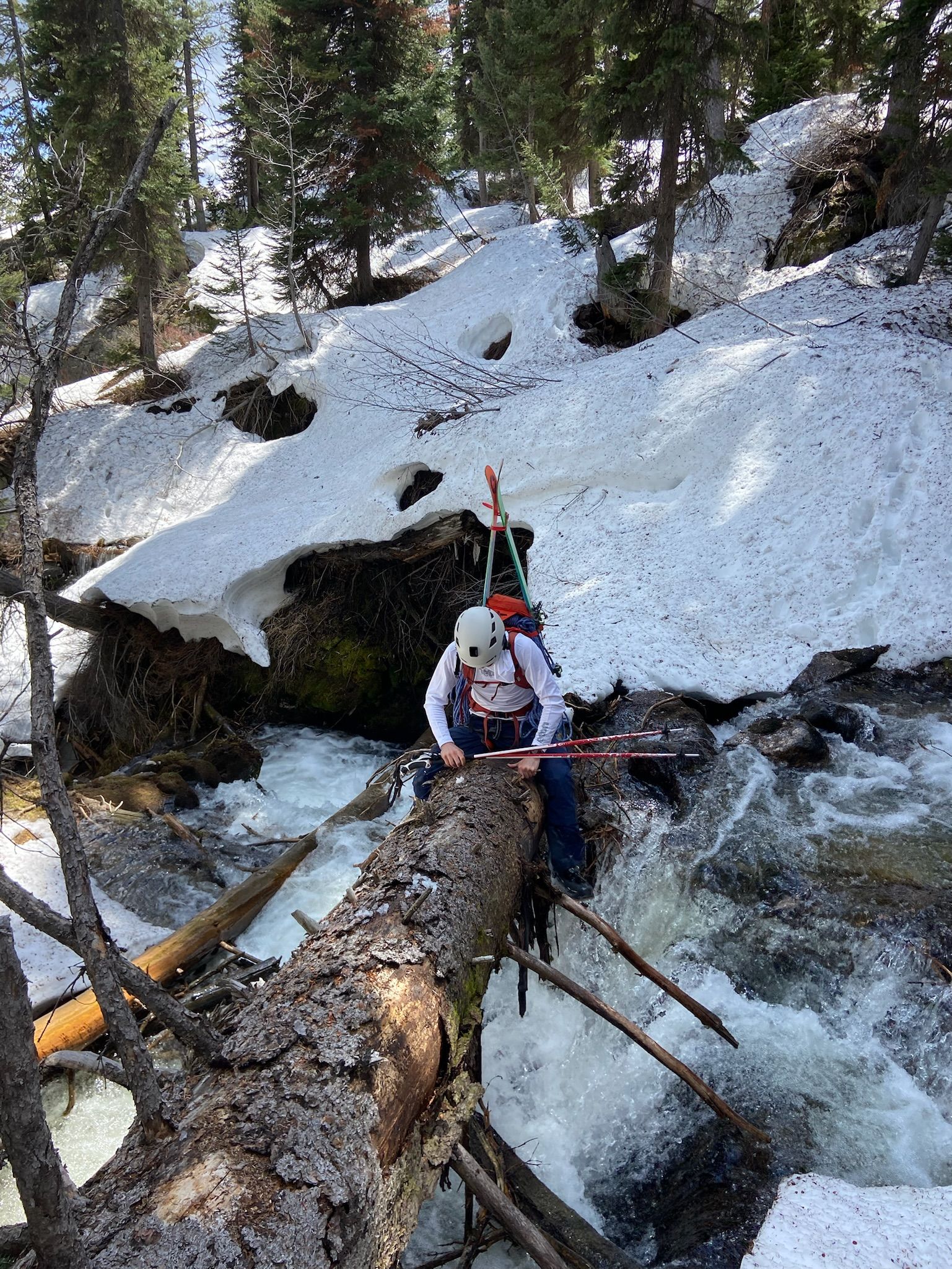
Stages of group one's descent
Xavier, Connor and I stumbled into the Cowboy for celebratory beers and burgers. Even after Jelly Beans, pizza, a burger and (bonus) cheese curds, I couldn't keep my eyes open. After an ~hour, we limped home and fell into comas. My roommate, Chelsea, described us as "dirty zombies" (paraphrasing, again).
Xavier woke up at 8am and left for Bend. We originally planned to bag a few more Teton classics on his trip, but were gassed. After a long ski season – for me, starting in early November – I was ready to end on a high note.
The next morning, Tuesday, I rinsed mud from boots, skis and poles in my shower. I cut, taped and burned the ends of my new 50-meter and 10-meter ropes.
I reorganized crampons, ice tools, the climbing kit, Rocky Talkies and emergency supplies, etc. Summer gear in my vest pack. Everything else in my touring pack and ski bag, hibernating until next winter.
I applied moisturizer to my blistering thighs and face. A tan line wrapped around my head and neck, the closest I've been to a bowl cut since my Dad cut my hair in middle school. (Bald dude problems.) With two strips of medical tape, and a day of healing, I forced my feet into loose running shoes.
After a few days cursing the sport of "ski mountaineering," pervasive Denali thoughts won out. I tested the group's appetite, and feeling enthusiasm, set a calendar reminder for January 1st, 2024: the day permits open.

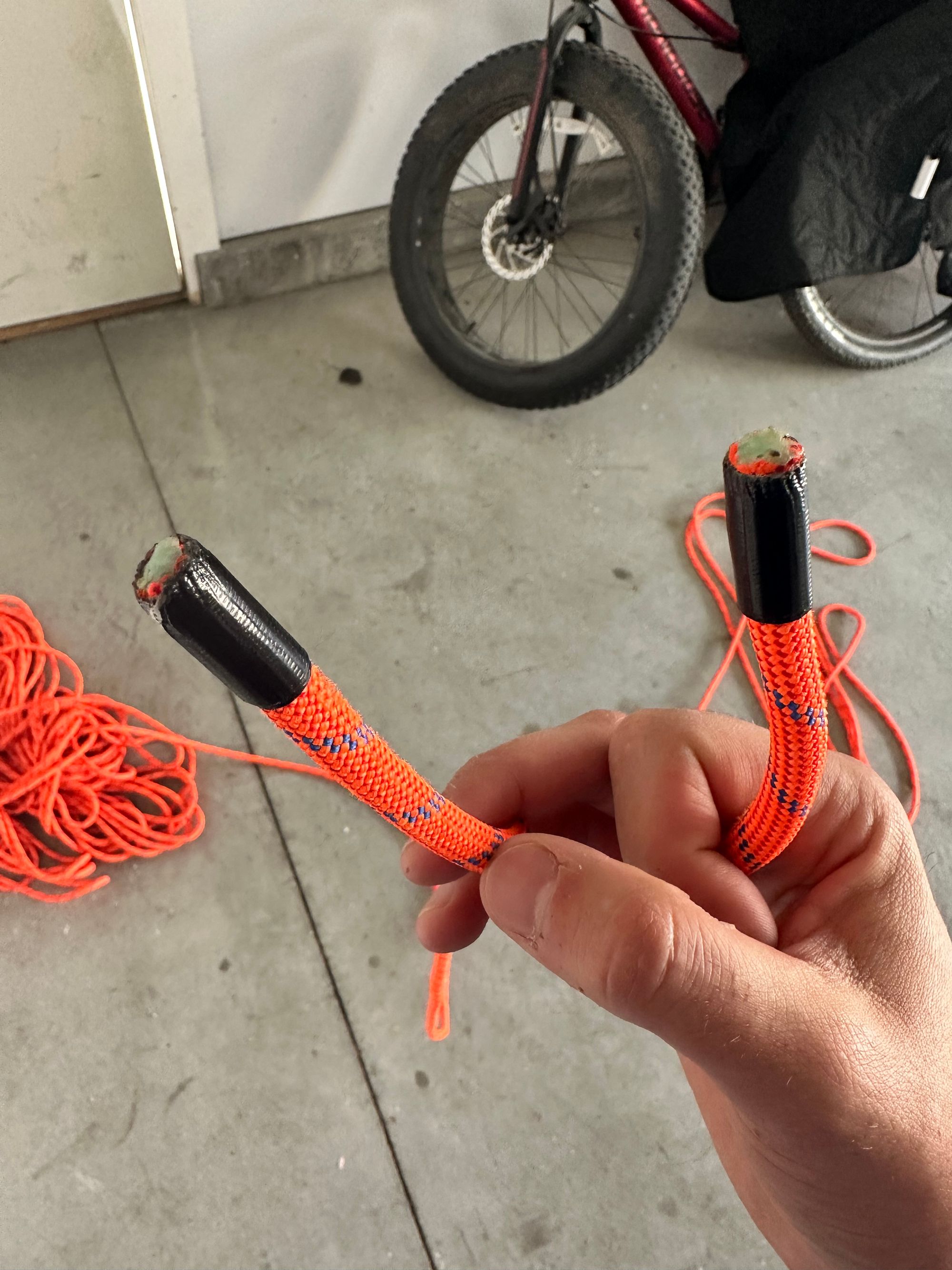

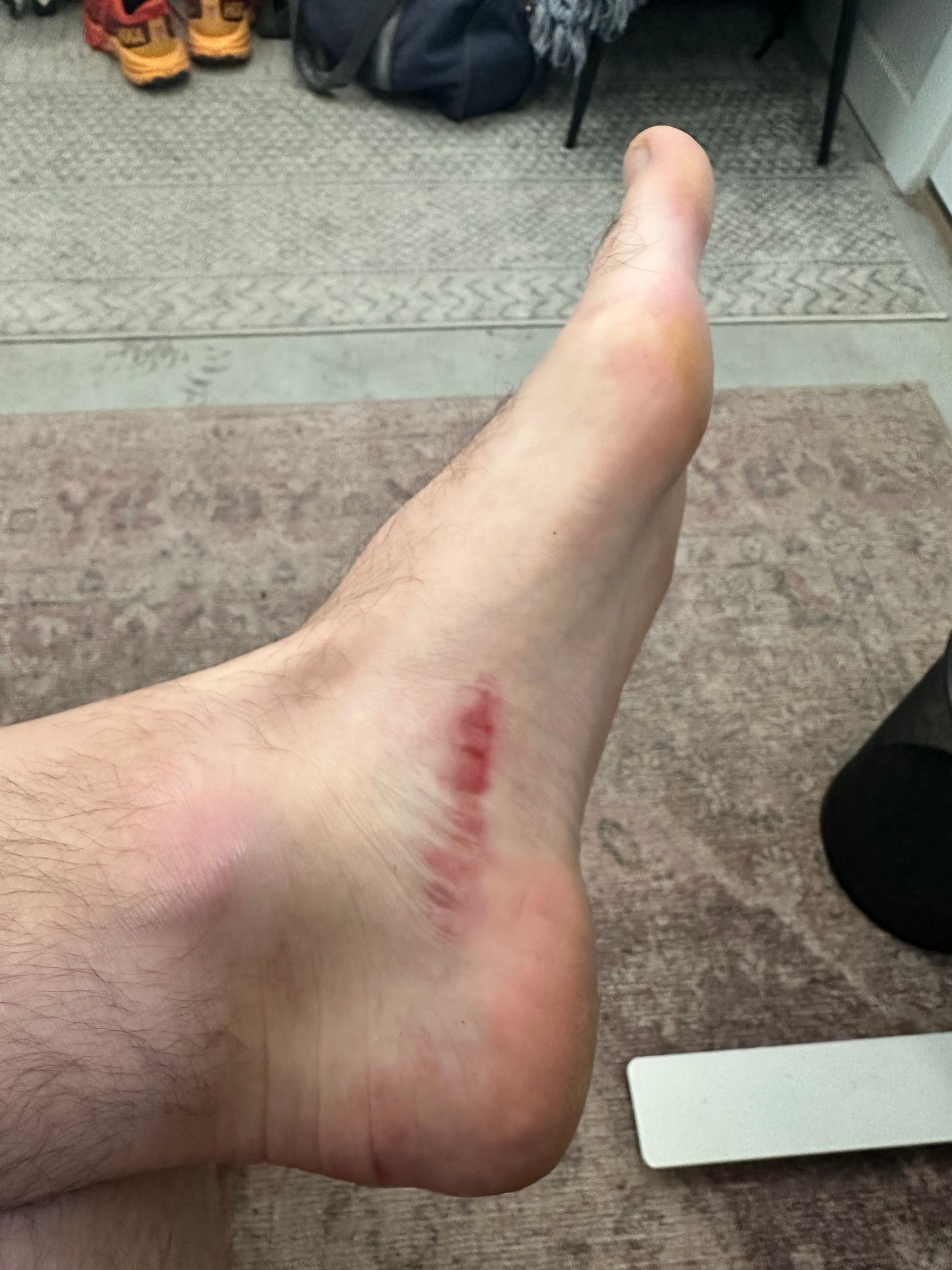
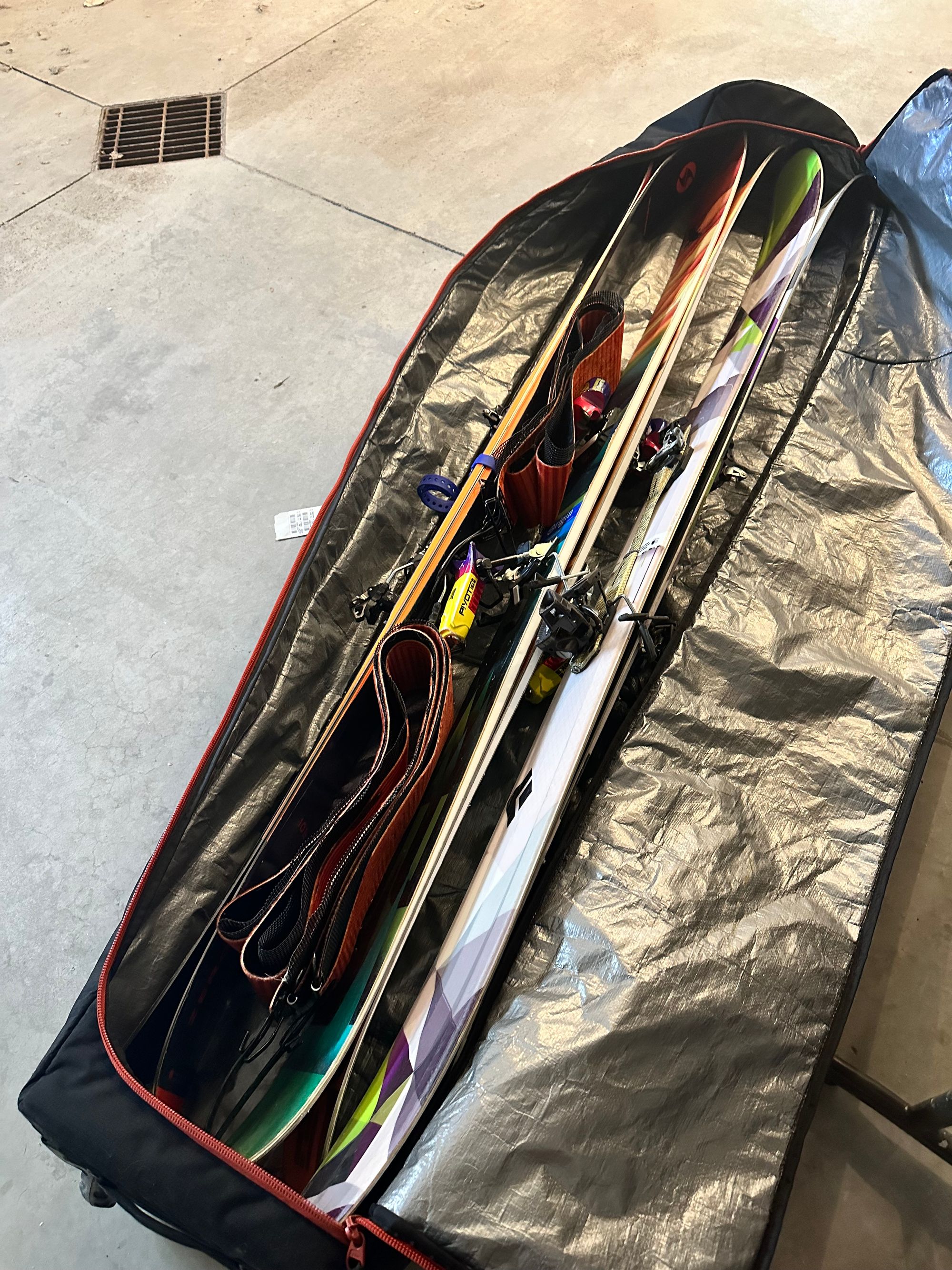

Assessing the damage, packing up and looking forward to 2024

